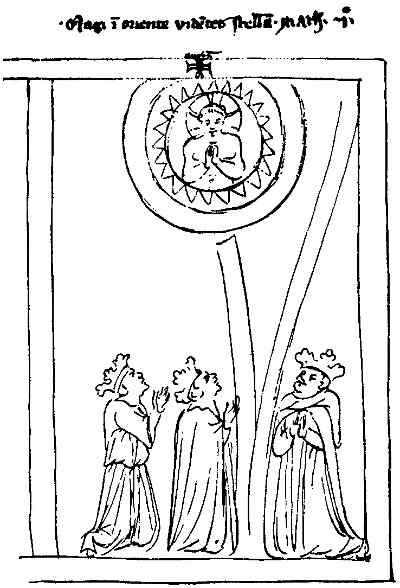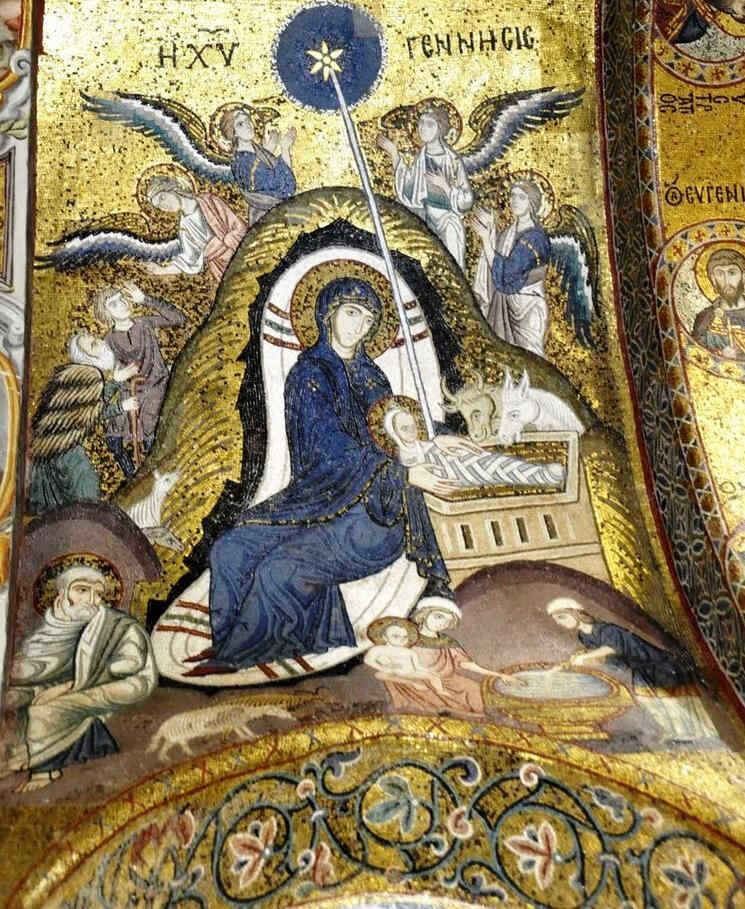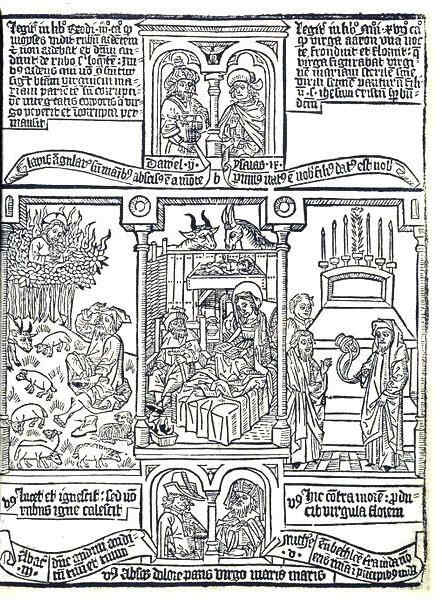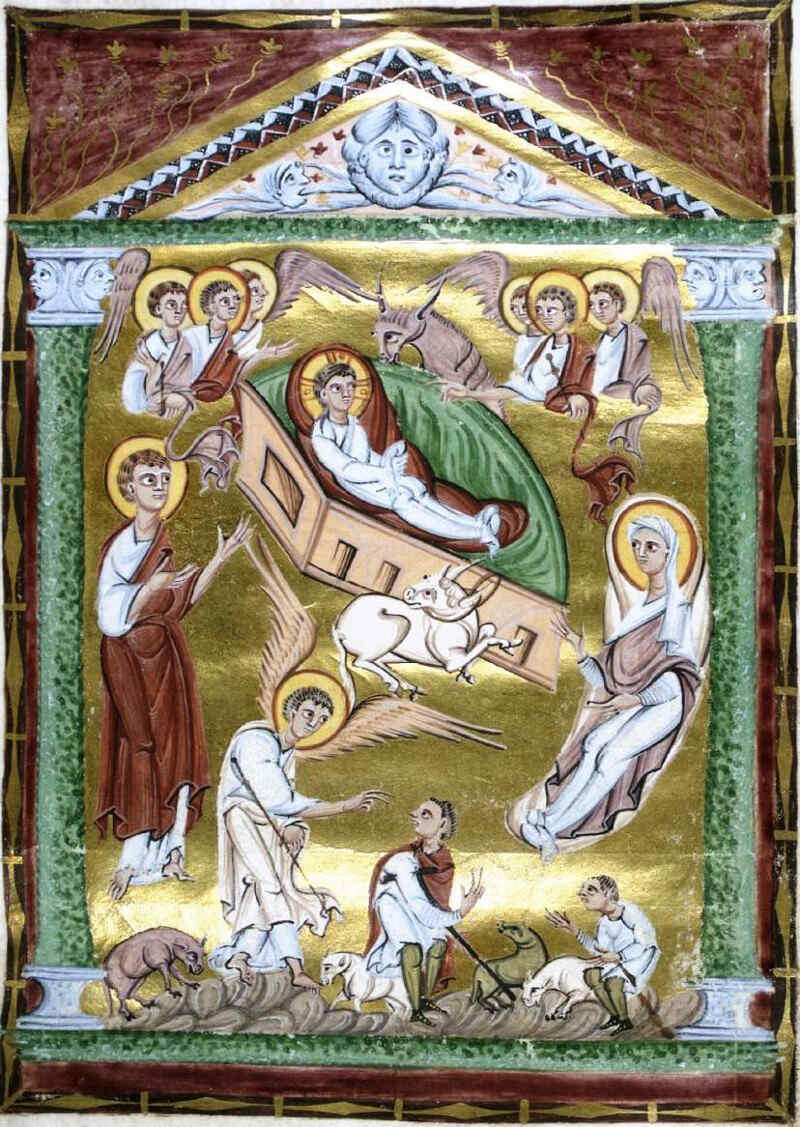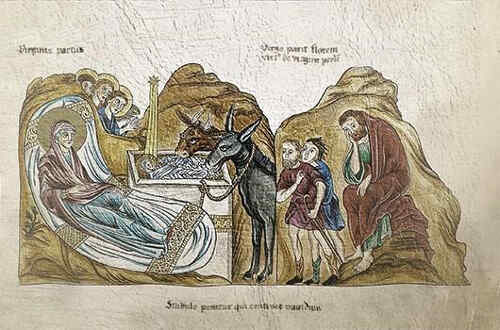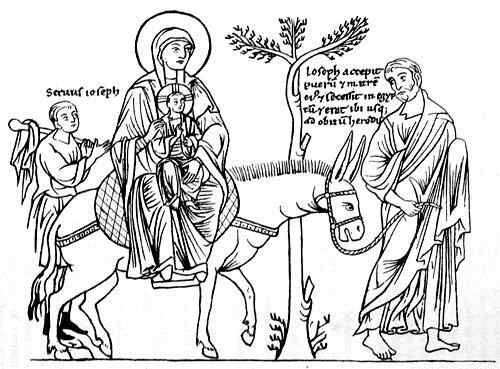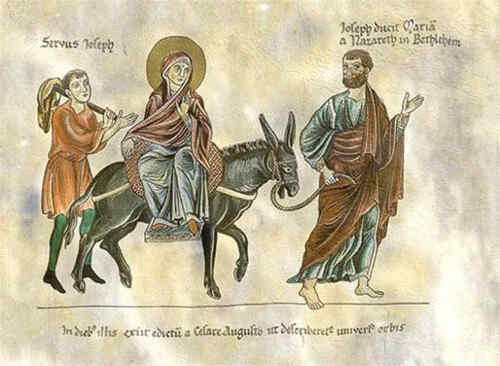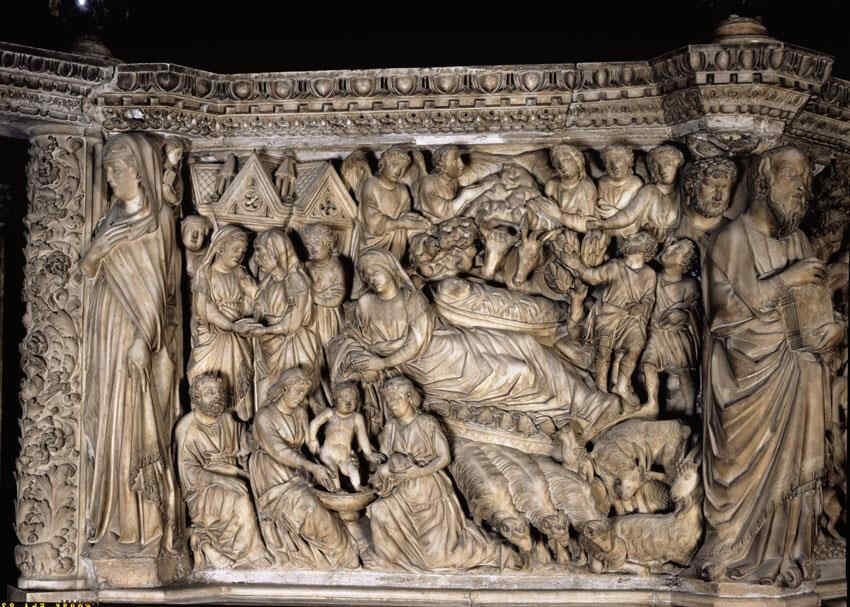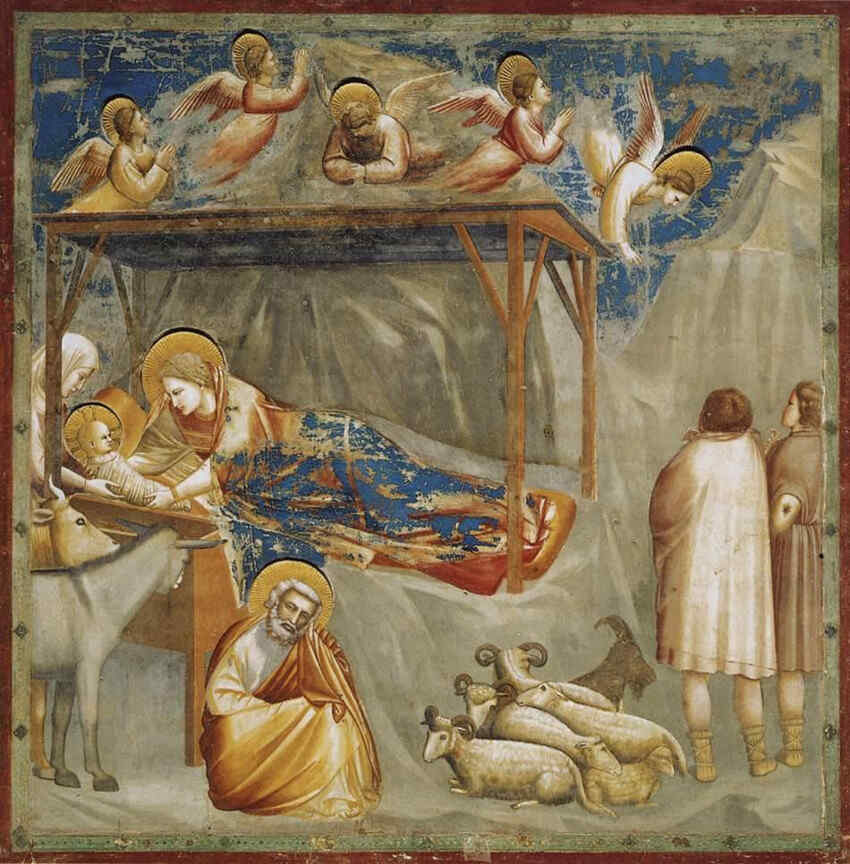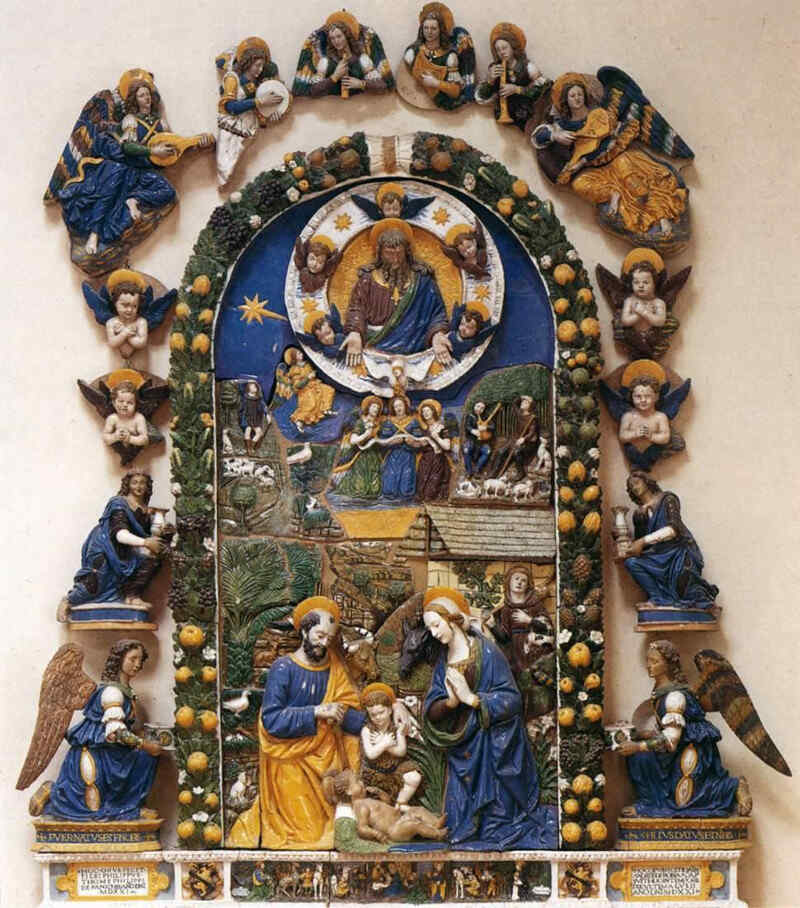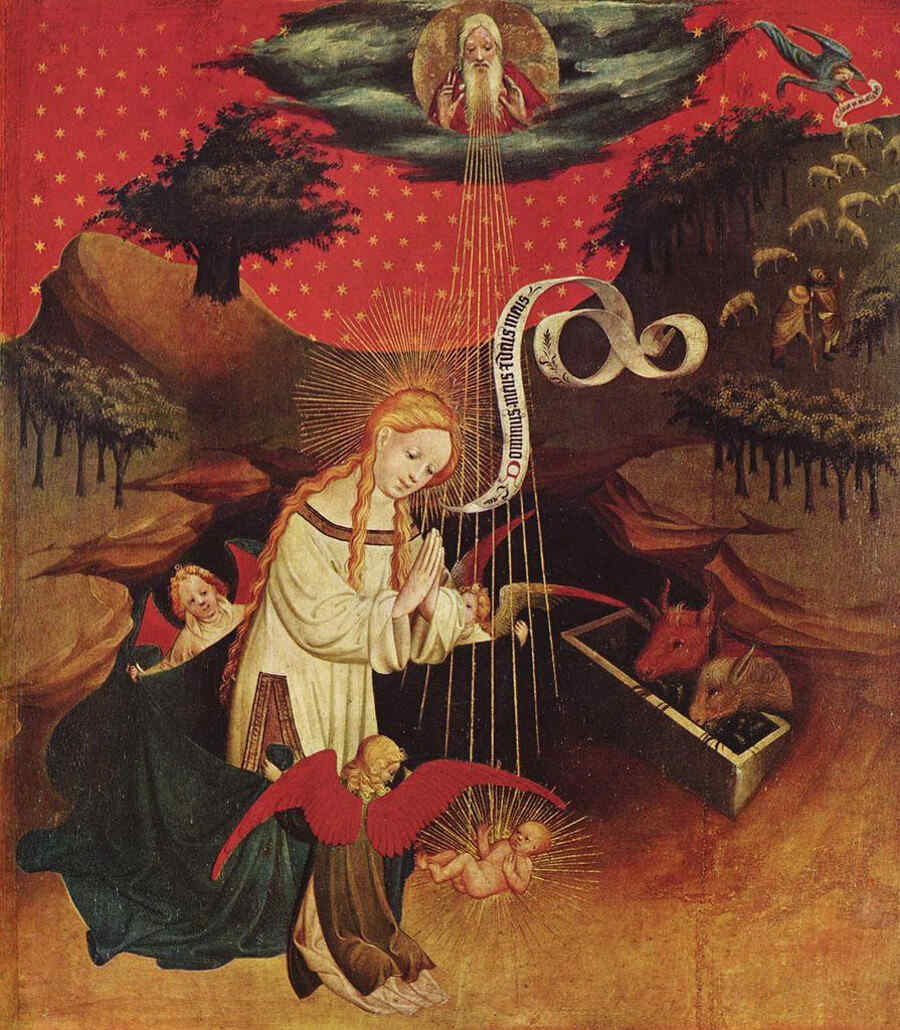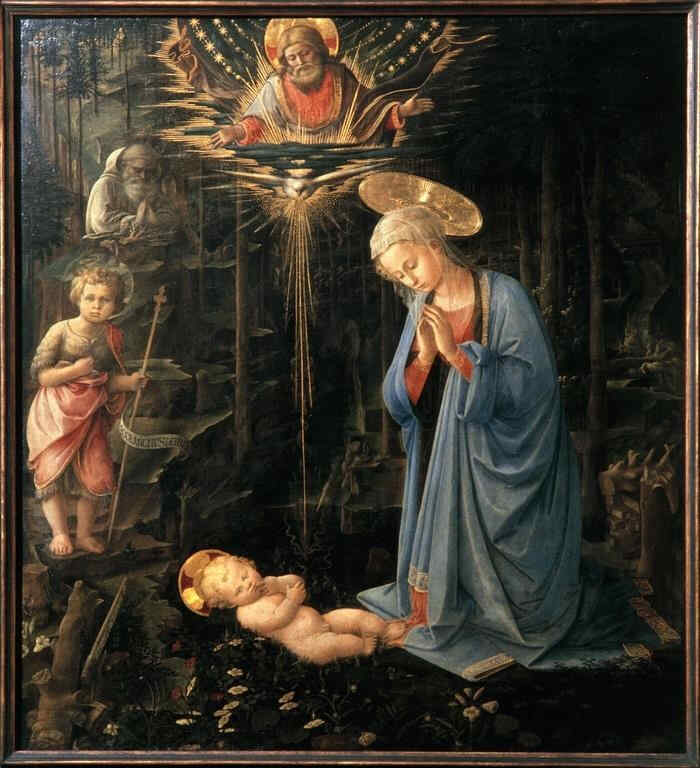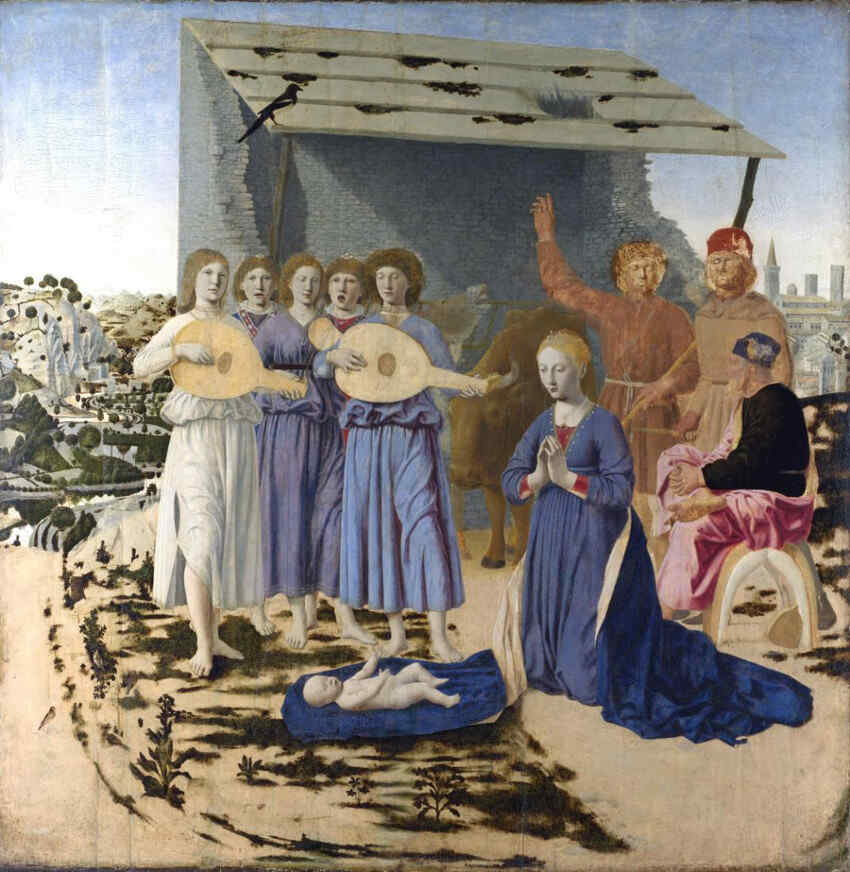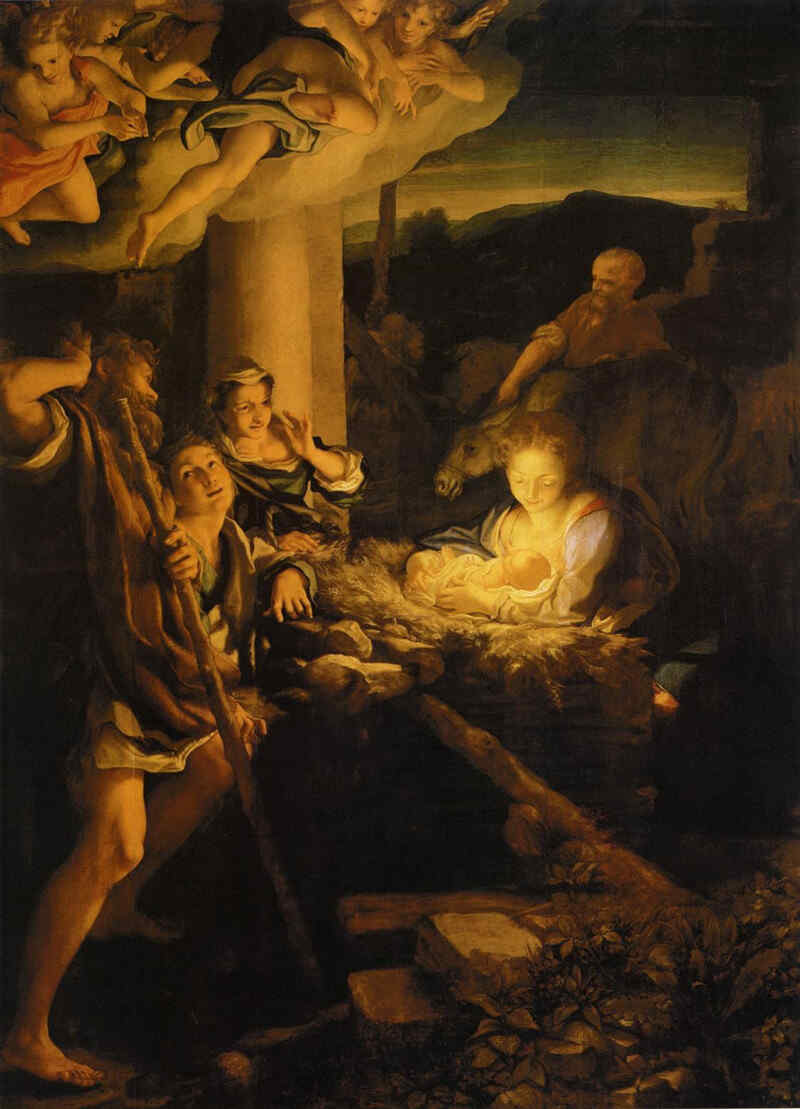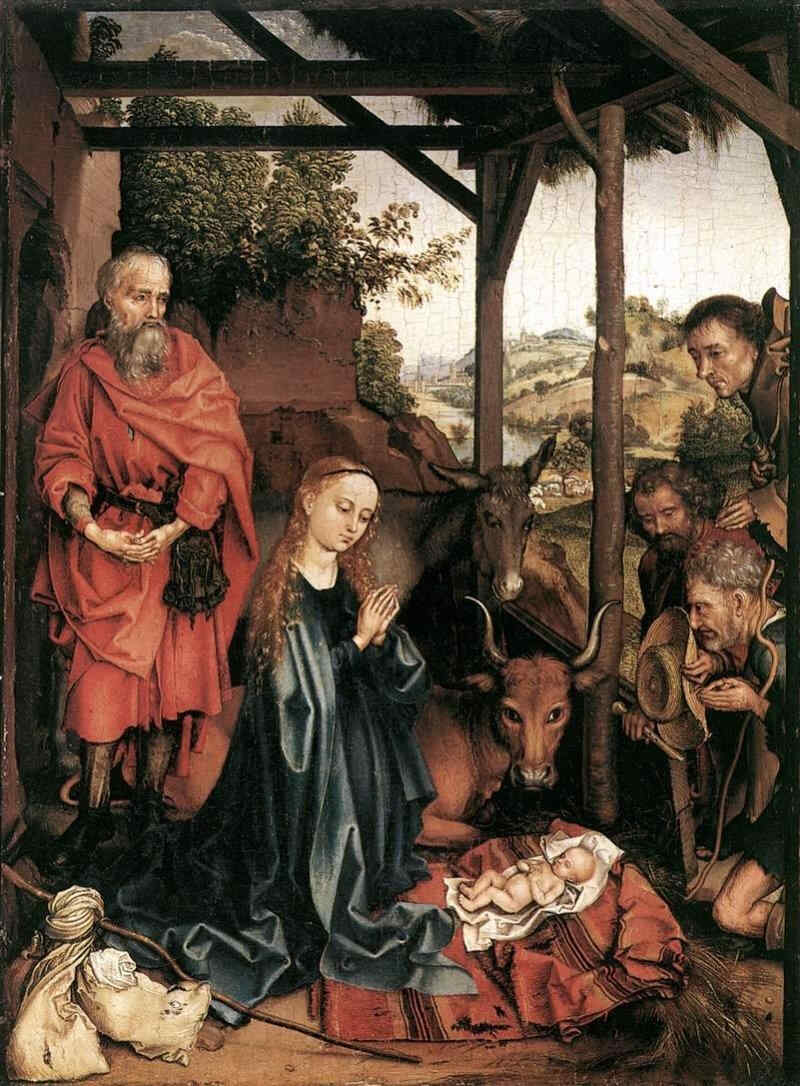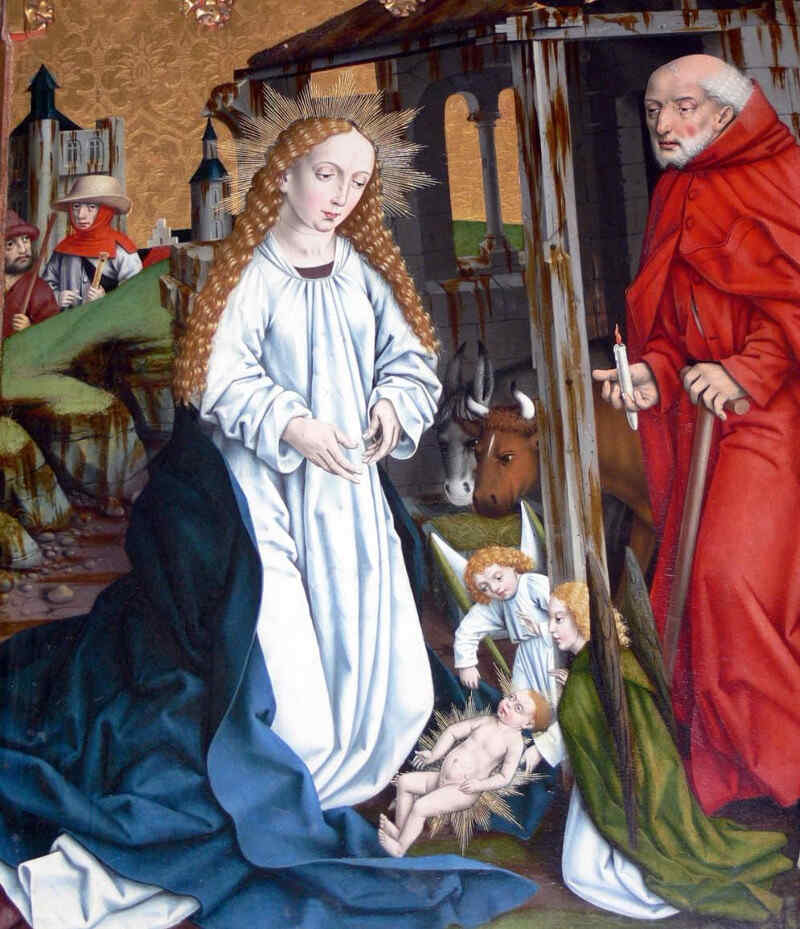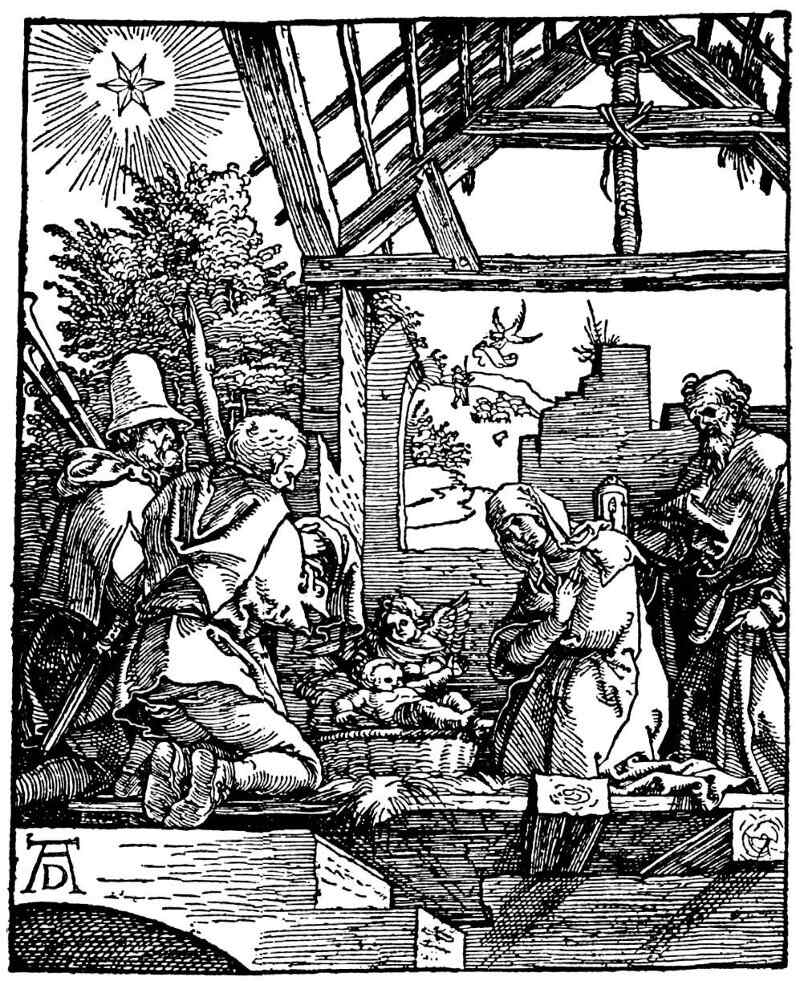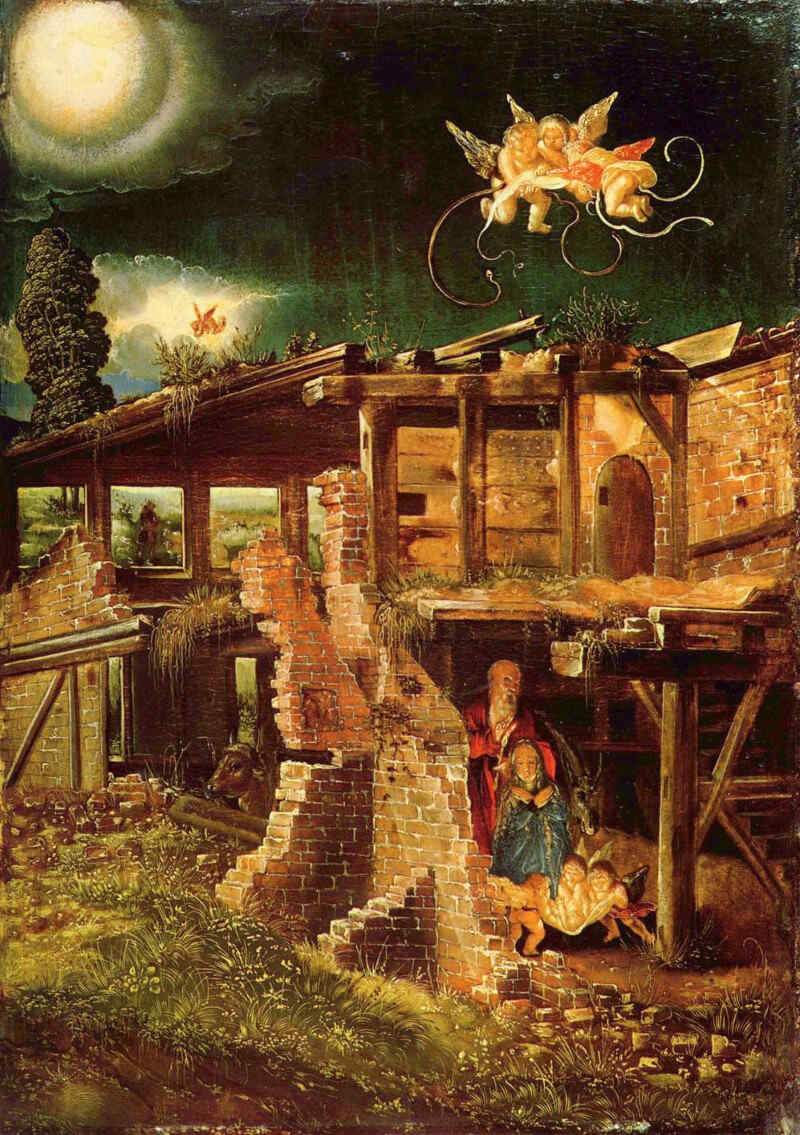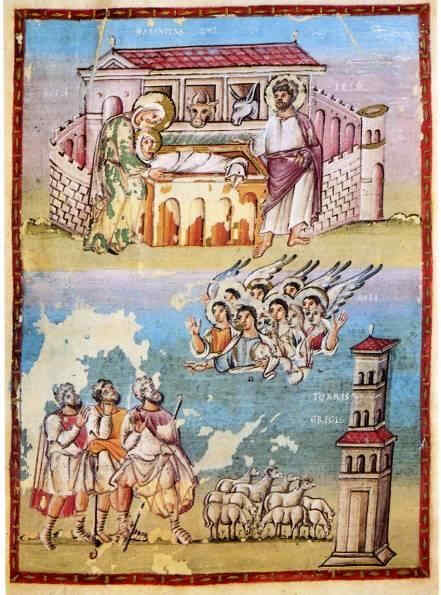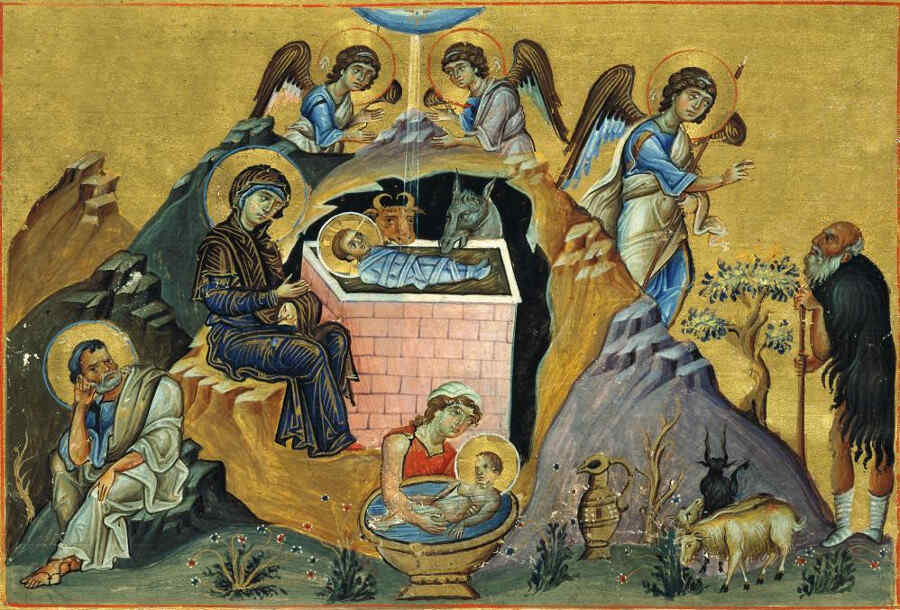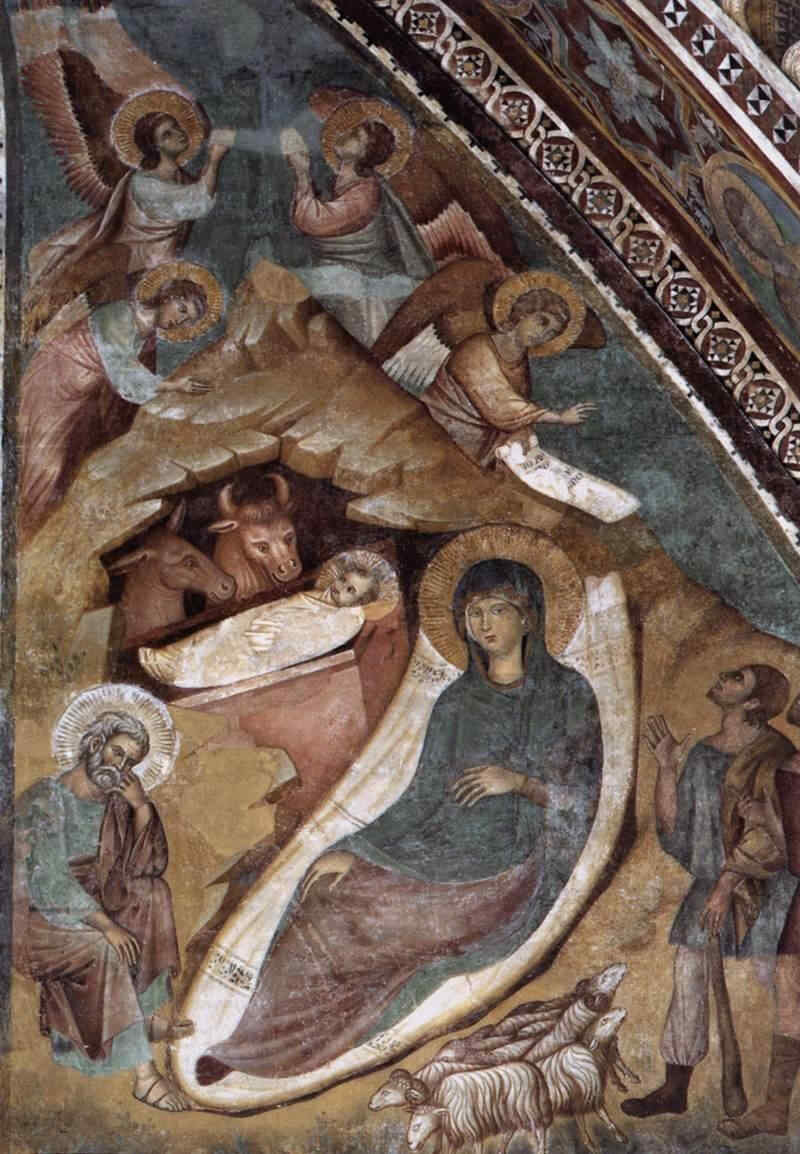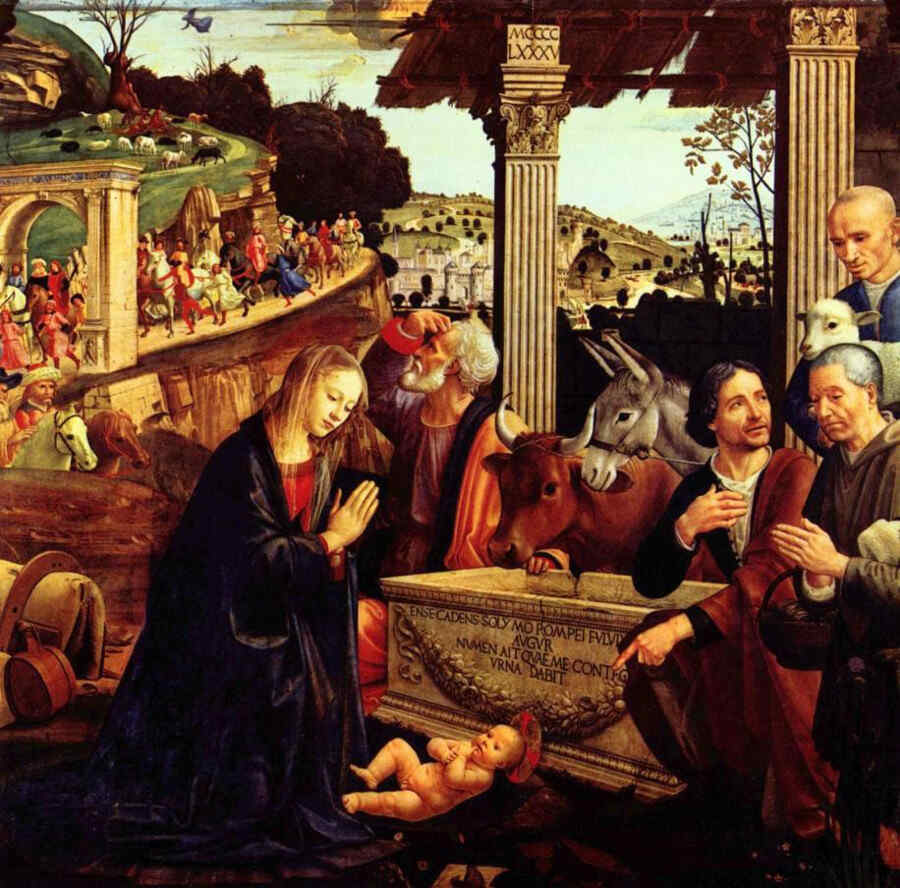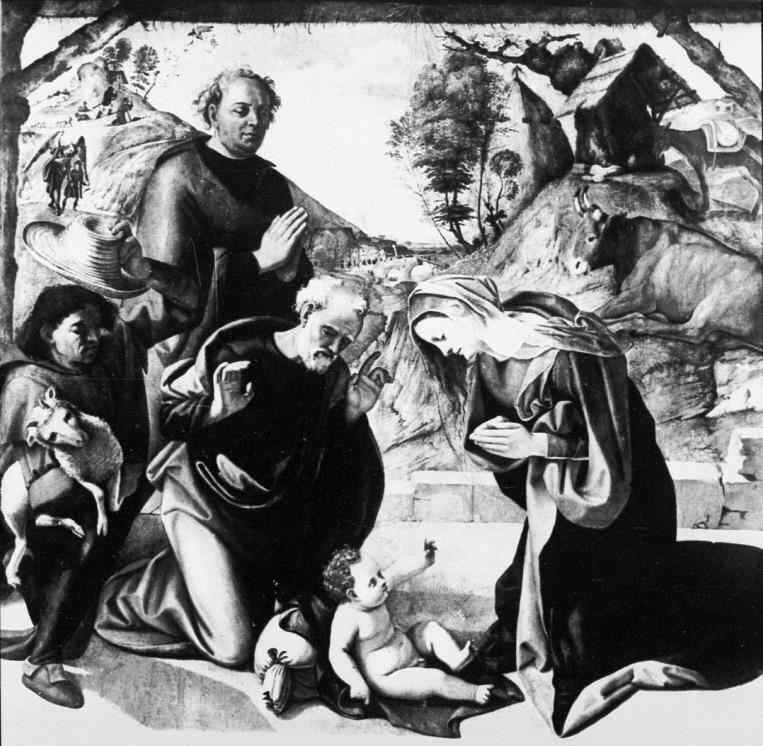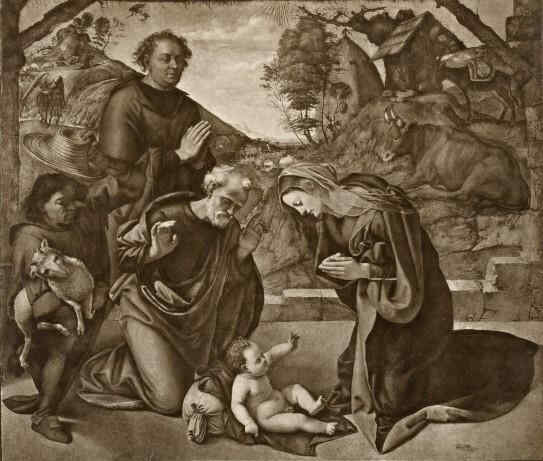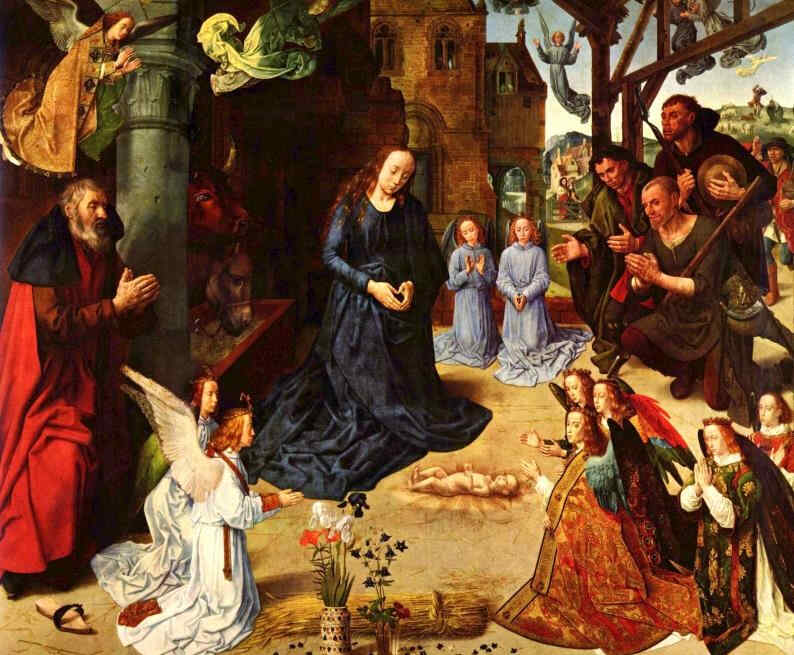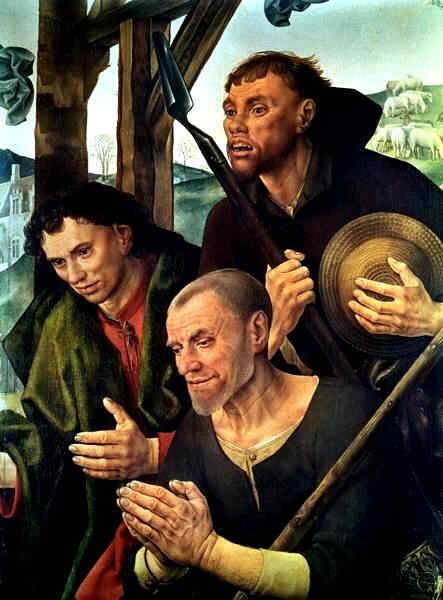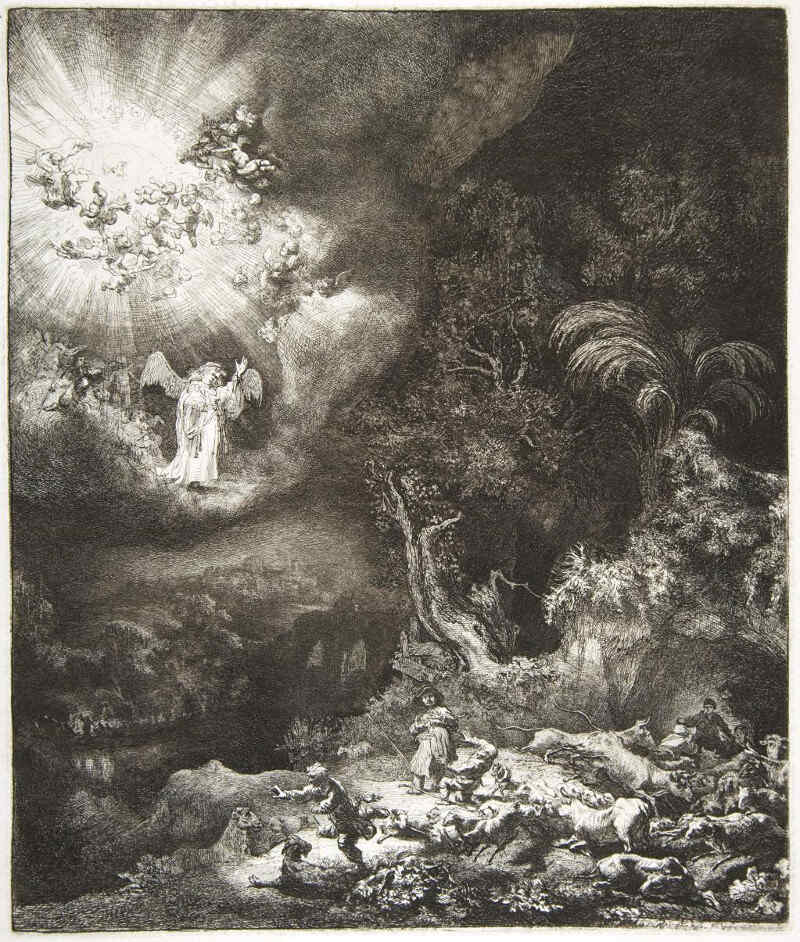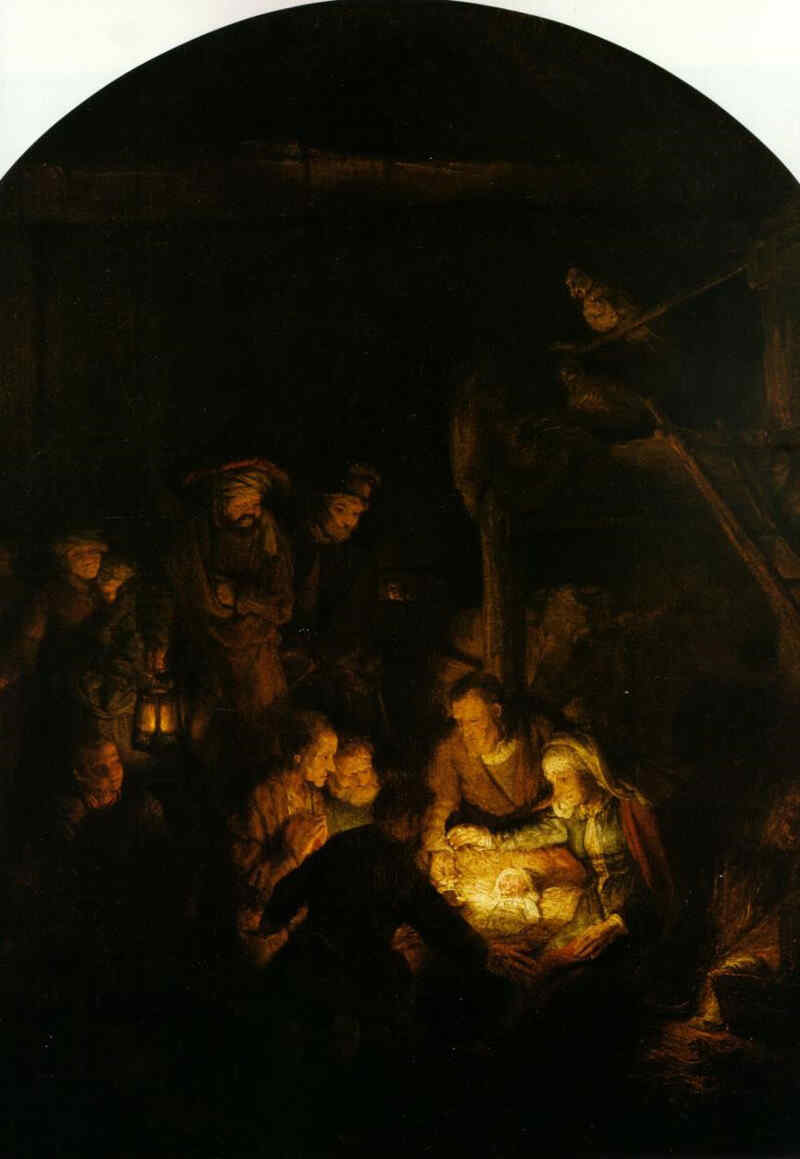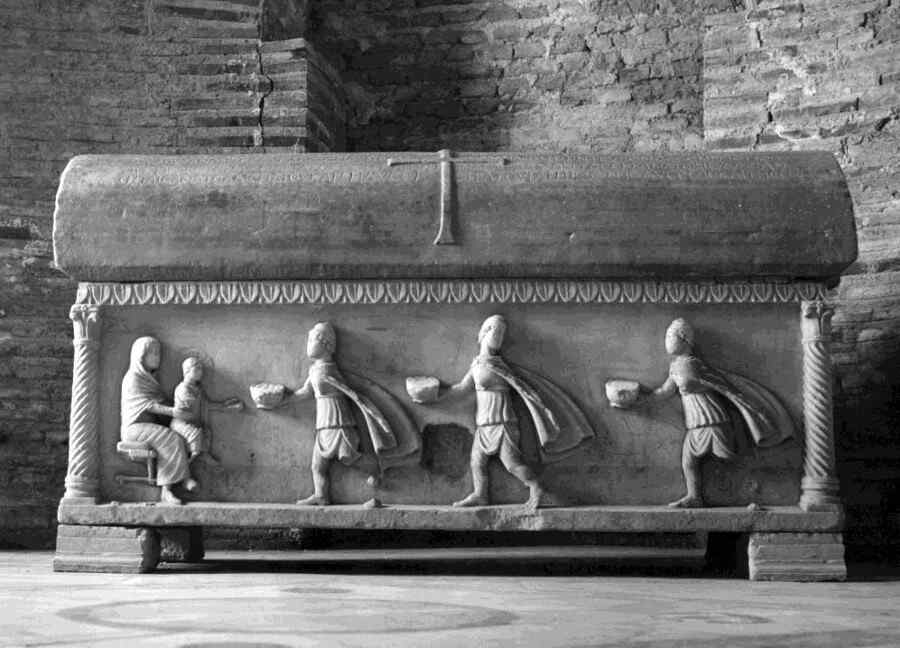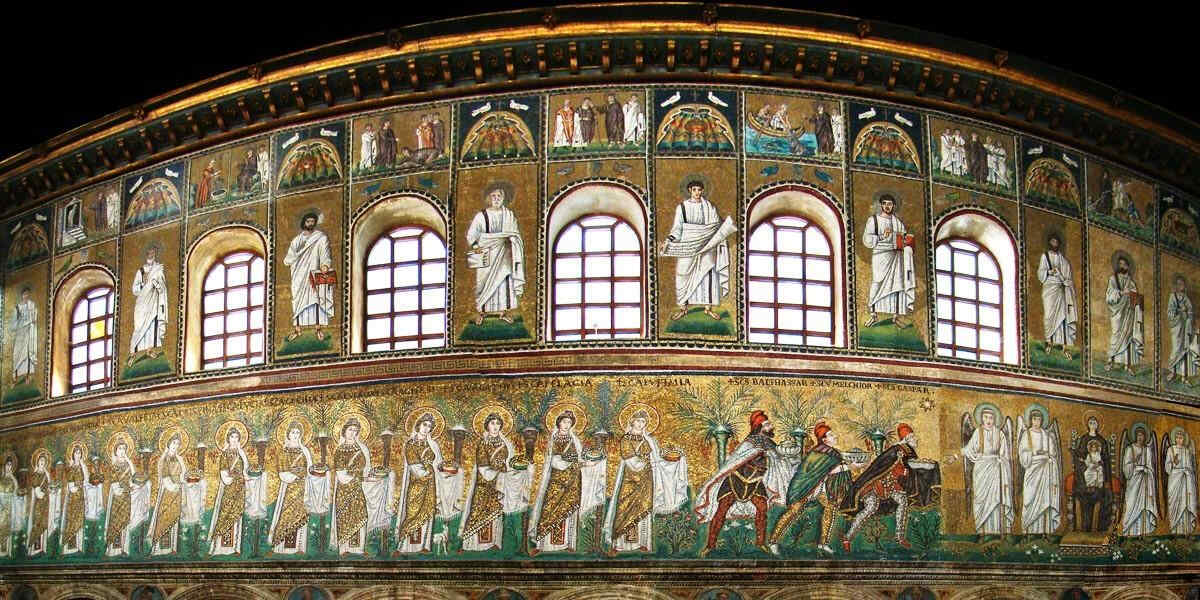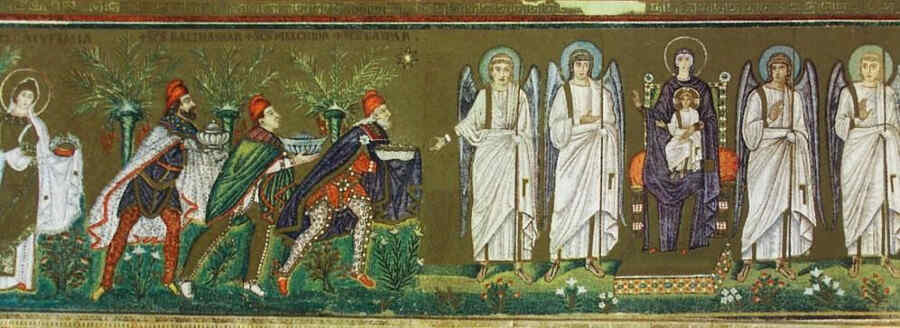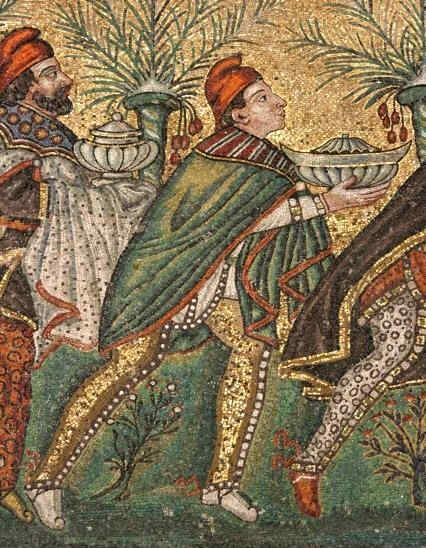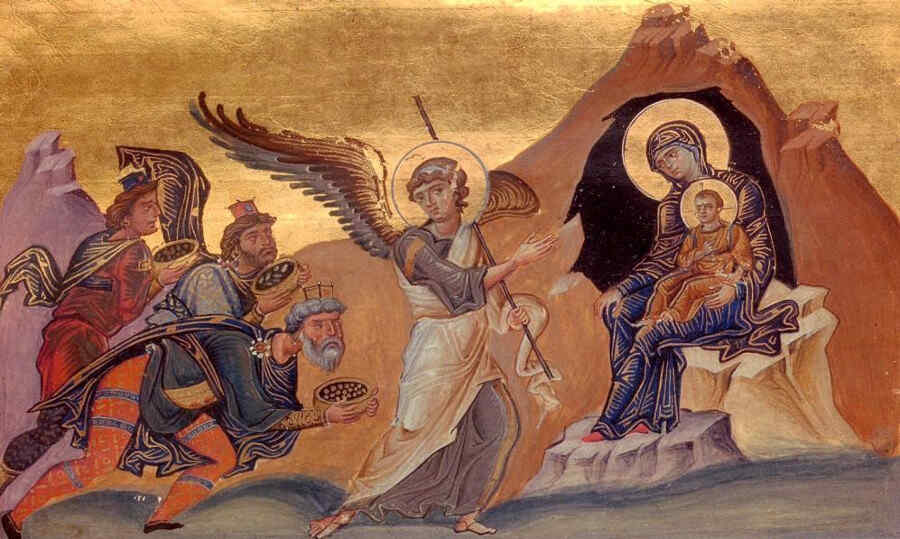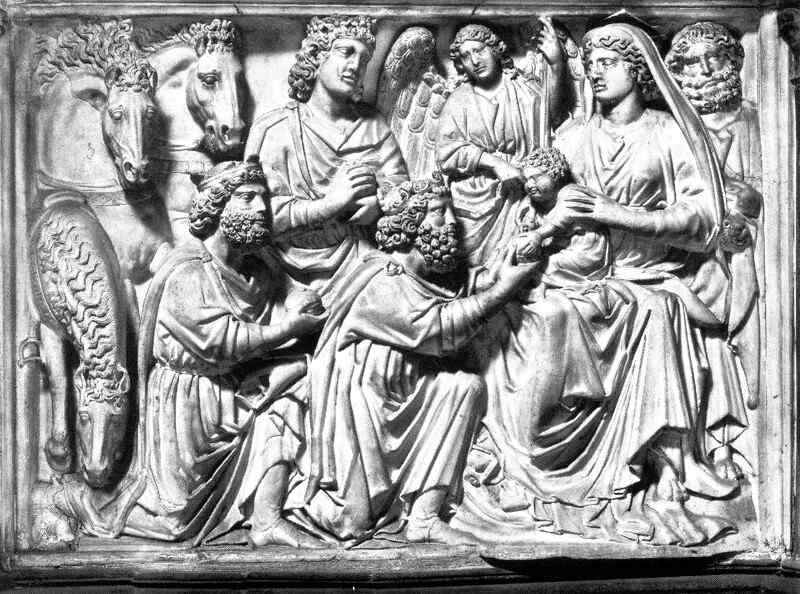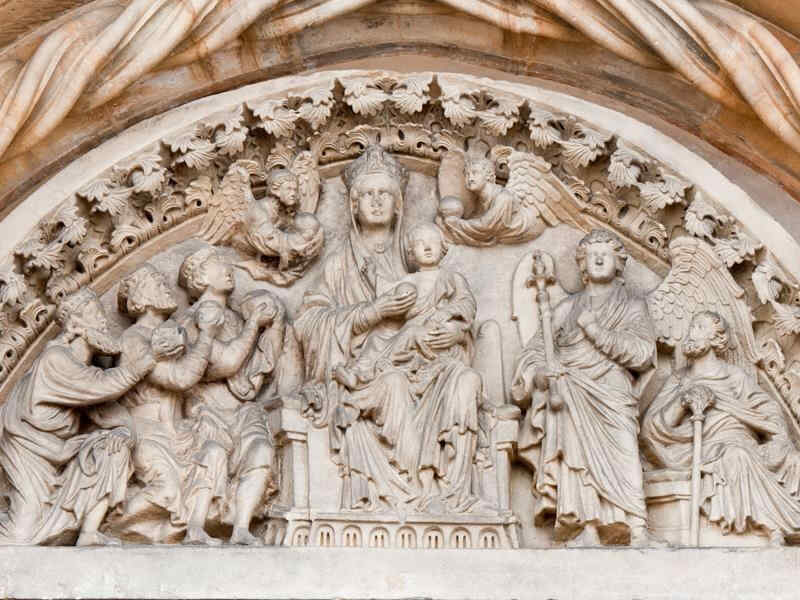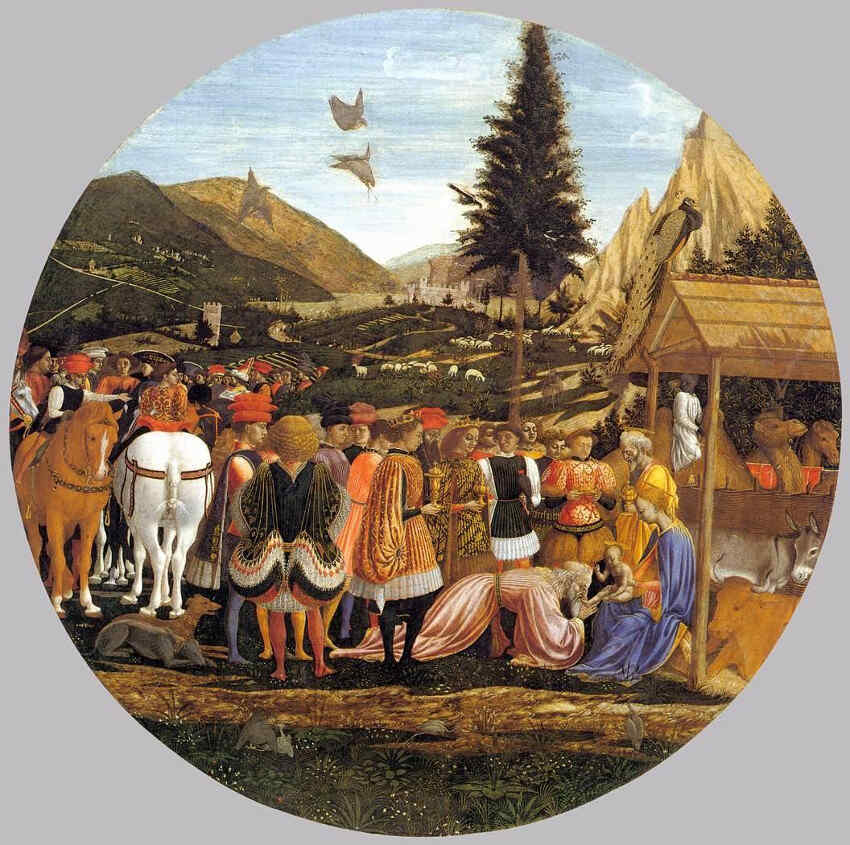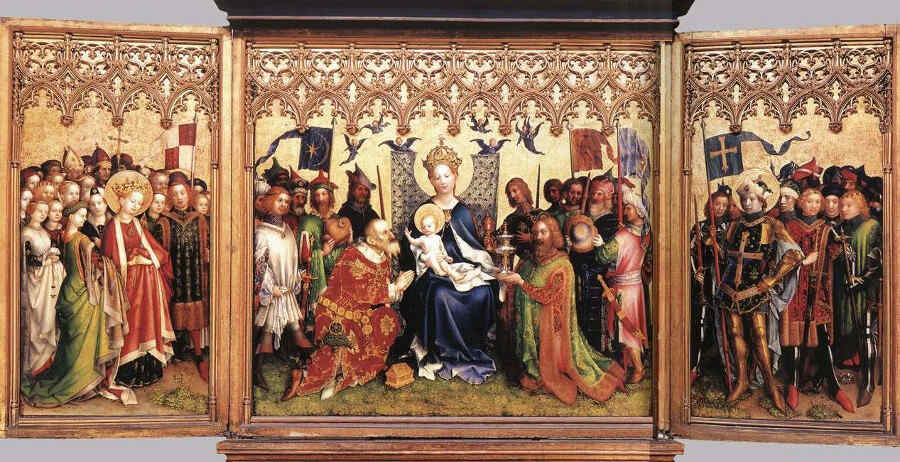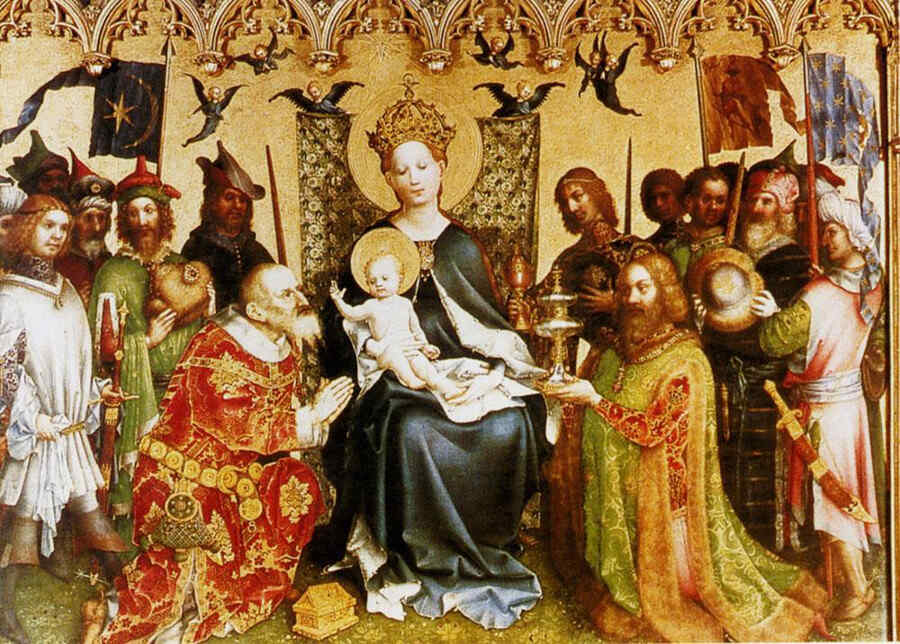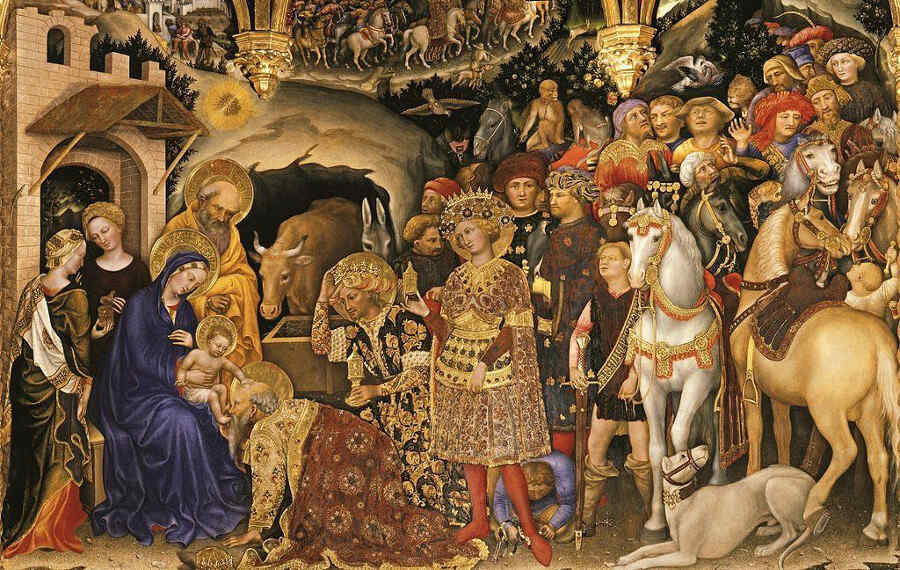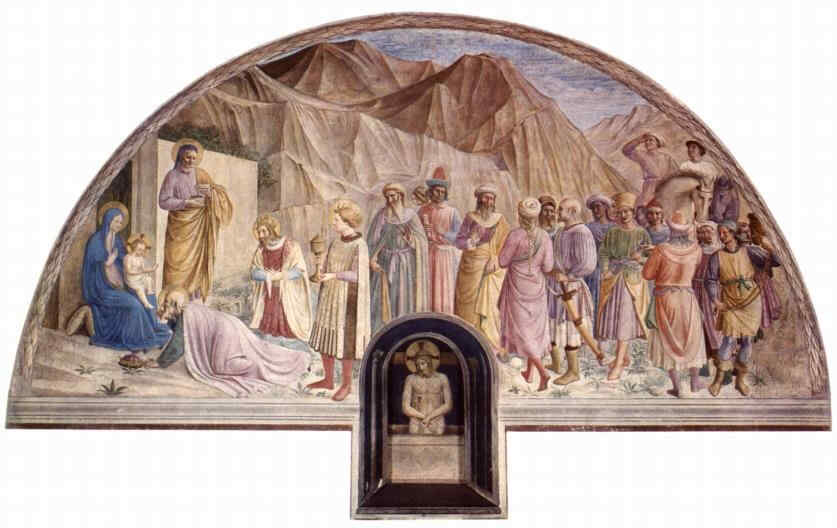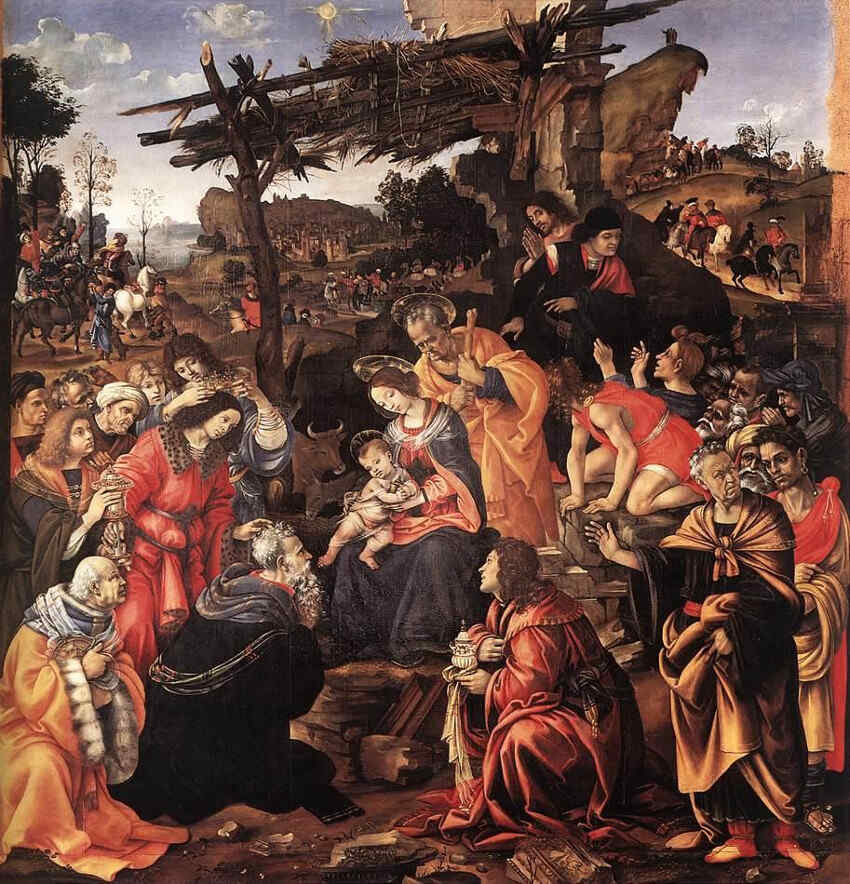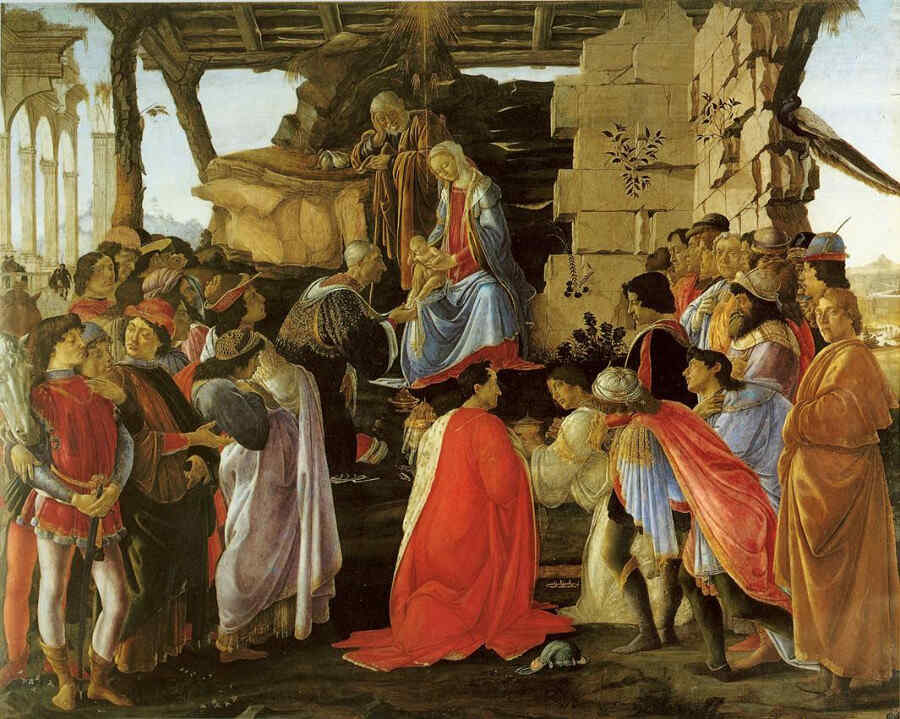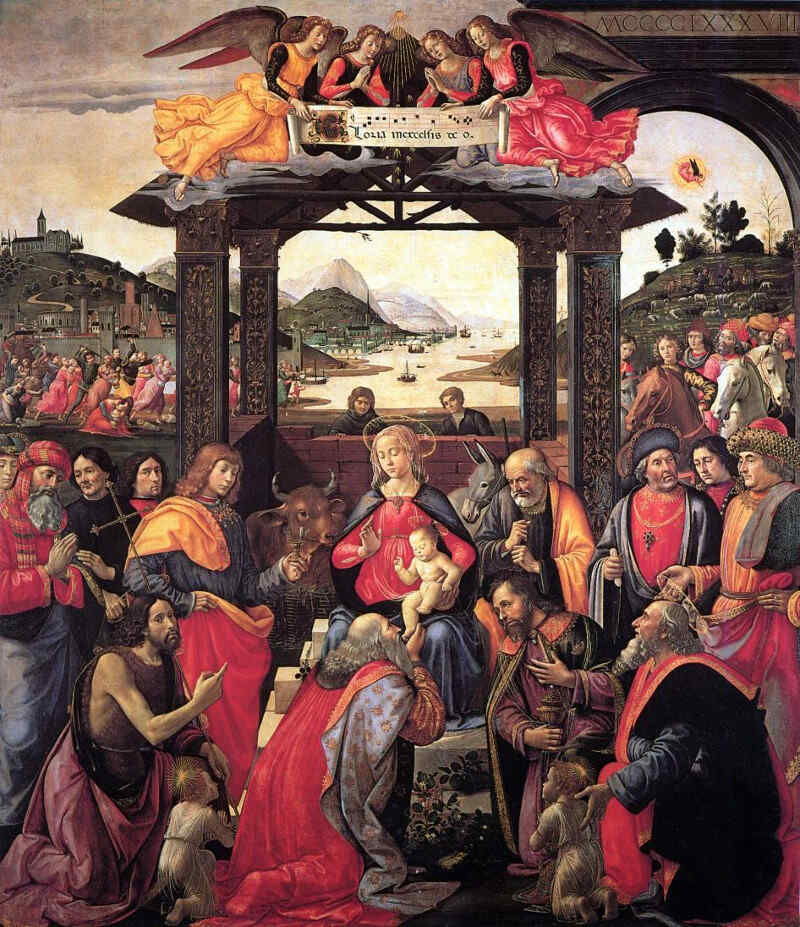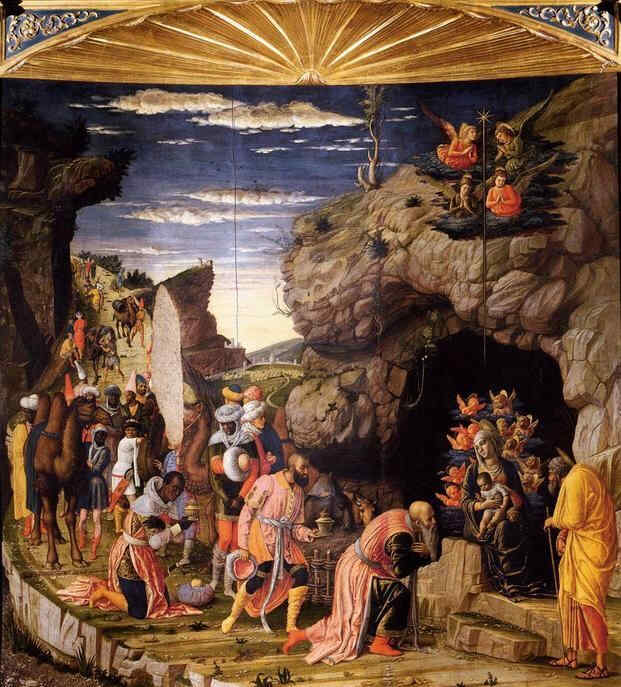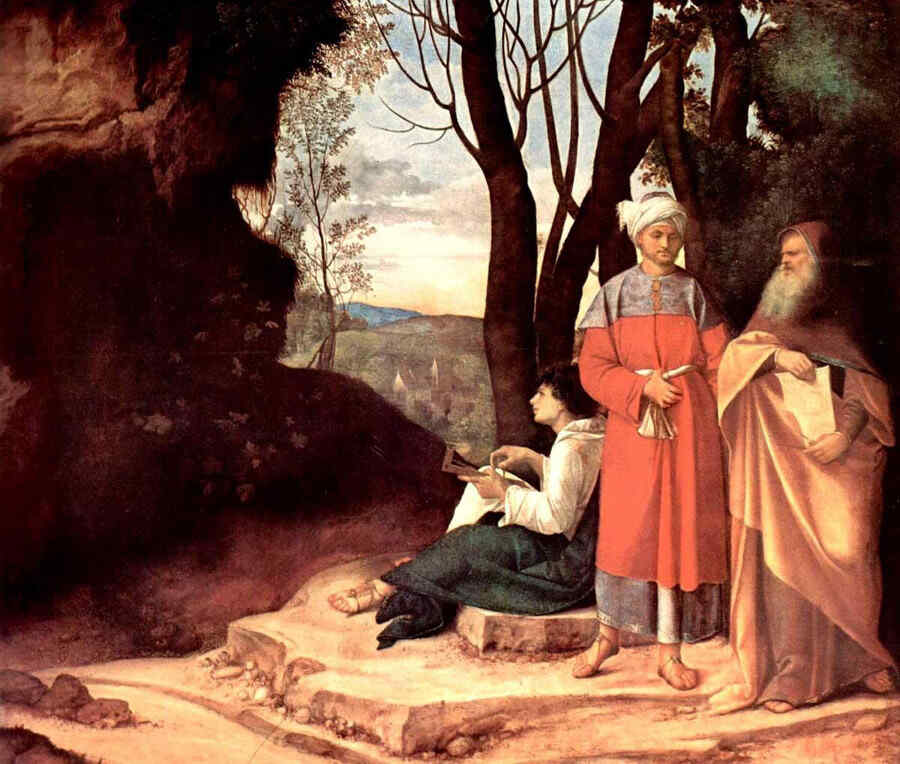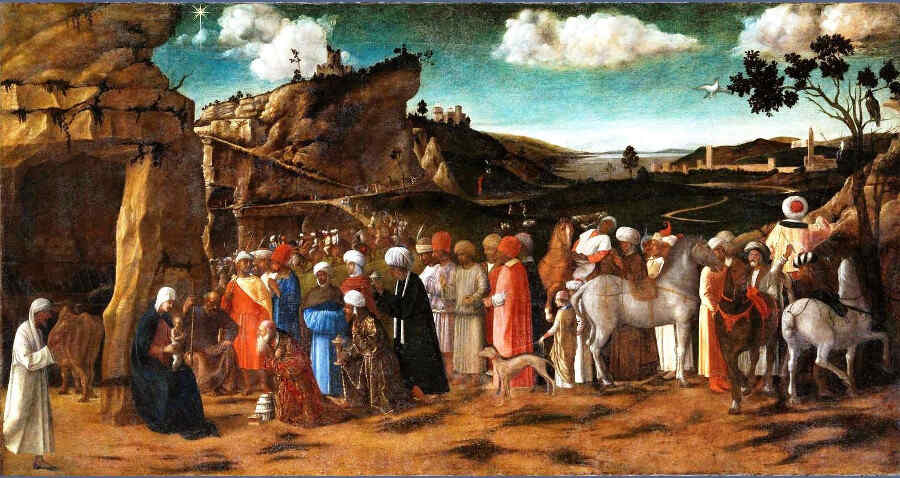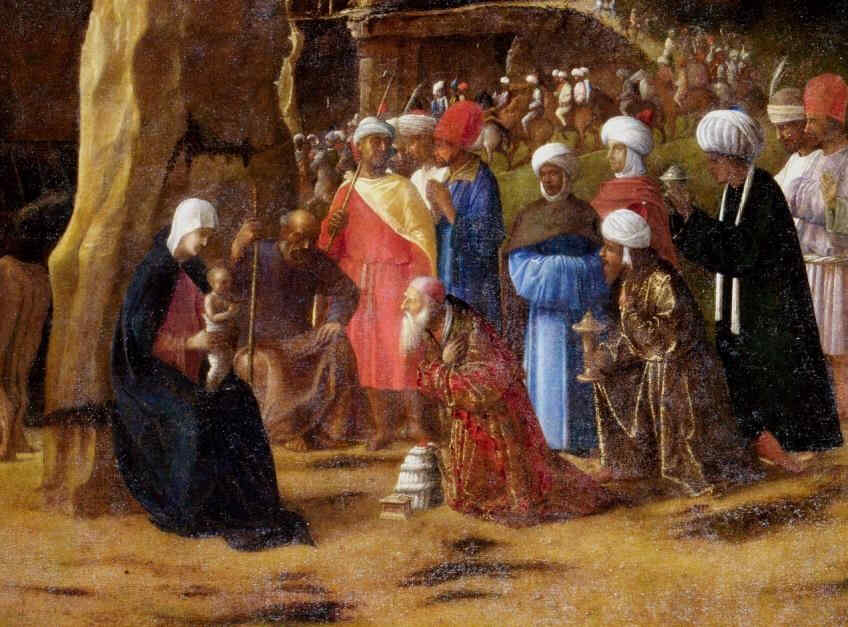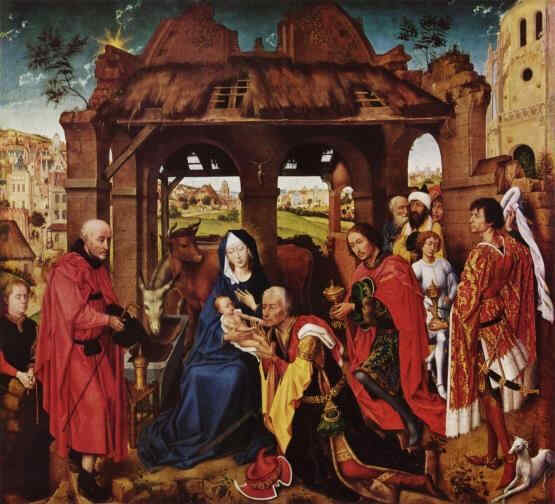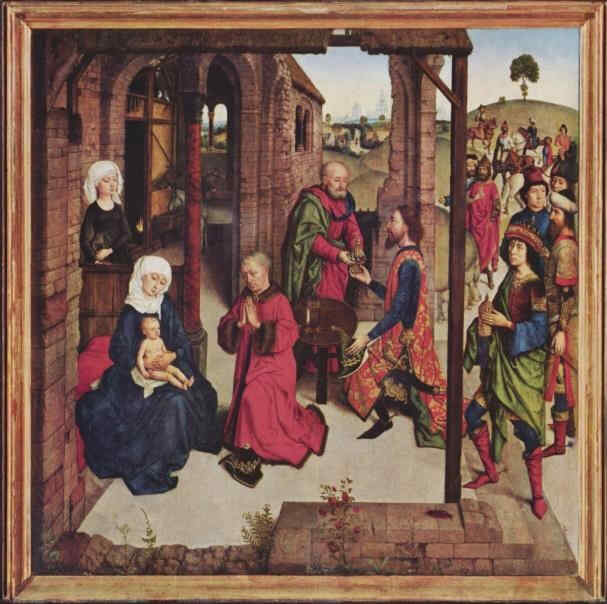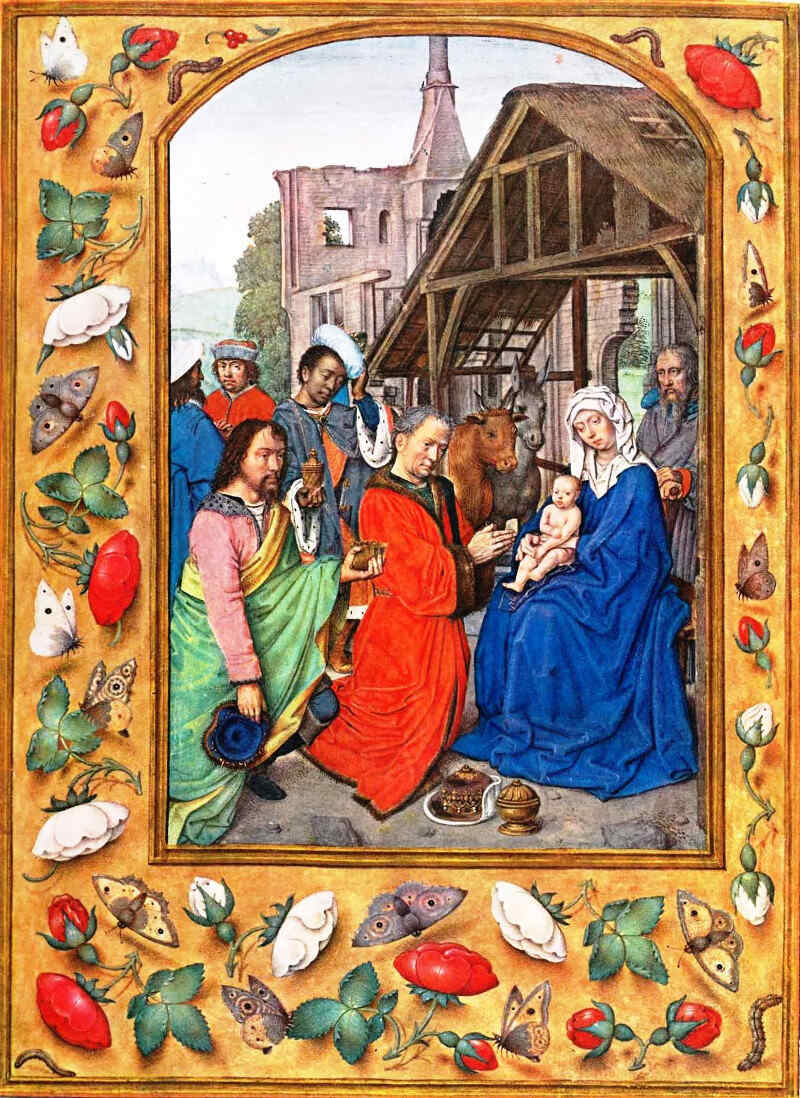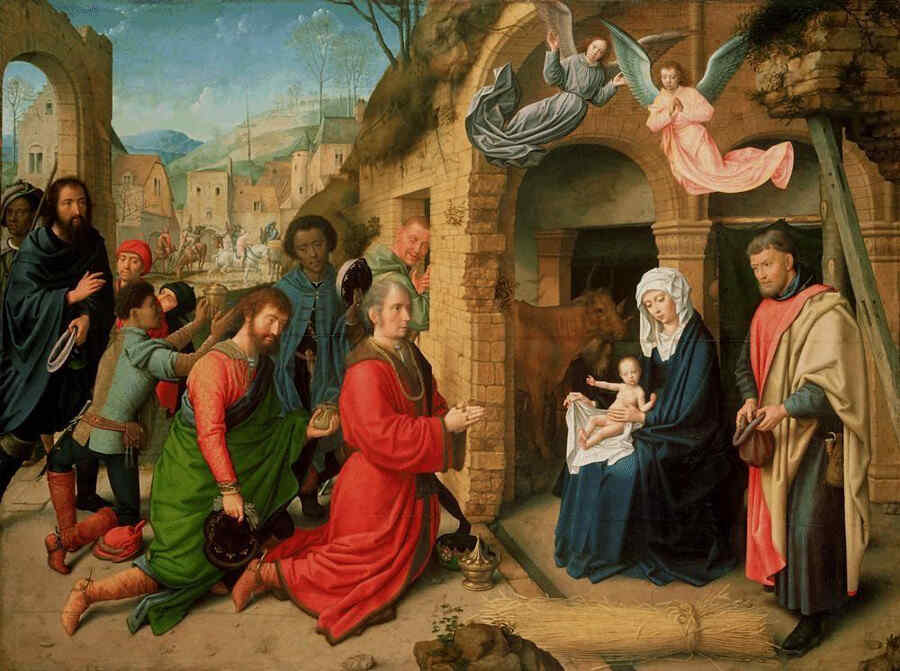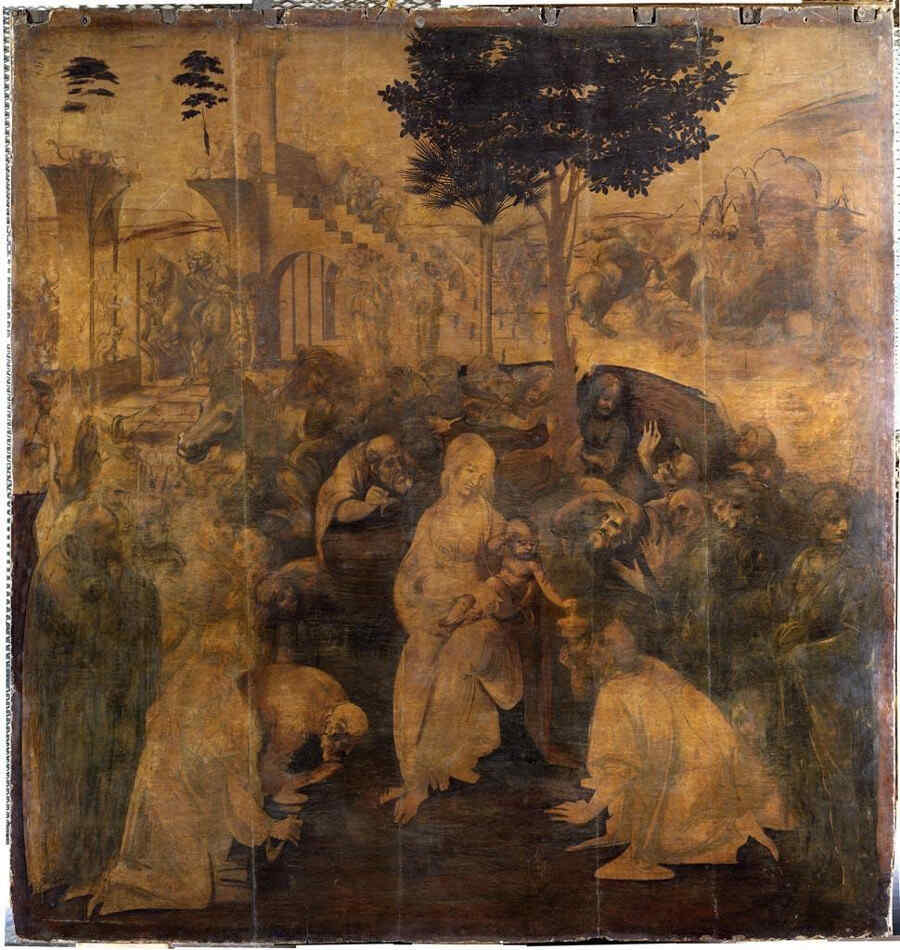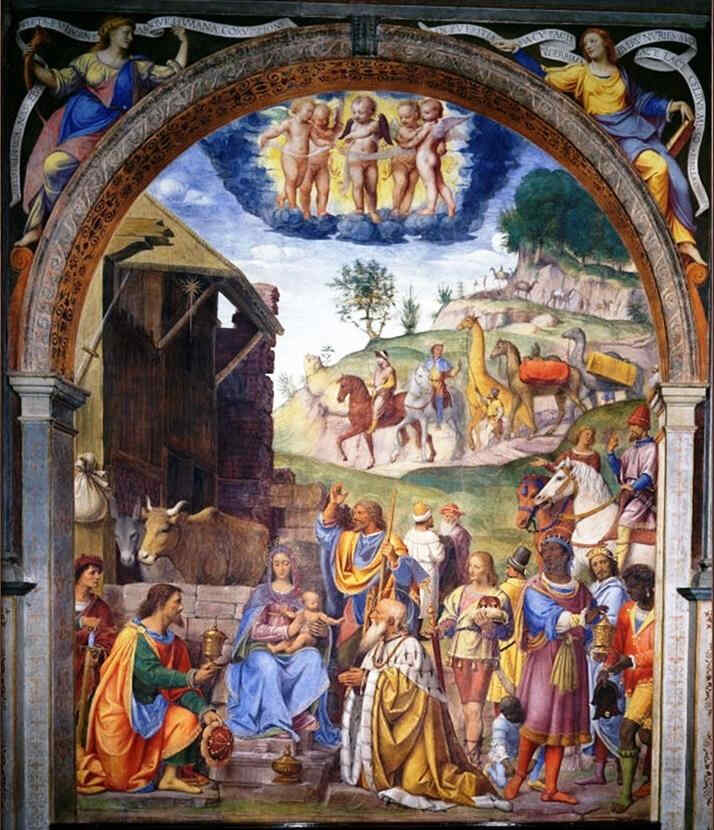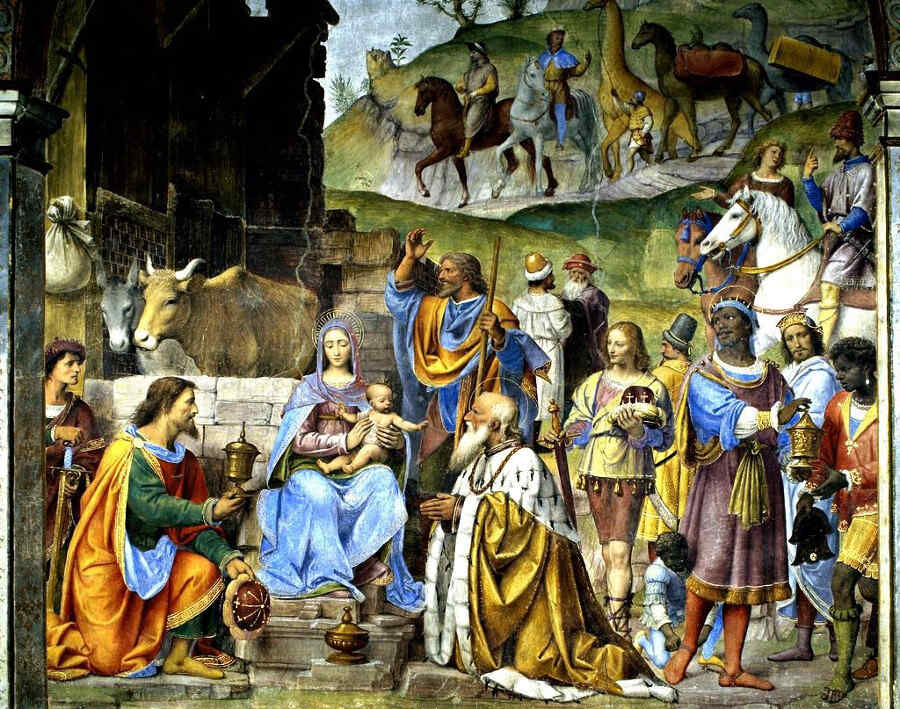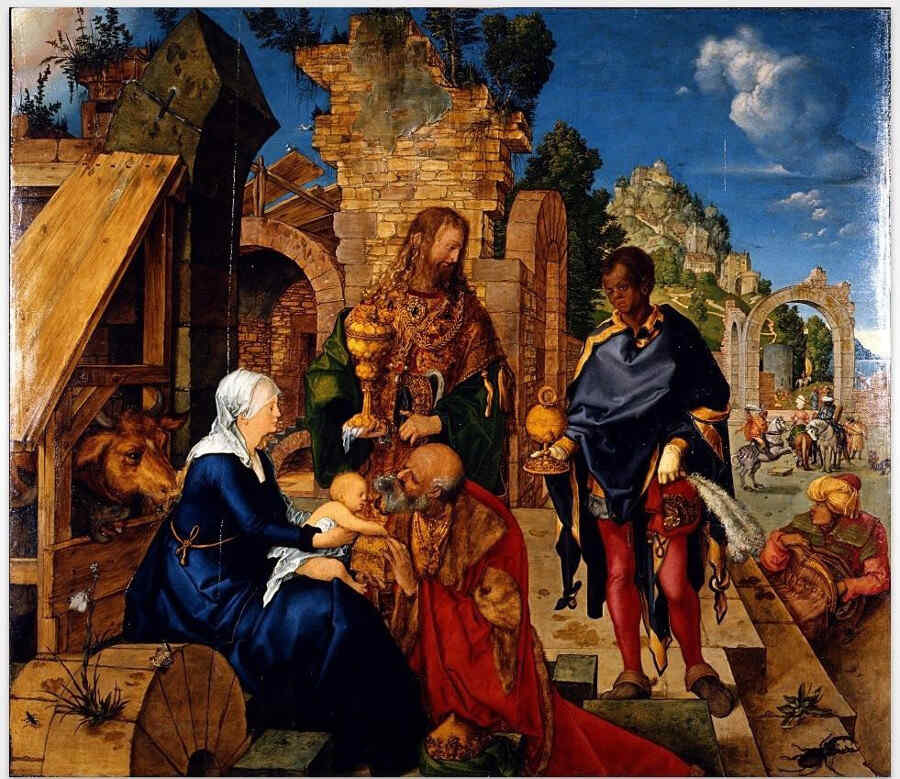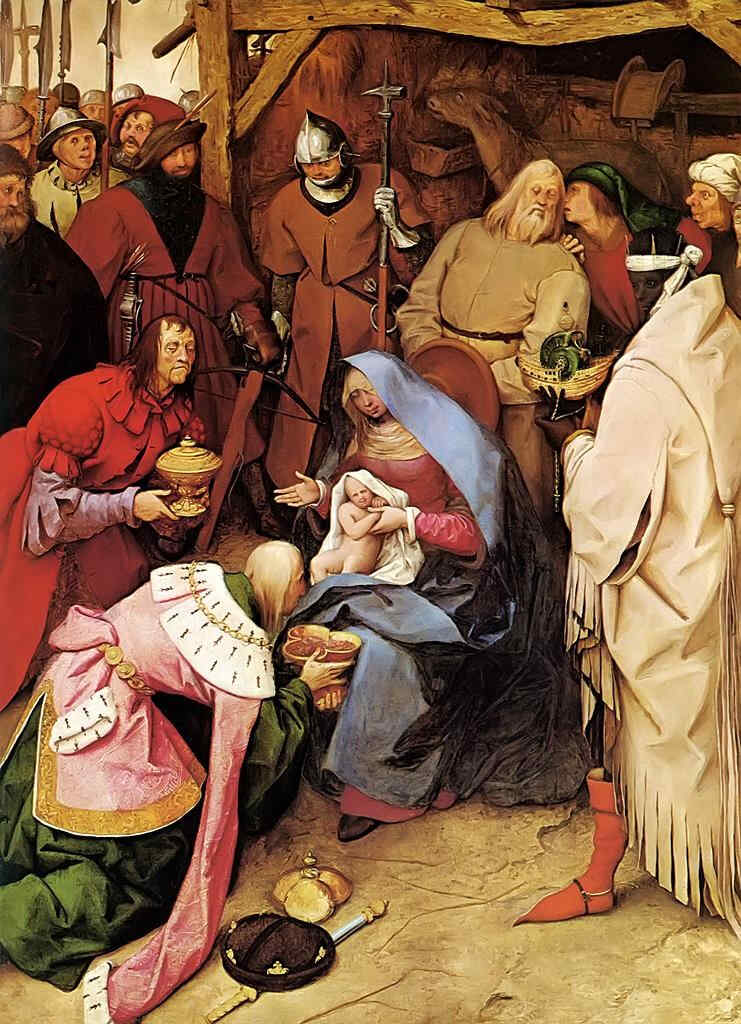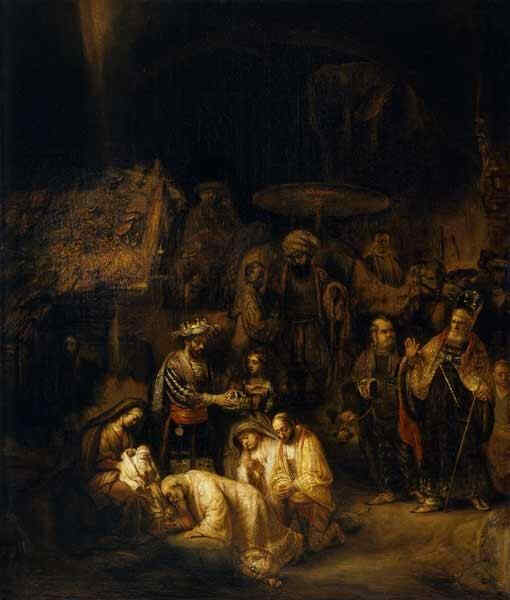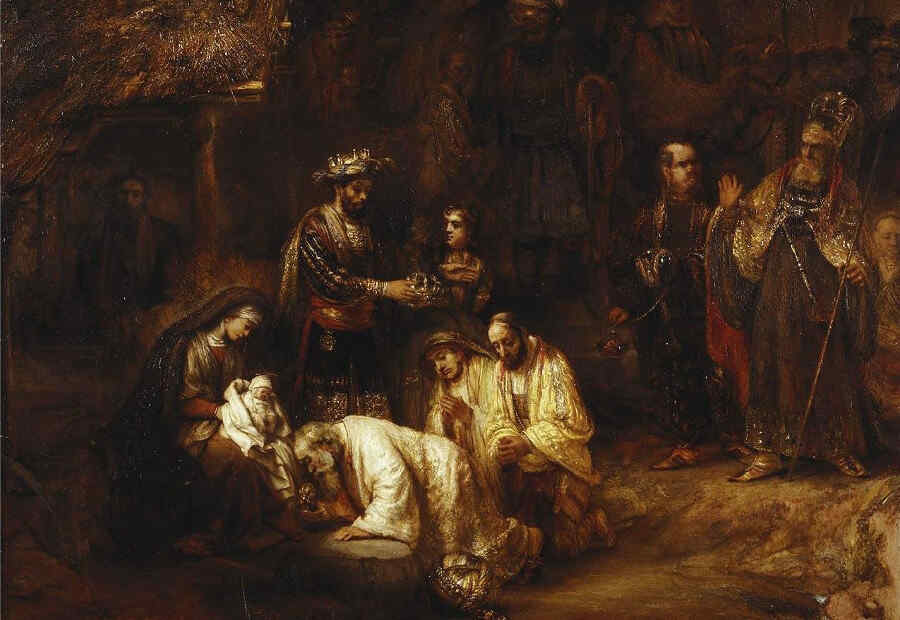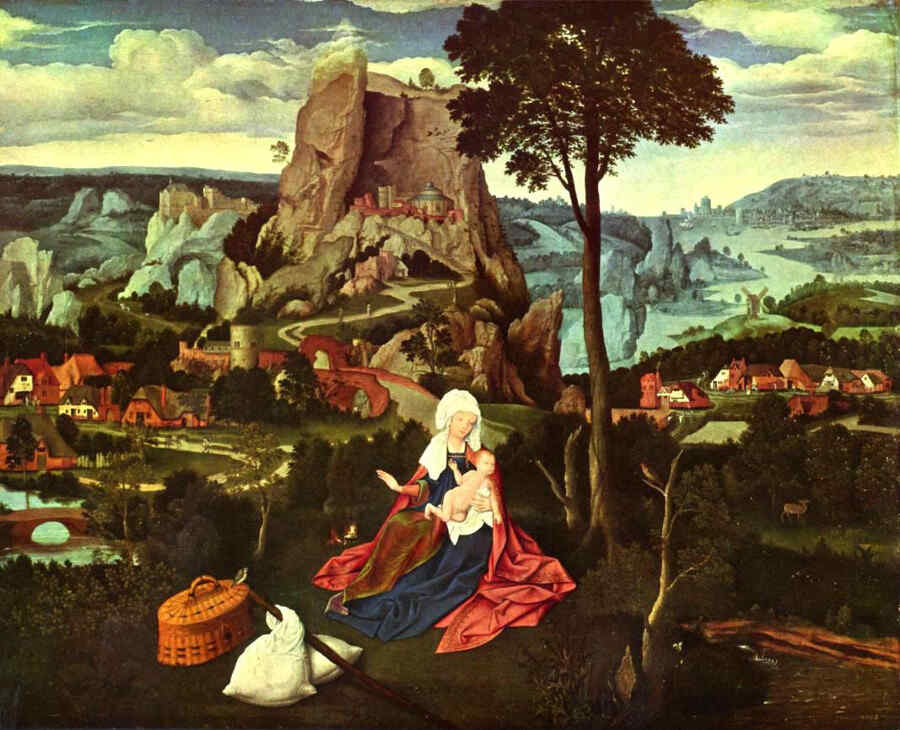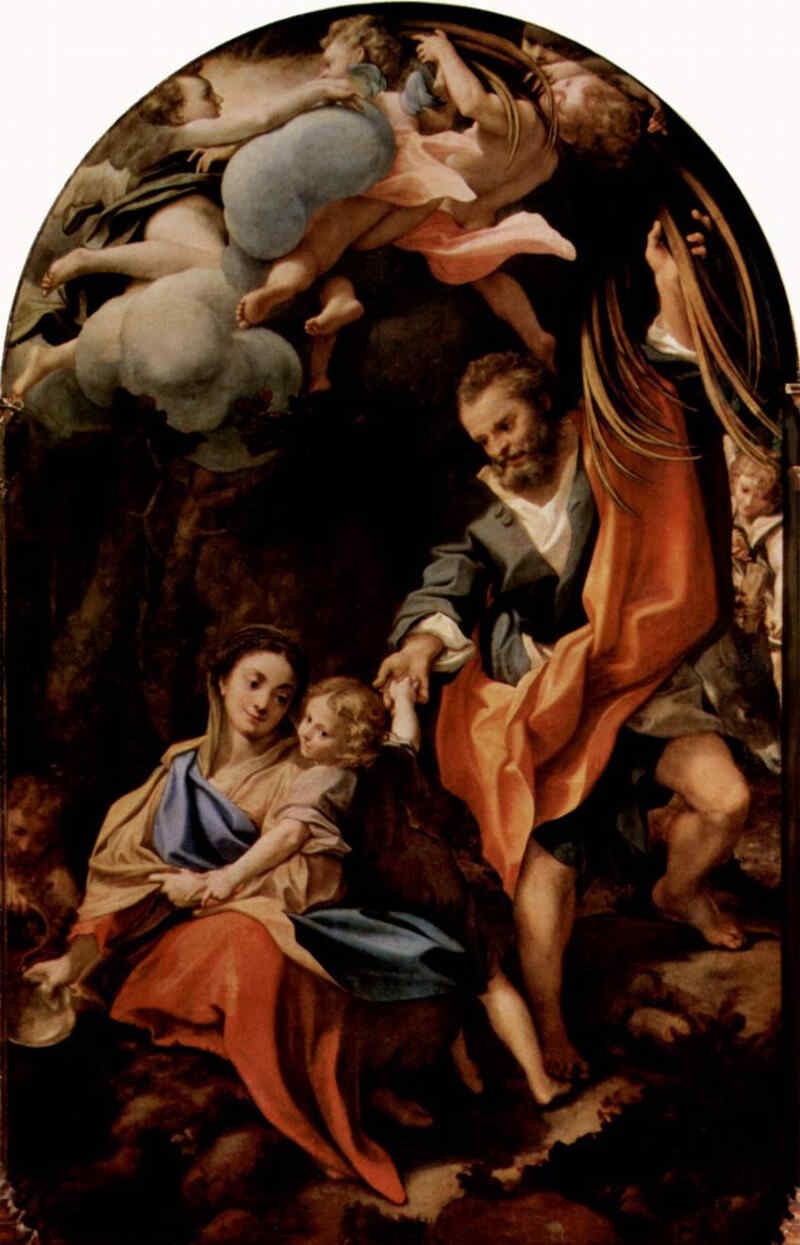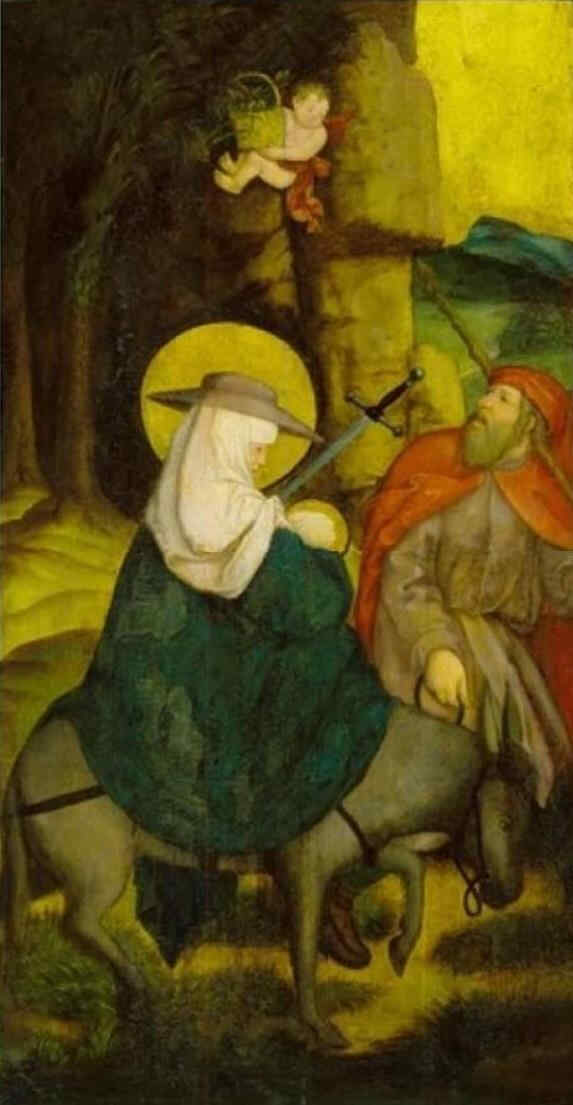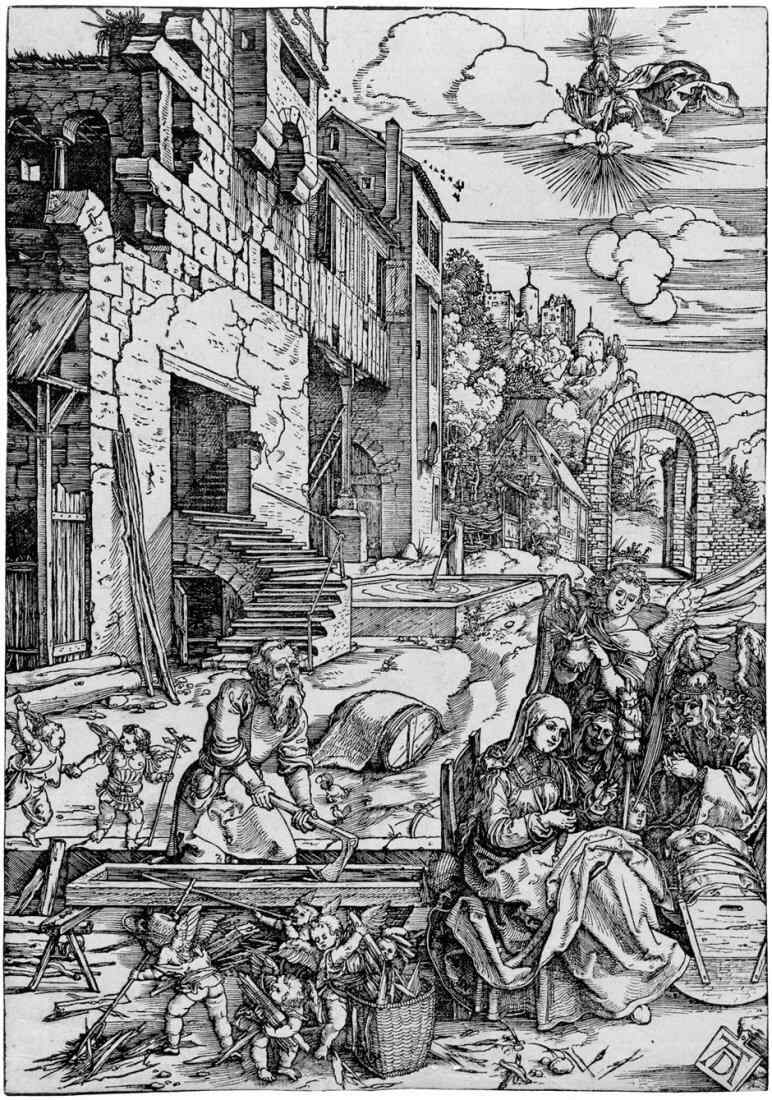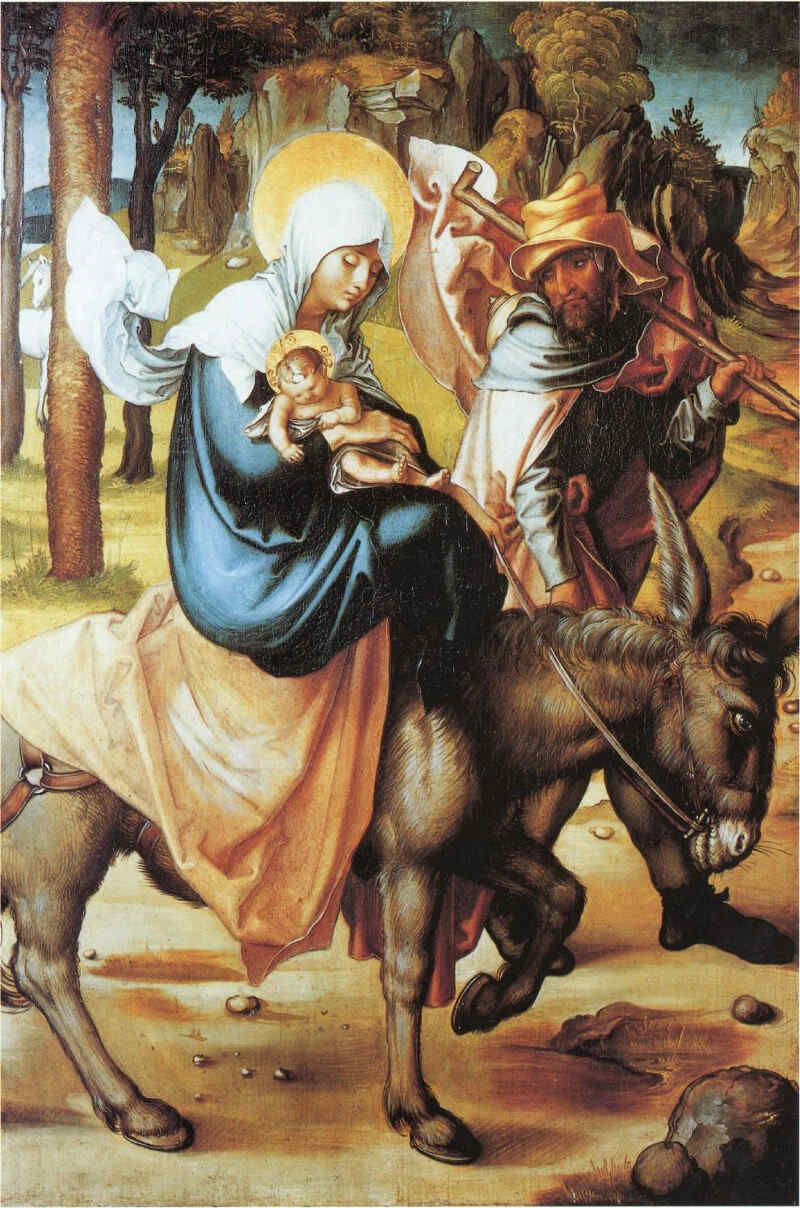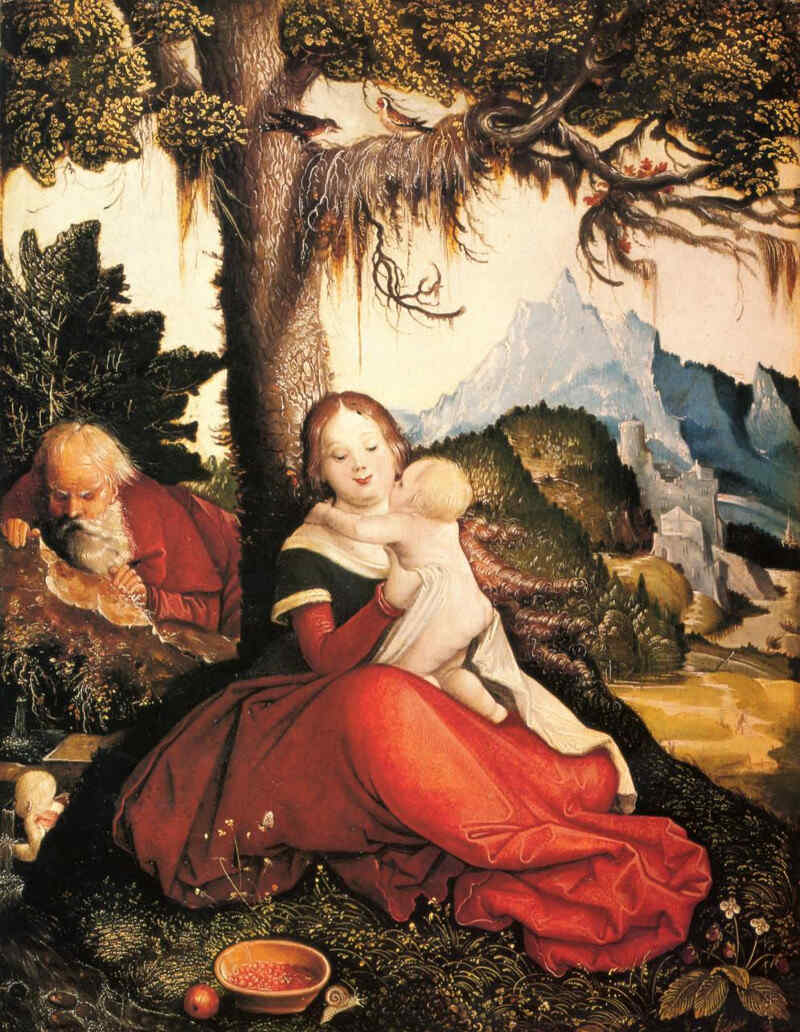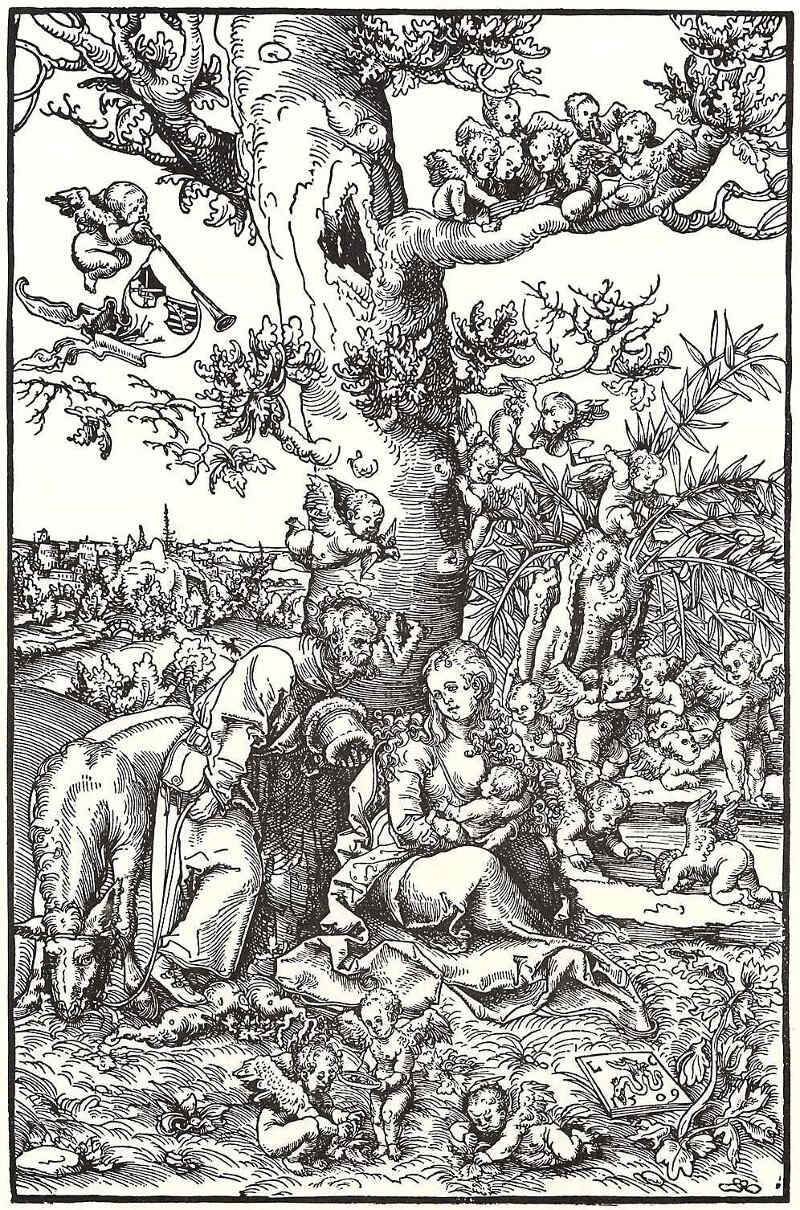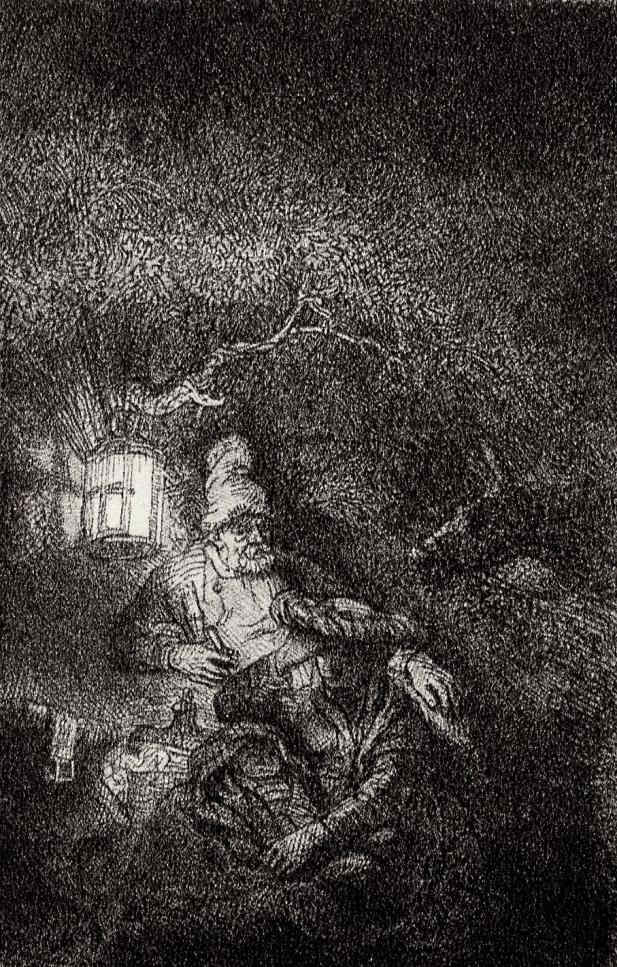| 292. The History of Art I: Representations of the Nativity
02 Jan 1917, Dornach Tr. Unknown Rudolf Steiner |
|---|
| Comprising an evolution through several centuries, they will bring before our souls, from another aspect, that which is living in the Old Christmas Plays of which we have been speaking in the last lectures. We shall thus be concerned today, not in the first place with the artistic elements, as such, but with the treatment of a certain theme in the history of Art, and I will therefore speak not so much of the evolution of artistic principles, but draw your attention to some other points of view which may be of interest in relation to these pictures. |
| True, it also came to life, as you know, in the Old Christmas Plays. But the appearance of the Three Wise Men of the East cannot really be understood with the same understanding, as the appearance of Jesus to the Shepherds according to St. |
| You will feel the connection of it with what is given in the old Christmas Plays with which we are familiar. Though the latter belong, of course, to a later time, nevertheless they are from earlier Christmas Plays which are no longer extant. |
| 292. The History of Art I: Representations of the Nativity
02 Jan 1917, Dornach Tr. Unknown Rudolf Steiner |
|---|
Today—since Dr. Trapesnikoff has ordered them—we will show you some pictures arranged from a different point of view than in our former lectures; more from the point of view of subject-matter. The pictures today will relate especially to the birth of Christ Jesus, the Adoration by the Shepherds and by the Three Wise Men, and finally the Flight into Egypt. Comprising an evolution through several centuries, they will bring before our souls, from another aspect, that which is living in the Old Christmas Plays of which we have been speaking in the last lectures. We shall thus be concerned today, not in the first place with the artistic elements, as such, but with the treatment of a certain theme in the history of Art, and I will therefore speak not so much of the evolution of artistic principles, but draw your attention to some other points of view which may be of interest in relation to these pictures. You will, however, bear in mind the general lines of development of Christian Art, which we have described in the past lectures of this series. You will observe the same great trend of evolution, as we pass from the artistic representations of the early Christian centuries into the times of the Renaissance. First you will see the more typical representations of an early time. These, as we have seen, were still under the influence of Revelations from the Spiritual World. Less concerned with naturalistic expressions of form and color, they try to reproduce the spiritual Imaginations, revealed out of the Spiritual World. Thenceforward you will see this Christian Art evolve towards Naturalism, that is, towards a certain reproduction of that which may be called reality from the point of view of the physical plane. As we follow the evolution of this Art, the sacred personalities stand before us in a more and more human form. We shall first show some pictures relating more especially to the Birth of Christ. Then we shall show the Adoration of the Child by the Shepherds; indeed, these two, to some extent, will go together. The next series of pictures will deal mainly with the story of the Three Wise Men of the East—the Magi. Here I beg you to observe how the two streams evolve: the stream of St. Luke's Gospel, as we may call it, and that of the Gospel of St. Matthew. They are the streams which take their start from the two Jesus Children. Artistically, too, we can recognise the difference. The Adoration by the Shepherds—all that is more or less related to this theme—could best be understood (understood, that is to say, by the inner feelings) under the influence of what remained from those Northern Mysteries whose center, as I told you, was in Denmark. This stream is connected with all that related to the Birth of Jesus—springing forth, as it were, with Jesus, out of the earthly evolution, out of the spiritual beings that are bound up with the life of Nature. In the Adoration by the Magi, on the other hand—the mission of the Three Wise Men from the East—we always find a direct expression of the “Gnostic” stream. Under the influence of the “Star”—which means, something that is made known out of the Cosmos—the Wise Men draw near to the Christ Who heralds His approach and develops in the Zarathustra Jesus. In all that is connected with the Adoration by the Three Wise Men, we have, therefore the Gnostic stream: the consciousness that the Christ-Event was a cosmic one; that a fertilisation of the Earth had taken place out of the Cosmos. Our friends have been kind enough to put up here a drawing of the Three Wise Men. The picture is taken from an old Gospel Book. We see them looking up in adoration, that is, in quest of spiritual knowledge, by striving upward with all their inner being, and looking up to the Star wherein the Spirit Who shall liberate the Earth draws near.
1. Three Wise Men. It may truly be said that this stream, which finds expression in St. Matthew's Gospel, was less and less understood in the further course of centuries. True, it also came to life, as you know, in the Old Christmas Plays. But the appearance of the Three Wise Men of the East cannot really be understood with the same understanding, as the appearance of Jesus to the Shepherds according to St. Luke's Gospel. For the latter is a simple understanding of the heart, of inner feeling; while the understanding which we must bring to bear on all that is connected with the Wise Men from the East must needs be of a “Gnostic” character. All that is signified by the Wise Men “following the Star” will only come into the consciousness of humanity again when—not the Gnosis this time, it is true—but anthroposophical Spiritual Science gains acceptance. Finally, we shall show some pictures of the Flight into Egypt. This, too, is connected with the “Gnostic” Revelation concerning Jesus Christ. We cannot speak of it at great length today; we may return to it another time. To begin with, it is important here, again, to realise that there is a certain underlying composition in all that the Gospels contain. The composition is always important. We need only faithfully follow the Gospel narrative. The Flight into Egypt appears in direct connection with the Mission of the Three Wise Men. It happens, as it were, on the basis of what was first undertaken by the Three Wise Men. This bears witness to the fact that the Gospel is taking into account the connection with all that was related about Egypt in the Old Testament. Moses was learned in the Wisdom of the Egyptians. Now we are told in the Gospel that the Three Wise Men of the East came to the birthplace of Christ Jesus, led by the Star which is really the Star of Christ. But it goes on to relate that something now had to take place which did not entirely accord, as it were, with the course of the Star; something which was not in the consciousness of the Wise Men themselves—for so the Gospel explicitly tells us. Here we are shown one of those cases where the astrological determination, as it were, of certain great events has to be broken through. How precisely the astrological determination corresponds to what is known of the historic facts—you could see this from the instance which we spoke of recently. Our friends drew up the Horoscope for that point in the course of Time which was indicated as the day of Christ Jesus's Death. But we see that the Jesus Child, in whom the Zarathustra Soul was living, had to be taken out of the domain of this Star. He was taken into Egypt, and from Egypt He was then led back again into the realm of the Star. In this is contained the whole Mystery of the ebbing away of that ancient stream of evolution which had grown atavistic in the Egyptian Gnosis. The new Revelation had to enter once more into a certain union with the Old in order that it might free itself consciously. These are the underlying Mysteries, and though they are little recognised, none the less they lie inherent in the composition. I may take this opportunity to point out once more, how important it is to pay attention to the composition when we read the Gospels. For the text is frequently corrupt and can only be read in its true form by those who are able to read with the help, if I may say so, of the Occult Text. Notably in the translations, naturally enough, the text is often quite unintelligible. But in the composition (compare my Lecture Cycle held in Cassel on the Gospel of St. John)—in the composition there is something which will strike any reader immediately, if he reads the Gospel carefully. One more remark I would like to make, before we go on to show the pictures. The materialistic consciousness of our age has altogether lost the point of view which would indicate such inner connections as underlie the revelation to the Three Wise Men. Whatever goes by the name of Astrology today has fallen into the hands of utter dilettanti, who carry on all kinds of nonsense and abuses with it. Few people nowadays are in true earnest when they speak of that relation of the Earth to the Cosmos which finds expression in actual physical relationships—in the constellations of the Stars. On the other hand, for the official Science of today Astrology of whatever kind is a mere antiquated superstition. Nevertheless, the knowledge of these things did not decay or die out absolutely until the 18th century. Even as late as the 18th century people still spoke of something which is of extreme importance if we wish to understand the deep, deep truths that underlie the appearance of the Three Wise Men. In the 18th century, those who had still preserved some knowledge of the old Initiations spoke of the significance of the physical constellations. But not only so: they also spoke of the significance of invisible constellations. Even in the 18th century it was expressly stated in certain circles who possessed Initiation Knowledge. “There are also Stars which only the Initiate can see.” This is a true statement, and this, above all, must be taken into account if we wish to understand why it was that “Imaginations” appeared to the Shepherds, while “Stars” appeared to the Three Wise Men. Such is the indication: The Revelation came to the Shepherds inasmuch as they still had dreamlike clairvoyance in the old atavistic sense. But the Wise Men of the East had their knowledge through the ancient Science that had been handed down. Through this they knew of the relation between the Cosmos, the Heavens and the Earth. Through this they knew—could calculate, as it were—what was drawing near. Hence we can see in the evolution of these pictures—and you will now have opportunity to observe it for yourselves—we see, with all the transition to Naturalism, the pictorial representations growing less and less adequate to the theme of the Wise Men. For the Wise Men or Magi, the most ancient and typical representations are the most fitting. For the real truth that is intended in this story is lifted right out of the earthly domain. On the other hand, the representations of Jesus grow the more intimate and tender, the more naturalistic they become. For in this case the naturalistic quality is fitting. All that goes out to meet the approaching Christ from the physical plane—all that is connected, therefore, with the life of Nature—is naturally best portrayed by such means. We will now go on to the pictures, first of the Nativity itself and of the Adoration by the Shepherds, and then of the Three Wise Men or Kings.
2. The Nativity. (mosaic) (Palermo, Chiesa della Martorana.) In these old compositions, as you see, everything is conceived in typical form—based on the typical representations of the ancient Myths which came over largely from the East. In a most natural way the typical representations of the Myth grew into the representations of the Christian theme. The Orpheus type, for instance, the type of the Good Shepherd, was handed down from earlier representations of Myth or Cult or Ritual, and taken to represent the new impulse, the Christ event; and so it was with many another theme and composition.
3. A Page of the Biblia Pauperum. 1st Edition. (15th century) The Nativity, etc. (German Woodcuts.) These early Bibles generally showed parallel representations from the Old and New Testaments. They bore in mind that the New Testament is the fulfilment of the Old; this idea is brought out again and again in these “Bibles of the Poor.” The Nativity, which interests us mainly now, is shown in the middle of the page.
4. The Nativity, 11th Century. (Limburg Monestary.) This is at Cologne. Beneath is the Flight into Egypt; the two are together in this slide. Apart from this one, we shall show the Flight into Egypt at the end of the lecture. Here you have a beautifully naive conception of the Nativity. You will feel the connection of it with what is given in the old Christmas Plays with which we are familiar. Though the latter belong, of course, to a later time, nevertheless they are from earlier Christmas Plays which are no longer extant.
5. The Flight into Egypt. (Evangeliar of the 12th century. Cathedral of Cologne.) It is interesting to see, all around the picture, representations of what was cosmically connected with the Event, showing how they were still aware of the spiritual relationships. And now we will take the same motif as it appears in the work of Niccola Pisano.
6. Niccola Pisano. The Nativity. (Baptistery at Pisa.)
7. Giotto. The Nativity. (San Francesco. Assisi.) You see how the representations of the theme are gradually passing into Naturalism.
8. della Robbia. The Nativity. (Hamburg. Altarpiece.) (National Museum. Florence.)
9. Meister Francke. The Nativity. (Hamburg.) This picture is at Hamburg; I remember having seen it there myself not long ago.
10. Philippo Lippi. The Nativity. (Cathedral at Spoleto.) You really see how in the course of time Naturalism takes hold of it more and more.
11. Piero della Francesca. The Nativity. (National Gallery. London.) Here we are in the fifteenth century once more; and we now go on to Correggio.
12. Correggio. Holy Night. (Dresden.) We pass again to the more Northern Masters, whose names you know. First we have a work of Schongauer' s.
13. Martin Schongauer. The Nativity. (Alto Pinakothek. Munich.) Most interesting to see the Italian and the Northern Masters one after the other. In the former you still find a stronger adherence to ideal types, while here there is more individualisation—creation out of inwardness of soul, as we have seen before. Down to the tiny feet, all is pervaded with feeling, albeit the artistic perfection is not so great as in the Southern Masters.
14. Herlin. Nativity from the Altar of St. George. (Museum at Nordlingen.) We come now to the turn of the 15th and 16th centuries, to Albrecht Dürer.
15. Dürer. The Nativity. (Alto Pinakothek. Munich.) See how the Art is taken hold of here by all that I described to you—the working out of the element of light. It is most interesting to study this in Dürer.
16. Altdorfer. The Holy Night. (Berlin.) Altdorfer was Dürer's successor in Nuremberg. We shall now give a series of pictures relating mainly to the Adoration by the Shepherds. First, some older Miniatures from Bible and Gospel Manuscripts.
17. Nativity and Annunciation to the Shepherds. (Codex Egberti. Trier. 10th century.)
18. Nativity and Annunciation to the Shepherds, from Menologion of Basil II (Vatican. Rome. 11th Century.) We go on to the Italian representations of the Adoration of the Child by the Shepherds.
19. Cimabue. Adoration by the Shepherds. (Assisi.) With Cimabue, as you know, we find ourselves in the 13th century. We go on into the 15th and come to Ghirlandajo, the Master of whom we lately spoke.
20. Ghirlandajo. Adoration by the Shepherds. (Akademia. Florence.) Another Master of the 15th century is Piero di Cosimo.
21. Piero di Cosimo. Adoration by the Shepherds. (Berlin.) And now we come to the Art of the Netherlands, with which we are familiar.
22. Hugo van der Goes. Adoration of the Child. (Uffizi. Florence.)
23. Hugo van der Goes. Adoration of the Child. (detail.) Finally we give two works by Rembrandt.
24. Rembrandt. Adoration by the Shepherds. (In the Lantern Light. Etching, about 1652.)
25. Rembrandt. Adoration by the Shepherds. (Alte Pinakothek. Munich.) We now go on to the pictures representing the Adoration by the Three Wise Men. To begin with, an old Mosaic, of the 6th century.
26. Mosaic. Chiesa della Martotana. Palermo. Three Wise Men.
27. Mosaic. Sant Apollinare Nuovo. Ravenna. In these older pictures the events are shown thoroughly in connection with the Spiritual World—remote from all Naturalism, lifted into a higher sphere.
28. Nativity and Adoration by the Wise Men. (Menologium Basilius. Vatican. 11th century)
29. Niccola Pisano. Adoration by the Wise Men. (Baptistery at Pisa.) This is the famous Golden Gate at Freiberg, second half of the 12th century:
30. Adoration by the Three Wise Men. (Cathedral of Freiberg. The Golden Gate.)
31. Domenico Veneziano. Adoration by the Wise Men. (Berlin.) Formerly attributed to Pisanello (Vittore Pisano). We go on to the 15th, to Stephen Lochner:
32. Stephen Lochner. Adoration by the Three Wise Men. (Cathedral of Cologne.) The next is by Gentile da Fabriano, also of the 15th century.
33. Gentile da Fabriano. Adoration of the Child. (Florence.)
34. Fra Angelico. Adoration of the Kings. (St. Marco. Florence.) Fra Angelico is as tender and lovely in this as in all other subjects.
35. Filippo Lippi. Adoration by the Wise Men. Whichever subject it is, you see how Naturalism progresses. This is especially interesting when one follows the treatment of one and the same subject through the centuries.
36. Sandro Botticelli. Adoration by the Wise Men. (Uffizi. Florence.) Now we come to the second half of the 15th century.
37. Ghirlandajo. Adoration by the Wise Men. (Spedale degli Innodenti. Florence.) End of the 15th century:
38. Mantegna. Adoration by the Wise Men. (Uffizi. Florence.)
39. Giorgione. The Wise Men of the East. (Vienna.)
40. Giorgione. Adoration by the Wise Men. (National Gallery. London.)
41. Giovanni Bellini. Adoration by the Kings. (Layard Gallery. London.) And now I ask you to call to mind once more the various Dutch and Flemish Masters of whom we have spoken in a former lecture. For we now have the same subject by
42. Rogier van der Weyden. Adoration by the Kings. (Alte Pinakothek.Munich)
43. Dieric Bouts. Adoration by the Wise Men. (Alte Piankothek. Munich.)
44. Adoration by the Wise Men, 15th centry, from the Brevarium Grimani. We have spoken of the characte of these painters. The next is by the artist who worked in Bruges and died about 1523.
45. Gerard David. Adoration by the Wise Men. (Alte Pinakothek. Munich.) And now the same theme treated by Leonardo.
46. Leonardo da Vinci. Adoration by the Three Wise Men. (Uffizi.Florence) And by his pupil,
47. Luini Bernadino. Adoration by the Wise Men. (Saronno.) Going North again:
48. Dürer. Adoration by the Wise Men. (Uffizi. Florence.)
49. Brueghel. Adoration by the Wise Men. (Vienna.) And finally, Rembrandt.
50. Rembrandt. Adoration by the Three Wise Men. (Buckingham Palace.) And now we come to our last theme: the Flight into Egypt. First we have a painter of the late 15th and early 16th century.
51. Herrad von Lanndsberg. The Flight into Egypt.
52. Joachim de Patinir. Rest in the Flight. (Prado. Madrid.)
53. Correggio. Madonna della Scodella. (Parma) The next, a little later.
54. Bernhard Strigel. The Flight into Egypt. (Stuttgart.) Strigel painted also in Vienna, and died in 1528.
55. Albrecht Dürer. Resting on the Flight into Egypt.
56. Workshop of Albrecht Dürer. Resting on the Flight into Egypt. Next is Hans Baldung or Hans Grun, going on into the 16th century.
57. Hans Balding (Baldung). Rest in the Flight. (Germanisches Museum. Nuremberg.)
58. Lucas Cranach. Rest in the Flight. (Berlin.) Finally, Rembrandt:
59. Rembrandt. Rest in the Flight. (Etching.) So much for today. Perhaps you will now take the opportunity to see at close quarters this impressive picture of the Wise Men which indicates so clearly the worship of the Star with the incoming of the Christ Jesus Soul. |
| 236. Karmic Relationships II: The Esoteric Trend in the Anthroposophical Movement
12 Apr 1924, Dornach Tr. George Adams, Mabel Cotterell, Charles Davy, Dorothy S. Osmond Rudolf Steiner |
|---|
| Again and again it must be emphasised that a new trend has come into the Anthroposophical Movement since the Christmas Foundation Meeting at Dornach. Of this I should now like to say a few introductory words.—You know, my dear friends, that since the year 1918 there have been all manner of undertakings within the Anthroposophical Society. |
| You see, my dear friends, that is something quite different from what the position would have been if already at that time (as at our Christmas Foundation Meeting) I had said that I would undertake the leadership of the Society. For the Anthroposophical Society, if led by me, must naturally be an altogether different thing than if led by someone else. |
| Through the whole tenor of the Anthroposophical Movement as it has been since Christmas last, this will perhaps be realised increasingly, even by our members. Henceforth the Anthroposophical Movement will take this attitude: It will no longer pay heed to anything other than what the spiritual world itself requires of it. |
| 236. Karmic Relationships II: The Esoteric Trend in the Anthroposophical Movement
12 Apr 1924, Dornach Tr. George Adams, Mabel Cotterell, Charles Davy, Dorothy S. Osmond Rudolf Steiner |
|---|
It is a little difficult to continue what has been given in the last lectures, because so many friends who have not taken part in these studies are here to-day. On the other hand it is hardly possible to make a new beginning, for many things contained in the previous lectures have still to be completed. Friends who have just arrived will have to realise that if some of our thoughts to-day prove somewhat difficult to understand, it is because they are connected—inwardly, though not outwardly—with preceding lectures. At Easter we shall have a self-contained course, but to-day I must continue what has gone before. We did not expect so many friends at this date, although needless to say we are extremely glad that they have come. In recent lectures we have been speaking of definite karmic relationships—not with the object of finding anything sensational in the successive earthly lives we have studied, but in order to arrive step by step at a really concrete understanding of the connections of destiny in human life. I have described successive earthly lives of certain historic figures, in order to call forth an idea of how one earthly life works on into the next—and that is not an easy matter. Again and again it must be emphasised that a new trend has come into the Anthroposophical Movement since the Christmas Foundation Meeting at Dornach. Of this I should now like to say a few introductory words.—You know, my dear friends, that since the year 1918 there have been all manner of undertakings within the Anthroposophical Society. Their origin is clear. When the Anthroposophical Society was founded, this question was really being asked, out of a deep occult impulse: Would the Anthroposophical Society continue to evolve by virtue of the inner strength which (in its members) it had acquired until then? There was only one way to make the test. Until then, I, as General Secretary, had had the leadership of the German Section, which was the form in which the Anthroposophical Movement had existed within the Theosophical Society. The only way now was for me no longer to take in hand the leadership of the Anthroposophical Society but to watch and see how this Society would evolve through its own inherent strength. You see, my dear friends, that is something quite different from what the position would have been if already at that time (as at our Christmas Foundation Meeting) I had said that I would undertake the leadership of the Society. For the Anthroposophical Society, if led by me, must naturally be an altogether different thing than if led by someone else. Moreover, for certain deep reasons, the Society might have been led all the better if I myself had not had the administrative leadership. Many things might have been done if human hearts had spoken—things which in fact remained undone, or which were even done from outside, often enough under resistance from the anthroposophists. During the War, of course, we had little opportunity to unfold our forces in all directions. So it came about that after the year 1918, the prevailing state of affairs was taken advantage of by those from many quarters who wanted to do this or that. If I had said at the time, “No, these things shall not be done”, then of course we should hear it said to-day: “If this or that had only been allowed, we should now have numbers of flourishing undertakings.” For this very reason it was the custom at all times for the leaders of occult movements to let those who wanted to do something try it out and see what became of it, so that convictions might be called forth by the facts themselves. For that is the only way to call forth conviction. And so it had to be in our case too. The upshot of it all has been that since the year 1918, opposition to our Movement has grown rife, and has brought about the present state of affairs, when it is impossible for me, for instance, to give public lectures in Germany. At the present moment these facts must in no way be concealed from the Anthroposophical Movement. We must face them with all clarity. As long as we work with unclear situations we shall make no progress. As you know, all manner of experiments were made in the hope of being ‘truly scientific’—shall we say? Quite naturally so, in view of the characters of those concerned! Scientists who also partake in our Society naturally like to be scientific. But that is the very thing that annoys our opponents. When we say to them, “As scientists we can prove this or that truth”, they come forward with all their so-called scientific claims, and then of course they become furious. We should be under no illusions on this point. Nothing has annoyed our opponents more than the fact that our members have tried to speak on the same subjects as they themselves do, and in the same manner, only—as these our members often used to say—“letting a little Anthroposophy flow into it.” It was precisely this which called forth our opponents in such overwhelming numbers. Again, we offend most strongly against the life-conditions of Anthroposophy if we give ourselves up to the illusion that we can win over the adherents of various religious communities by saying the same or similar things as they, only once more “letting Anthroposophy flow into it.” But now, since the Christmas Foundation Meeting, an entirely new element must come into all that is being done in the field of Anthroposophy. Those of you who have observed the way Anthroposophy is now being presented here, or the way it was presented at Prague and again at Stuttgart, will have observed that impulses are now at work which call forth something altogether new, even where our opponents are concerned. If we try to be ‘scientific’ in the ordinary sense of the word—as, unfortunately, many of our members have tried to be—then we are presuming, so to speak, that it is possible to enter into discussion with them. But now take the lectures that have been given here, or the lectures at Prague, or the single lectures at Stuttgart—can you believe for a single moment that there can be any question of entering into discussion with our opponents on these matters? It goes without saying: we can enter into no discussion with our opponents when we speak of these things. How, for example, should we discuss with any representative of the civilisation of to-day the statement, for example, that the soul of Muavija appeared again in the soul of Woodrow Wilson?1 Thus in the whole Anthroposophical Movement there is now a prevailing quality which can tend to nothing else than this.—We must take it at last in real earnest that there can be no question of entering into discussion or argument with our opponents. For if we do so, it will in any case lead nowhere. Thus we must realise that, with regard to our opponents, it can only be a question of refuting calumnies, untruths and lies. We must not give up ourselves to the illusion that these things can be discussed. They must expand by their own inherent power; they cannot be decided by any dialectic. Through the whole tenor of the Anthroposophical Movement as it has been since Christmas last, this will perhaps be realised increasingly, even by our members. Henceforth the Anthroposophical Movement will take this attitude: It will no longer pay heed to anything other than what the spiritual world itself requires of it. It is from this standpoint that I have placed before you various thoughts on karma. Those of you who were here, or who heard my last lecture at Stuttgart, will remember that I tried to show how the individualities who lived in the 8th and 9th centuries A.D. at the Court of Haroun al Raschid in Asia, having continued to evolve after death in different directions, played certain definite parts in their new incarnations. At the time of the Thirty Years' War (and a short time before) we have on the one hand the individuality of Haroun al Raschid, reincarnated in the Englishman, Bacon of Verulam. And a great organiser at the Court of Haroun al Raschid, who had lived at the Court—not indeed as an Initiate, but as the reincarnation of an Initiate—this individuality we found again as Amos Comenius, whose field of action was rather in Middle Europe. From these two streams, much in the spiritual part of modern civilisation flowed together. In the spiritual and intellectual aspect of modern civilisation, the Near East—as it was in the time immediately after Mohammed—lived again, on the one hand through the reincarnated Haroun al Raschid, Bacon of Verulam; and on the other hand through Amos Comenius, who had been his counsellor. In the present lecture I wish to emphasise the following fact:—The evolution of man does not merely take place when he is here on earth, but also when he is between death and a new birth. Bacon as well as Amos Comenius, having fastened Arabism—so to speak from two different sides—on to the civilisation of Europe, died again and passed into the life between death and a new birth. And there they were together with many souls who came down to earth after their time. Bacon and Amos Comenius, having died in the 17th century, lived on in the spiritual world. Other souls, who came down to earth in the 19th century, were in the spiritual world together with the souls of Bacon and Amos Comenius from the 17th to the 19th. On the one hand there were souls who gathered mainly around the soul of Bacon—Bacon whose work became so dominant. Then there were the souls who gathered around Amos Comenius. And though this is rather a pictorial way of speaking, we must not forget that there are ‘leaders’ and ‘followers’—albeit under quite different conditions—even in the spiritual world which men pass through between death and a new birth. Such individualities as Bacon or Amos Comenius worked not only through what they brought about on earth—through their writings, for example, or through the traditions of them which lived on on earth. No, these leading spirits were also working through the souls whom they sent down, or the souls with whom they were together and who were then sent down; they worked by causing certain tendencies to germinate in these souls in the spiritual world. Thus among the men of the 19th century we find souls who had become dependent already in their evolution in the pre-earthly life on one or other of these two spirits—the discarnate Amos Comenius, and the discarnate Bacon. As I said, I want to lead you more and more into the concrete way in which karma works. Therefore I will now draw your attention to two personalities of the 19th century whose names will be known to most of you. One of them was especially influenced in his pre-earthly life by Bacon, and the other by Amos Comenius. If we observe Bacon as he stood in earthly civilisation—in his earthly life as Lord Chancellor in England—if we observe him there, we find that his working was such that an Initiate stood behind him. The whole Bacon-Shakespeare controversy, as it is outwardly pursued by the historians of literature, is appallingly barren. All manner of arguments are brought forward which are supposed to show that Shakespeare the actor did not really write his dramas, but that they were written by Bacon the philosopher and Lord Chancellor, and so on ... All these things—working with external methods, seeking out similarities in the way of thought in Shakespeare's dramas and Bacon's philosophic works—all these are barren superficialities. They do not get at the real truth. For the truth is that at the time when Bacon, Shakespeare, Jacob Boehme, and a fourth were working on the earth, there was one Initiate who really spoke through all four. Hence their kinship, for in reality it all goes back to one and the same source. Of course, these people who dispute and argue do not argue about the Initiate who stood behind, especially as this Initiate—like many a modern Initiate—is described to us in history as a rather intolerable fellow. But he was not merely so. No doubt he was so sometimes in his external actions, but he was not merely so. He was an individuality from whom immense forces proceeded, and to whom were really due Bacon's philosophic works as well as Shakespeare's dramas and the works of Jacob Boehme, and also the works of the Jesuit, Jacob Balde. If we bear this in mind, then we must see in Bacon, in the philosophic realm, the instigator of an immense and far-reaching stream of the time. It is most interesting to observe what could become of a soul who lived throughout the two centuries, in the life beyond the earth, under the influence of the dead Bacon. We must turn our attention to the way in which Bacon himself lived after his death. For our studies of human history it will in fact be more and more important to observe the human beings who have lived on earth not only until the moment of their death but in their working beyond death, where they work on and on upon those souls who are afterwards to descend to earth. This applies especially to those who have themselves been responsible for great spiritual achievements. No doubt these things may be somewhat shocking for men of the present time. So for instance I remember—if I may make this digression—I remember on one occasion I was standing at the entrance to the railway station in a small German University town with a well-known doctor who went in a great deal for occultism. Around us stood many other people. Presently he warmed up to his subject and out of his enthusiasm said to me in a loud voice, so that many of those who were around could hear him: “I will make you a present of the biography of Robert Blum; but that is a biography which begins only after his death.” Spoken loudly as it was, one could well observe the shock it gave to those who were standing around us! One cannot say without more ado to the people of to-day, “I will make you a present of the biography of a man, but it begins only after his death.” For the rest—apart from this two-volumed biography of Robert Blum, which begins not with his birth but with his death—little has yet been done in the way of relating the biographies of men after their death. Biographies generally begin at birth and end at death; there are not yet many works that begin with a man's death. Yet, for the real happenings of the world, what a man does after his death is immensely important, notably when he passes on the results of what he did on earth—translated into the spiritual—to the souls who come down after him. We cannot understand the age which succeeds a given age if we do not observe this side of life. Now I was specially interested in observing those individualities who surrounded Bacon after his death. Among them were individualities who were subsequently born as natural scientists. But there were also others who were born as historians; and if we observe the influence of the dead Lord Bacon on these souls, we see how the materialism which he founded upon earth—the mere researching into the world of sense (for, as you know, everything else was for him an ‘idol’)—translated into the spiritual, reverts into a kind of radicalism. And so indeed, in the very midst of the spiritual world, these souls received impulses which worked on in such a way that after their birth, having descended to the earth, they would attach no value to anything that was not a concrete fact visible to the senses. I will now speak in a somewhat popular form, but I beg you not to take my words too literally, for if you do so it will of course be only too easy to say: ‘How grotesque!’ Among these souls there were also some who, by their former tendencies—derived from former earthly lives—were destined to become historians. And among them was one who was the greatest. (I am still speaking of the pre-earthly lives of all these souls). One among them was the greatest. Under the influence of Lord Bacon's impulses, all these souls said to themselves, in effect: It is no longer permissible to write history as it was written in former times, to write it with Ideas, investigating the inner connections. Only the actual facts must now be the object of our research. Now I ask you, what does this mean? Are not the intentions of men the most important thing in history?—and they are not outwardly real! These souls, however, no longer permitted themselves to think in this way; and least of all did the soul who afterwards appeared again as one of the greatest historians of the 19th century—Leopold von Ranke. Leopold von Ranke was a pre-earthly disciple of Lord Bacon. Study the earthly career of Leopold von Ranke as a historian. What is his principle? Ranke's principle as a historian is this: nothing must be written in history save what is to be read of in the archives. We must compile all history from the archives—from the actual transactions of the diplomats. If you read Ranke you will find it so. He is a German and a Protestant, but with his sense of reality this has no effect on him. He works objectively—that is to say, with the objectivity of the archives. So he writes his History of the Popes—the best that has ever been written from the pure standpoint of archives. When we read Ranke we are irritated, nay dreadfully so. It is a barren prospect to imagine the old gentleman—quick and alert as he was until a ripe old age—sitting forever in the archives and merely piecing together the diplomatic transactions. That is no real history. It is history which reckons only with the facts of the sense-world—that is to say, for the historian, with the archives. And so indeed, precisely by taking into account the life beyond the earth we have the possibility to understand why Ranke became what he was. But now we can also look across to Amos Comenius, and observe how he worked on the pre-earthly willing of souls who afterwards descended to the earth. For just as Leopold von Ranke became the greatest disciple of Bacon—of Bacon after his death—so did Schlosser become the greatest disciple of Comenius after his death. Read Schlosser's History; observe the prevailing tone, the fundamental note he strikes. On every page there speaks the moralist—the moralist who would fain seize the human heart and soul—whose object is to speak right into the heart. Often he scarcely succeeds, for he is still rather a pedant. He speaks, in effect, like a pedant speaking to the heart. Nevertheless, being a pre-earthly disciple of Amos Comenius, he has absorbed something of the quality that was in Comenius himself, who was so characteristic by virtue of the peculiar quality of his spirit. For after all, Comenius too came over from Mohammedanism. Though he was very different from the spirits who gathered around Lord Bacon, nevertheless Comenius too, in his incarnation as Comenius, concentrated on the real, outer world. Everywhere he demanded visibility, objectivity, in education. There must always be an underlying picture. He demands vision—object lessons, as it were; he too lays stress on the sense-perceptible, though in quite another way. For Amos Comenius was also one of those who at the time of the Thirty Years' War believed most enthusiastically in the coming of the so-called Millennium. In his Pansophia he wrote down great and world-embracing ideas. He wanted to work for human education by a great impulsive power. This too worked on Schlosser. It is there in Schlosser. I mention these two figures—Ranke and Schlosser—in order to show you how we can understand what appears as the spiritually productive power in man only if we also take into account his life beyond the earth. Only then do we understand it—just as we have also learnt to understand many things by taking into account repeated lives on earth. For in the thoughts which I have recently placed before you, we have observed this marvellous working across from one incarnation to another. As I said, I give these examples in order that we may then consider how a man can think about his own karma. Before we can dwell on the way in which good and evil—or illnesses or the like—work over from one incarnation to another, we must first learn to perceive how that which afterwards emerges in the spiritual and intellectual life of civilisation also works across from one incarnation to another. Now my dear friends, I must admit that for me one of the most interesting personalities in modern spiritual life, with regard to his karma, was Conrad Ferdinand Meyer. Anyone who observes him closely will see that his most beautiful works depend on a peculiar fact, namely this: Again and again, in his whole human constitution, there was a kind of tendency for the Ego and astral body to flee from the physical and the etheric bodies. Morbid conditions appear in Conrad Ferdinand Meyer, bordering very nearly on dementia. But these morbid conditions only express in a rather more extreme form what was always present in him in a nascent state. His soul-and-spirit tends to go out—holds to the physical and etheric only by a very loose thread. And in this condition—the soul-and-spirit holding to the physical and etheric by a very loose thread only—the most beautiful of his works originate; I mean the most beautiful of his longer works and of his shorter poems too. Conrad Ferdinand Meyer's most beautiful poems may even be said to have originated half out of the body. There was a peculiar relationship between the four members of his nature. Truly there is a great difference between such a personality and an average man of the present time. With an average man of this materialistic age we generally find a very firm and robust connection of the soul-and-spirit with the physical and etheric. The soul-and-spirit is deeply immersed in the physical and etheric—‘sits tight’, as it were. But in Conrad Ferdinand Meyer it was not so. He had a very tender relation of the soul-and-spirit to the physical and etheric. To describe his psyche is really one of the most interesting tasks one can undertake when studying the developments of modern spiritual life. Many things that emerge in Conrad Ferdinand Meyer appear almost like a dim, cloudy recollection—a recollection which has however grown beautiful in growing dim. When Conrad Ferdinand Meyer writes we always have the feeling: He is remembering something, though not quite exactly. He changes it—but changes it into something beautiful and form-perfected. We can observe this wonderfully, piece by piece, in certain of his works. Now it is characteristic of the inner karma of a human being when there is such a definite relationship of the four members of his nature—physical body, etheric body, astral body and Ego. And in Conrad Ferdinand Meyer's case, when we trace back this peculiarly intimate connection, we are led, first of all, to the time of the Thirty Years' War. This was the first thing clear to me in his case: there is something of a former earthly life at the time of the Thirty Years' War. And then there is a still earlier life on earth going back into the pre-Carlovingian age, going back quite evidently into the early history of Italy. When we endeavour to trace Conrad Ferdinand Meyer's karma, the peculiar, intangible fluidity of his being (which none the less expresses itself in such perfection of form)—the peculiar, intangible fluidity of his life somehow communicates itself to our investigation, until at length we feel: We are getting into confusion. I have no other alternative but to describe these things just as they happened in the investigation. We go back into the time of the 6th century in Italy. There we have the feeling: We are getting into an extraordinarily insecure element. We are driven back again and again, and only gradually we observe that this is not due to ourselves but to the object of our research. There is really in the soul—in the individuality—of Conrad Ferdinand Meyer something that brings us into confusion as we try to investigate him. We are driven to return again and again into his present incarnation or into the one immediately before it. Again and again we must ‘pull ourselves up’ and go back again. The following was the result.—You must remember, all that has lived in a human soul in former incarnations becomes manifest in the most varied forms—in likenesses which are often quite imperceptible to outer observation. This you will have seen from other instances of reincarnation given here. So at length we come to an incarnation in Italy in the early Christian centuries—at the end of the first half of the first millennium A.D. Here we come to a halt. We find a soul living in Italy, to a large extent at Ravenna, at the Roman Court. But now we come into confusion. For we must ask ourselves: What was living in that soul? The moment we ask ourselves this question (in order to call forth the further occult investigation), the whole thing is extinguished once again. We become aware of the experiences which this soul underwent while living at the Court at Ravenna—at the Roman Court. We enter into these experiences and we think we have them, and then again they are extinguished—blotted out from us; and we are driven back again to Conrad Ferdinand Meyer as he lived on earth in the immediate past. At length we perceive that in this later life he obliterates from our vision the content of his soul in the former life. Only after long trouble do we perceive at length how the matter really stands. Conrad Ferdinand Meyer—or rather the individuality who lived in him—was living at that time in a certain relationship to one of the Popes who sent him, among others, to England on a Roman Catholic, Christian Mission. The individuality who afterwards became Conrad Ferdinand Meyer had first absorbed all that wonderful sense of form which it was possible to absorb in Italy at that time. The Mosaic art of Italy bears witness to it; also the old Italian painting, the greater part, nay practically the whole of which has been destroyed. This art did not continue. And then he went on a Roman Catholic Christian Mission to the Anglo-Saxons. One of his companions founded the Bishopric of Canterbury. What afterwards took place at Canterbury began essentially with this foundation. The individuality, however, who after-wards appeared as Conrad Ferdinand Meyer, was only there as a witness, so to speak. Nevertheless, he was a very active person, and he called forth the ill-will of an Anglo-Saxon chieftain, at whose investigation he was eventually murdered. That is what we find to begin with. But while he lived in England there was something in the soul of this Conrad Ferdinand Meyer which robbed him of real joy in life. His soul was deeply rooted in the Italian art of his time—or, if we will call it so, in the Italian spiritual life. He gained no happiness in the execution of his missionary work in England. Yet he devoted himself to it with great intensity—so much so that his assassination was a reaction to it. This constant unhappiness—being repelled from something which he was none the less doing with all force and devotion out of another impulse in his heart—worked on in such a way that when he passed through his next earthly life there ensued a cosmic clouding-over of his memory. The inner impulse was there but it no longer coincided with any clear concept. And so it came about that in his subsequent incarnation as Conrad Ferdinand Meyer, an undefined impulse was at work in him, to this effect: ‘I was once working in England. It is connected somehow with Canterbury. I was murdered owing to my connection with Canterbury.’ So indeed the outer life of Conrad Ferdinand Meyer in this incarnation takes its course. He studies outer history, he studies Canterbury, studies what happened in Canterbury, in connection with the history of England. He comes across Thomas à Becket, Chancellor of King Henry II in the 12th century. He learns of the strange destiny of Thomas à Becket, who from being the all-powerful Chancellor of Henry II, was murdered virtually at his instigation. And so in this present incarnation as Conrad Ferdinand Meyer, his own half-forgotten destiny appears to him in Thomas à Becket. It comes before him, half-forgotten in his subconsciousness, for I am speaking of course, of the subconscious life which comes to the surface in this way. So he describes his own fate in a far distant time. But he describes it in the story of what actually happened in the 12th century between King Henry II and Thomas à Becket of Canterbury, whose fate he recounts in his poetic work Der Heilige (The Saint). So indeed it is—only all this takes place in the subconscious life which embraces successive incarnations. It is as though within a single earthly life a man had experienced something in his early youth in connection with a certain place. He has forgotten it. He experienced it maybe in the second or third year of his life. It does not emerge, but some other similar destiny emerges. The very same place is named, and as a result he has a peculiar sympathy for this other person's destiny. He feels it differently from one who has no ‘association of ideas’ with the same place. Just as this may happen within one earthly life, so it took place in the concrete instance I am now giving you. There was the work in Canterbury, the murder of a person connected with Canterbury (for Thomas à Becket was Archbishop of Canterbury), the murder of Thomas à Becket at the instigation of the King of England. All of these schemes work in together. In the descriptions in his poem he is describing his own destiny. But now the thing goes on—and this is most interesting in Conrad Ferdinand Meyer's case. He was born as a woman about the time of the Thirty Years' War—a lively woman, full of spiritual interest in life, a woman who witnessed many an adventure. She married a man who first took part in all the confused events of the Thirty Years' War, but then grew weary of them and emigrated to Switzerland, to Graubünden (Canton Grisons), where he lived a somewhat philistine existence. But his wife was deeply affected and impressed by all that took place in the Graubünden country under the prevailing conditions of the Thirty Years' War. This too is eclipsed, as though with another layer. For it is so with this individuality: That which is living in him is easily forgotten in the cosmic sense, and yet he calls it forth again in a transmuted form, where it becomes more glorious and more intense. For out of what this woman observed and experienced in that incarnation there arises the wonderful characterisation of Jürg Jenatsch, the man of Graubünden, in Conrad Ferdinand Meyer's historic novel. Observing Conrad Ferdinand Meyer in this incarnation, we have indeed no explanation of his peculiarity if we cannot enter into his karma. I must say—speaking with a grain of salt—that I envy the people who ‘understand’ him so light-heartedly. Before I knew his reincarnations, all that I understood was that I did not understand him. This wonderful inner perfection of form, this inner joy in form, this purity of form, all the strength and power that lives in Jürg Jenatsch, and the wonderful personal and living quality in The Saint,—a good deal of superficiality is needed to imagine that one understands all this. Observe his beautiful forms—there is something of clear line in them, almost severe; they are painted and yet not painted. Here live the mosaics of Ravenna. And in The Saint there lives a history which was undergone once upon a time by this individuality himself; but a mist of the soul has spread over it, and out of the mist it emerges in another form. And again one needs to know: All that is living in his romance of Graubünden, Jürg Jenatsch, was absorbed by the heart and mind of a woman; while in the momentum, the driving power that lives in this romance there lives again the swashbuckler of the Thirty Years' War. The man was pretty much of a philistine, as I said, but he was a swashbuckler. And so, all that comes over from former experiences on earth comes to life again in a peculiar form in Conrad Ferdinand Meyer. Only now do we begin to understand him. Now we say to ourselves: In olden times of human evolution, men were not ashamed to speak of Spirits from beyond descending to the earth, or of earthly human beings finding their way upward and working on from spiritual worlds. All this must come again, otherwise man will not get beyond his present outlook of the earthworm. For all that the natural-scientific conception of the world contains, it is the world-outlook of the earth-worm. Men live on earth as though only the earth concerned them, as though it were not true that the whole Cosmos works upon all earthly things and lives again in man. As though it were not true that earlier epochs of history live on, inasmuch as we ourselves carry into later times what we absorbed in former times. We do not understand karma by talking theoretic concepts about successive earthly incarnations. To understand karma is to feel in our hearts all that we can feel when we see what existed ages ago flowing into the later epochs in the souls of men themselves. When we begin to see how karma works, human life gains quite a new content. We feel ourselves quite differently in human life. Such a spirit as Conrad Ferdinand Meyer feels his former earthly lives like an undertone—an undertone that sounds from far away. We understand what appears in him only when we develop an understanding for this undertone. The progress of mankind in spiritual life will depend on its ability to regard life in this way, to observe in all detail what flows across from former epochs of the world's evolution into later epochs through the human beings themselves. Then we shall cease, in the childish way of psycho-analysts, to explain the peculiarities of souls by speaking of ‘hidden underlying regions’ and the like. After all, one can ascribe anything one likes to what is ‘hidden’. We shall look for the real causes. In some respects, no doubt, the psycho-analysts do quite good work. But these pursuits remind us of the story of how someone heard that in the year 1749 a son was born to a certain patrician. Afterwards this son emerged as a very gifted man. To this day we can point to the actual birth-place in Frankfurt of the man who afterwards came forth as Wolfgang Goethe. ‘Let us make excavations in the earth and see by dint of what strange emanations his talents came about’. Sometimes the psycho-analysts seem to me just like that. They dig into the earth-realm of the soul, into the hidden regions which they themselves first invent by their hypotheses, whereas in reality one ought to look into the preceding lives on earth and lives between death and a new birth. Then if we do so, a true understanding of human souls is opened out to us. Truly the souls of men are far too rich in content to enable us to understand their content out of a single life alone.
|
| 270. Esoteric Instructions: Second Lesson
22 Feb 1924, Dornach Tr. John Riedel Rudolf Steiner |
|---|
| And perhaps it might not be totally unimportant if a great number of our friends would place before their souls something actually happening at this time. The Christmas Conference should have initiated real esotericism in the larger stream of the anthroposophical way of looking at the world, as it will be carried by the Anthroposophical Society in the future, all-inclusive. How often, and many questions could similarly be entertained, how often have I just forgotten what I held in glorious utter certainty during the Christmas Conference, how often have I just forgotten it, and how often have I thus maintained my thoughts and my realizations in the manner formerly present, as if the Anthroposophical Society were continuing as it had before Christmas. |
| Have I seen, in all acts pertaining to Anthroposophy, have I really seen that with Christmas a new phase of the Anthroposophical Society has begun? Entertaining these questions right away as questions concerning awareness is of very special significance. |
| 270. Esoteric Instructions: Second Lesson
22 Feb 1924, Dornach Tr. John Riedel Rudolf Steiner |
||
|---|---|---|
My dear friends! Today we will reconnect to what was spoken of in the previous lesson, in part in order to maintain continuity, but also in part for new members, or at least for members who were not here last time, but who are here today. Today's lesson should therefore begin with a short recapitulation of what was brought before our souls in the previous lesson. We made our way in thought, to where just in the normal course of life and connecting to the sense-perceptible world with normal awareness and with the power of reasoning, to where a human being can feel himself confronting the supersensible, confronting, moreover, that part of an individual’s being that is related to his own true being. And we will first cultivate this mood, these inner feelings, before we enter into the mysteries of the life of the spirit, which we will certainly get to the next time. This initial demeanor should lead us to an awareness of how a person, normally constituted in soul, regards the world of the senses around about himself, which cannot give him any inkling about his own true being. And if with certain justice there resounds to people throughout time, affording noble possibilities, the admonition "Know yourself!", then it is also true that a person can find no answer, can find no satisfaction, if under the inscribed words "Know yourself!" he merely gazes at what is spread out before his senses in the context of the external world. So a person is led by this suggestion to something other than what is in the sensory world, this world external to man. In regard to this perception, which a person can have when he looks back with the question of his own nature upon the expanse of world existence-awareness, when we with this perception broach in thoughts supersensory existence-awareness, which is identical to the inner nature of humankind, then the corresponding demeanor will once again be given with the words, the words that that I already have placed before your souls at the last lesson:
We have before us, we feel it in our souls, the impression, presenting itself before us, that in spite of our perceiving the absolute beauty, immensity, and grandeur of the world around us, as we get a sense of all the surrounding immensity, grandeur, and beauty in this world, that we just cannot find our own true being in this world. For the person striving after the spirit, it is necessary ever and again to bring up this feeling in soul. For the experience of this feeling, its deep experience, as we gaze out on the world outside of ourselves, that in this world there is no answer to the question of what we ourselves are, brought up ever and again in one’s soul, this impression forces the very impulses to emerge from our souls that can carry us over into the spiritual world. But directly because we perceive this, that through such feelings we will be carried over into the spiritual world, we must also bring up in our souls that someone in customary awareness, in customary life, is unprepared to enter into the very world that is certainly the world of his own being. Therefore, right at the boundary between the sensory world and the spiritual world stands the Guardian, who with all seriousness warns a person about crossing over unprepared. It is always so, my friends, and we must be aware of it, that standing in appropriate holiness at the threshold of the spiritual world, for the unprepared person, stands the Guardian. We will get to know him more and more in times to come. Always it is so, that we must time and again reactivate this inner state of awareness, and so come to the feeling of meeting this Guardian and so making quite clear to ourselves, that a very special condition of soul is needed in order to achieve real knowledge, real insight. If this insight, which can indeed come in this materialistic age, I might add, to every person on the street, if this true knowledge were present in a person, it would be a shame, for he would receive it wholly unprepared. He would approach it without the proper inner state of being, which certainly must be present, a properly prepared inner state of awareness. Therefore, it is so, that we must also direct ourselves properly and bring up before the soul a second sort of demeanor, which speaks to us, ever and again, of how we must present ourselves before the Guardian::
The Guardian himself begins to speak while we are still more or less in the sensory fields. He instructs from a realm, where still, for us, as we approach, impenetrable darkness holds sway, and he holds forth in the darkness. But it grows lighter, forming up before us through spirit-awareness, and initially only he himself emerges from it and forms up, and so coming forth from this apparent darkness, from this maya of darkness, he then speaks:
Whoever can inwardly accept with sufficient depth the word resounding from the mouth of the Guardian, will become aware, as he gazes back upon himself, of how the backward gazing, the taking hold of truth in the backward gazing becomes the beginning of self-awareness. Moreover, it is self-awareness that is preparatory for real entry into true proper self-awareness. True self-awareness encloses us in spiritual world-awareness, in the being that is one with our true human essence. And so awareness arises, which can be obtained while still on this side of the threshold of spiritual existence, just so awareness arises, which those impure in thinking, feeling, and willing of course hold in terrible awe, even though the images appear to protect. Awareness then arises of the three emerging from the chasm, from the yawning abyss. Appearing out of the yawning abyss between the sensory world and the spiritual world are rearing beasts. What we should feel at the chasm of existence, between what is maya, mere appearance, and true being in the world of true reality, this should be placed before our souls in the fourth declamation:
My friends, one must clearly place in one’s soul this idea, that at first courage, courage in becoming aware, does not rule in the soul, but in the most thorough manner cowardice rules in the soul, cowardice, which in fact is strongly held onto by most people in these times, as a matter of course, even while approaching insight into the spiritual world.
This is the second that we carry in us, which sows all the doubts in our souls, and which plants all manner of feelings of uncertainty concerning the spiritual world in our souls. It lies in feelings, in feelings that are weak, in feelings that cannot soar in spirited flight, in enthusiasm. Genuine experience must indeed emerge from lowly outward enthusiasm, which twines itself around all possibilities of outer life. A simple entwining! Inner enthusiasm, inner fire, the fire of awareness, is the very thing that vanquishes the second beast.
We must find the courage and the fire to bring activity into our thinking. If we plod along in our usual state of awareness, we work in whims, in caprice, we deal with what really signifies nothing at all. When we prepare ourselves in a manner corresponding to creative thinking, however, the spiritual world streams into our creative thinking. And then a real entrance into the spiritual world is born, out of courage in knowledge, out of fire in knowledge, and out of living work in knowledge.
These mood-songs of demeanor can carry us quite far, so that we may feel properly what should be made to rule in us, so that as human beings we can enter the spiritual world properly, genuinely, and truly alive. It is also true, that in normal life, the most banal things often lead a person to realize that life is really serious, and not just a game. The very things that should lead us to an existence-awareness, however, do not make as strong an impression as does outer life. Outer life, when made active in the soul, can all too easily be made into a game. A person learns by himself, by playing it as a game, that it is serious. And if he makes endeavors of the spirit into a game, he will thereby embarrass himself and others enormously. He will be embarrassed, even if he deals with them only slightly in anything other than the most absolutely serious manner. Of course, one does not need to maintain such a serious attitude to the point of becoming sentimentally attached to it. That is not the point, for the serious quality of life can be brought to light even in humor. But then even the humor becomes serious. The very manner portrayed here, which may be serious or playful, is not sentimentality, false piety, or untruthful flirtatious gaming, but rather it is the possibility of really going all out in endeavors of the spirit, and really living in endeavors of the spirit, with persistence, steadfastness, and tenacity.. Concerning the gravity of the words I am now speaking, my dear friends, to really understand their significance, it would be really, really good for striving after knowledge, if all of us, who as friends are sitting here, especially those who have been involved in anthroposophical endeavors for a somewhat longer time, would consider the following question: How often have I undertaken to do this or that as a function of anthroposophical life, and how often after a short time have I simply no longer thought about it? Perhaps I would have done it, had I thought about it, but I just did not think any further about it. It is simply gone, as a dream is gone from my life. It is not unimportant and insignificant to consider such a question straightaway. And perhaps it might not be totally unimportant if a great number of our friends would place before their souls something actually happening at this time. The Christmas Conference should have initiated real esotericism in the larger stream of the anthroposophical way of looking at the world, as it will be carried by the Anthroposophical Society in the future, all-inclusive. How often, and many questions could similarly be entertained, how often have I just forgotten what I held in glorious utter certainty during the Christmas Conference, how often have I just forgotten it, and how often have I thus maintained my thoughts and my realizations in the manner formerly present, as if the Anthroposophical Society were continuing as it had before Christmas. And perhaps if a few of you say to yourselves, such is not the case for me, it might be necessary just then to ask yourself this question. Am I not fooling myself, about it not being the case for me? Have I seen, in all acts pertaining to Anthroposophy, have I really seen that with Christmas a new phase of the Anthroposophical Society has begun? Entertaining these questions right away as questions concerning awareness is of very special significance. For then the proper seriousness will be inscribed in the soul. You see, it would be good for this sort of attitude to be connected with the lifeblood of the Anthroposophical Society, and henceforth also with the lifeblood of each member who has sought admittance into the class. This attitude should be connected, it is imperative that it be attached to everything that impacts strongly on one's life. Hence, it would be good for each and every one who wishes to belong to the class to say to himself: Is there anything that I can do, now that the Anthroposophical Society has been re-founded, that is different from what I was doing earlier? Is there something new that I can take up in my life in devotion to Anthroposophy? Is there some way that I can work differently than before, so that I can bring in something brand new? Actually, it would be tremendously significant, if this were to be taken seriously by each individual belonging to the class. Through this, the possibility would emerge, my friends, of the class continuing its work without the burden of heavy chains, for each person who continues in the old jog-trot really burdens the progress of the class accordingly. It might not be much noticed, but it is true nevertheless. It is not possible to forge ahead in esoteric life while walking along the hum-drum path that otherwise has dominion in life, on the path of lies, lies portrayed as truth. But if someone tries to work in esoteric life, vague portrayals are not effective, but rather truth is effective. You can certainly make colorful vain constructs, but colorful conceits make no impression on the spiritual world. The unvarnished, the simple unvarnished truth is what works effectively in the spiritual world. You may conclude from this that spiritual realities are very different, as they continue to work under the surface of existence, from what is displayed today in outer life, which is so many lively lies just patched together. Uncommonly little of actual genuine worth lives between people today. And this should be brought before the soul ever and ever again, right at the beginning of the inner striving of the life of this Class. For only out of awareness built in this way can we find the inner strength that must be used, in the things which we will unravel more and more from lesson to lesson, which will be laid more and more before our souls, and through which we will find our way into the spiritual world. You may conclude from this that spiritual realities are very different, as they continue to work under the surface of existence, from what is displayed today in outer life, which is so many lively lies just patched together. Uncommonly little of actual genuine worth lives between people today. And this should be brought before the soul ever and ever again, right at the beginning of the inner striving of the life of this Class. For only out of awareness built in this way can we find the inner strength that must be used, in the things which we will unravel more and more from lesson to lesson, which will be laid more and more before our souls, and through which we will find our way into the spiritual world. And rooted deep within our human nature is all that hinders true cognition, to begin with in thinking. The usual human thinking plays itself out in the thought specter of the third beast, the very third beast whose gestalt has been depicted as follows:
And this is the picture of the way most people usually think. This type of human thinking looks out over the details of the external world, and does not become aware that these details of the external world constitute a corpse. Where has such a person been living? He has been living on the corpse of this conventional thinking. Today, my friends, we are all thinking in just this way, in our ever-present human civilization, as it is so called in our present age. From waking in the morning until falling asleep at night, we are thinking under the guidance received in our normal schooling and in our normal living. We are thinking, but in such a way that our thinking is corpse-like. Thinking is dead. It was living once, but when? It was alive once, but where? It was present before we were born. It was present in our souls in actuality in pre-earthly existence. Now just imagine, my friends, that a person lives on the physical earth, and his soul-nature stirs within his physical body, and that until his death he moves his physical body about by means of the activity of his soul-nature. For external appearance, however, this active soul-nature is invisible, and all that remains visible is the corpse, the dead corpse. Imagine that this dead structure is all that lives in this human frame during life, and so you must imagine, that thinking lives just so. A living, organic, enmeshed, and intrinsically awake reality was present before the person stepped into earthly life. Then it becomes a corpse, it becomes the grave of our true head, the tomb of our true brain. And just as if a corpse in the grave were to assert, "I am a man," just so is our thinking, as if it were in the brain of a corpse, lying entombed, and considering only things of the external world. It is a corpse. It may be depressing for someone to be a corpse, but it is actually true, and esoteric knowledge must stand by truth. This lies, however, in the continuation of the address of the Guardian of the Threshold. For as soon as our souls have gone beyond the earnest warning concerning the third beast, then the Guardian speaks again. He speaks, as the words so far intoned rest in our hearts.
I will recite it once again:
Thinking, with which we have to accomplish so much here in the fields of sensory life, is to the gods of the world a mere corpse of our being of soul. We have, while we have been treading the earth, during our time on earth, become dead in our thinking. The death of our thinking was in preparation already before the year 333 AC. By the middle of this fourth post-Atlantean period in 333, the ground had been prepared for thinking to be dead. Vitality still poured forth in thinking before this, inherent from pre-earthly existence. The Greeks formerly felt alive, the Orientals formerly felt alive within their thinking, within their thinking that meshed effectively with the work of the spirit, with spirit work. The Orientals, the Greeks of old, they knew that in their thinking, that in each thought, God was living. Such has been lost. Thinking has become dead. And we must abide by the earnest warning of the times, given to us by the Guardian.
This era began 333 years after the onset of Christianity, in the fourth century, after the first third of the fourth century had gone by. And such thinking today, among all sorts of thinking in the world, this thinking clearly arises out of forces of death, not out of living forces. And the dead thinking of the 19th century became encrusted on the surface of human civilization's dead materialism. It is otherwise with feeling. In the same manner, mankind’s great Ahrimanic enemy, Ahriman himself, cannot yet put feelings to death inwardly in the way he has put thinking to death. Feelings still live on in worldly human ways at the present time. For the most part, however, people have tucked feelings out of full awareness into semi-unconsciousness. Feelings do surge up in the soul, but who has it under control, as one has thinking under control? To whom is it clear, what lies in feelings, as clear as it is, what lies in thinking? Simply take one of the saddest things, specifically, in the eyes of the spirit, the saddest appearance of our time, my dear friends. If people think clearly about it, they are citizens of the world, and they know quite well that thinking makes a man a man, even though thinking is fairly dead in the present age of the world. Today in feelings, however, people are separated into nations and tribes, and directly due to this they allow certain unconscious feelings to rule, to the detriment of all. Everywhere strife arises on the stage of today's world, growing out of these undistinguished feelings, by means of which a person feels himself to be affiliated with only one particular group of human beings. World karma of course places us into particular human groupings, and it is something that we feel, that is earned in the working process of world karma, that we are situated in this or that clan, class, or culture. It is not in thinking that we become so situated. Thinking, unless it becomes colored by feelings and willpower, is the same in all parts of the world, but feelings form up in particular ways characteristic of particular regions of the world. Feelings may seem to rest in semi-consciousness, but they really live in the unconscious. So the Ahrimanic spirit, that otherwise has no influence on the life of feelings, has acquired the possibility of mucking about unconsciously in feelings. This mucking about in feelings is somewhat limited, limited to confounding truth with error, so through Ahrimanic influences, through Ahrimanic impulses in us, our feelings become colored with prejudice. Our feelings, if we wish to gain entrance into the spiritual world, must ascend fully into our souls. In regard to self-awareness, we must be fully able to incorporate our feelings. We must be able to say, by continually reexamining our own being, just what sort of people we are, as feeling human beings. We do not attain this easily. In regard to thinking, it will be comparatively easy for us, as we go about gaining clarity about ourselves. Naturally, we don't always do it, but at least we are more likely to admit to ourselves that we are not exactly geniuses, or that we fall short of clear thinking in this or that respect. It is the height of conceit or opportunism not to allow ourselves to come in this way to having at least some sort of clarity about our thinking. Concerning our feelings, however, we simply cannot come to the point of really placing them clearly before our souls. We may certainly have persuaded ourselves that almost always our streaming feelings are appropriate. Immediately we must sweep our souls, intimately, thoroughly, if we as feeling human beings wish to be on the right track in our self-characterization. Whatever the case, we must just do it. We lift ourselves up only by what we by ourselves as feeling human beings from time to time conscientiously place before ourselves, we lift ourselves up only in this way over every obstacle that the second beast erects before us on the path into the spiritual world. Instead of this however, if we do not cultivate this sort of self-awareness in ourselves from time to time, then certainly, inevitably, this mocking apparition will be intertwined in us when we regard the spiritual world. We ourselves will become mockers, and if we do not become aware of our sick feelings, we also will not be aware that in regard to the spiritual world we are indeed mockers. We dress up the mockery in all possible ways, but we alone are certainly mocking the spiritual world. Concerning this, which I was impelled to speak about previously, those who are not in earnest are mockers. Sometimes they feel ashamed to carry any sort of mockery inwardly, within their thoughts, but they are mocking nonetheless, in regard to the spiritual world. For how could someone be flippant and playful in regard to the spiritual world, if he were not mocking it? About such things the Guardian of the Threshold speaks.
The first beast is the mirror image of our will. This mirror image of our will certainly shows us just what is living in our will. And the will certainly does not merely dream. It does not live in mere semi-consciousness. It lives wholly in the unconscious. This has been presented to you many times, my dear friends, that the ways and means of the will lie deep in the unconscious. And in the life of customary awareness a person seeks the paths of his karma deep in the unconscious. Every step during life that a person takes by way of his karma is certainly measured out, but the person knows nothing of this. It all happens out of awareness. Former lives on earth are woven effectively into karma. Karma carries us to the situations of our life, to the circumstances of our life, to the uncertainties of our life. Such is the error-fraught state of the individual person, of the person who solely for his own individual self seeks for pathways in the world. In thinking, a person seeks the path that all people seek. In feeling, a person seeks the path that his social group seeks. In feelings one certainly knows whether a person's origins are in the north, west, south, or eastern parts of Europe, or in the middle but originating from the west, the south, or the east. And a person must be ready to enter the unconscious impulses of the will, just in order to maintain in himself, not just a generic person, not just a member of a specific group, but a specific unique human individual. So works the will. But please take note, willfulness works in this way in the very depths of the unconscious. The first beast points to this error-fraught state of the will. And the Guardian speaks of this in earnest warning:
In our will, mighty spirits are working which actually wish to rip our body away from us during our conscious earth-existence, and in this way wish to carry off a piece of our souls. This would enable the building of an earth existence, during Jupiter, Venus, and Vulcan, that should not be developed, but would instead be a departure from divine intentions regarding the earth. The earth would be estranged, the earth would be dispossessed, after a certain time in the future. In this sort of world robbed of gods, a person would be bound to certain powers working in his will, which is where he seeks his karma. The first beast, appearing within as a mirror image, appropriately shows what is effectively working within the will, with its bone-locked head, withered body, dull blunt blue skin, and crooked back. Such is the Ahrimanic spirit that holds sway in the will for all seeking after karma, and it can only be vanquished through courage in knowledge. And just so, as I have been leading up to, just so the Guardian of the Threshold speaks about this first beast: I will read it once again.
In these words, sounding forth from the mouth of the Guardian of the Threshold, the admonition is expounded, and called out to those seeking insight, to human spirits seeking knowledge. Let these words live in our souls, my friends, with truly genuine intensity, and often and again hearken unto the following, spoken by the Guardian:
You must ever and again comparatively grasp the similarities in these verses. [The first section of the mantra was now written on the board.]
Feel initially what the section engenders in you. Next the second section, which alludes to feeling: [The second section of the mantra was now written on the board.]
As a "counter-force" it is no longer merely a sort of thinking, a counter-type of thinking, but now is a "force!" [Both words were underlined twice, and then the writing continued.]
Feel next, here [in the first section] "denies", and here [in the second section] "hollows-out" [Both words were underlined twice.], and feel starkly the coloring coming through the verses, in which the first time there is the word "denies" and the second time "hollows-out". Then the words of the Guardian, in which he addresses the will:
[This third section was now written on the board.]
Now there is not “type”, not “force", but rather "might.” [The word "might" was underlined twice.] You must feel the progression.
And here we have the progression, first of something intellectual in "denies", then something lurking within in "hollows-out", and then something that directly takes a person off the inner path in "estranges.” [Estranges was underlined twice, and then the writing continued.]
Feel however, how through all three verses, through all three dictums, how "bad" resounds. [In each section the word "bad" was especially emphasized at this point with vertical boundary lines and underlined three times.] And when you inwardly feel yourself accepting these dictums at each stopping point, given in progressive steps in the distinctions between thinking, feeling, and willing, [These three words were underlined.] and when you truly come to feel how all three may be bound together by the same ever-present badness, then for you, my dear friends, each of the verses becomes a mantra, a mantra in its inner sense, and they will be able to become a guide for you into the spiritual world, on each of three stepping stones, that of the third beast, that of the second beast, and that of the first beast. [The words "third", "second", and "first" were at the same time underlined on the board.] And when you unfailingly keep in mind this concordance, and unfailingly bind these three together with the definitive word into an inner soul-organism, when you unfailingly bring these three verses into motion within yourself in this way, then these three verses will be your guide, my friends, along the way into the spiritual world, as you come upon the Guardian of the Threshold. Whom we will get to know better in the next class.  
|
| 270. Michaelmas and the Soul-Forces of Man: Introduction
Tr. Samuel P. Lockwood, Loni Lockwood Stewart C. Easton |
|---|
| Much of Germany, including Berlin, was cut off from him in that year of uncontrolled inflation but here in Vienna he could feel himself truly at home, as he refounded the Anthroposophical Society in Austria and gave these wonderful lectures on the human Gemüt. In his Christmas letter to the members that forms part of the Michael Mystery Rudolf Steiner in 1924 emphasized in a single marvelously compressed paragraph the task of man especially in the middle period of the age of the consciousness soul in which we are now living. |
| 270. Michaelmas and the Soul-Forces of Man: Introduction
Tr. Samuel P. Lockwood, Loni Lockwood Stewart C. Easton |
|---|
Reflections on the Michael Thought in its True Aspect—the Regeneration of the Michael Festival. At Michaelmas, 1923, for the last time in his earthly life Rudolf Steiner was able to celebrate fully a Michaelmas festival, and this he did in Vienna, the capital city of his own homeland, where he had spent so many fruitful years in his youth. Much of Germany, including Berlin, was cut off from him in that year of uncontrolled inflation but here in Vienna he could feel himself truly at home, as he refounded the Anthroposophical Society in Austria and gave these wonderful lectures on the human Gemüt. In his Christmas letter to the members that forms part of the Michael Mystery Rudolf Steiner in 1924 emphasized in a single marvelously compressed paragraph the task of man especially in the middle period of the age of the consciousness soul in which we are now living. “In its essential nature the Spiritual Soul (Consciousness Soul) is not cold. It seems to be so only at the commencement of its unfolding, because at that stage it can only reveal the light-element in its nature, and not as yet the cosmic warmth in which it has indeed its origin.” This cosmic warmth must now be breathed out by men into their observing of the external world. Not only must we understand the world objectively after the manner of the scientist, but we must enter into this understanding with our life of feeling, and thus wrest the world from Ahriman's clutches, filling it with the Christ forces working from within ourselves. In this short cycle, as also in the two public lectures (Supersensible Knowledge as a Demand of the Age, and Anthroposophy and the Ethical-Religious Conduct of Life) Steiner describes just how it is possible to enter into the external world with love, endowing it with soul-warmth, in the process learning also to celebrate a new kind of autumn festival in which Michael can truly participate. As soon as he returned to Dornach from Vienna, Steiner gave the five Archangel lectures (The Four Seasons and the Archangels), to which these four are a soul-warming introduction that he could perhaps never have given elsewhere than in the gemütlich city of Vienna. Stewart C. Easton |
| 270. Wisdom of Man, of the Soul, and of the Spirit: Preface
Marie Steiner |
|---|
| Along with this step, Rudolf Steiner, as whose executive it had been the writer's privilege to serve, transferred the leadership of the Society to the Vorstand officiating in Germany. This arrangement lasted until Christmas, 1923, when he founded the Society anew under the name of the General Anthroposophical Society, with its seat at the Goetheanum in Switzerland, and he undertook the leadership himself, with a Vorstand recruited in Dornach. By Christmas, 1930, the fourth seven-year cycle had run its course. Rudolf Steiner had departed this earth shortly after that memorable refoundation, over which he was destined to preside but one year. |
| 270. Wisdom of Man, of the Soul, and of the Spirit: Preface
Marie Steiner |
|---|
When Rudolf Steiner, in 1909, delivered the lectures published here in book form before the General Assembly of the German Section of the Theosophical Society in Berlin, he intended them, as he expressed it, as a strengthening of the foundations of the European spiritual-scientific movement that he led. Such a strengthening, substantiated by cognition and minutely verified, had become indispensable in view of certain trends on the part of the Anglo-Indian theosophical movement that, fed on oriental occultism, failed to grasp the true spiritual life of the Occident in its essence and content. It saw the aberrations of materialistic civilization without understanding their deeper significance. It believed it could lead Europeans back to the sources of primeval wisdom, ignoring the historical evolution of Western peoples and their own particular tasks. It set up the ideal of an unworldly theosophy, a God-wisdom such as was sought with profound devotion and sacrificial ardor, through meditation and deeply spiritual ecstasy, by the German mystics in the Middle Ages and in the early dawn of modern times. But this goal was unattainable for the great masses of humanity; it could not be popularized without becoming shoddy. True, the homeless souls of our day, suffocating in the close atmosphere of materialism, found hope in this oriental theosophy, but the path they discovered proved to be a blind alley. Critical European thinking with its demand for analysis and synthesis could not be satisfied with endless dogmatizing and the recounting of wonderful happenings; it wanted a consistently thought-out sequence of cause and effect, of becoming and dying within a series of ascending metamorphoses, up to the goal of higher development. The intensified Western sense of personality could not simply accept the statement of a cycle of events run off in an endless monotony of repetition, lacking all deeper significance, aiming only at the ultimate liberation from existence. As the European felt it, Creation would reveal itself by sending forth rays to a focal point, unite with it, and emerge in new raiment with added import, endlessly evolving new shapes and forms of life. This focal point of all evolution could be envisioned only in the power of the ego. Divine ego had permeated life; then came the time for the human ego—that drop from the ocean of the divine ego-being—to possess itself. Through transformation and according to laws governing earth-life, it had to be shaped and harmonized, to return eventually as an individual ego to the divine ego, retaining all it had achieved, in freedom uniting its will with the divine will, guided by knowledge and clear vision to a desire for this most exalted reunion. The human ego cannot escape from itself, cannot extinguish itself. It must seek and purify itself in eternal striving; during this process of awakening it must gradually redeem and lead back to the spirit the world of dross sloughed off during billions of years of ever new transformations. Failing this, it will fall a prey to the world of demons who will cast it back among the dross. The task of present-day man is to seize hold consciously of this ego, which for eons has worked upon its sheaths and its essence. With the help of such remnants of the power of thought as remain after centuries of abstract thinking, and after the obscuration suffered by its living force through the shortsightedness of a mind fed on mere sense illusions, it must win back to itself; this task lends highest significance to human life that appears again and again in new incarnations. This is the path by which man, entrusted by Divinity with his freedom, gradually transcends the limits of an earth-bound mind and reaches his highest goal: to become once more the expression of the divine ego by returning to the spirit. It is the task of the Occident to lead the individual ego toward this goal by way of tireless research and free personal activity. Not flight from individualism expressed in personality, as Buddhism defines the principle of redemption, and as Neo-Buddhism tries seductively to dangle it before a weary Occident. No; it is a question of liberating the individual ego, for the time being enmeshed in personality; of the awakening of its own powers strengthened through active effort, so that it may become a fully conscious instrument of the divine will, which it recognizes—an instrument capable of collaborating with this divine will toward the divine goal. In spite of its connection with a theosophical current looking to the past and fraught with orientalism, anthroposophy has set up and clearly defined this way as indispensable. At the decisive turning point in human evolution—there where the descent of the divine ego to the human ego halted and the reascent commenced—anthroposophy points to the light streaming from the Mystery of Christ's human incarnation and His death of sacrifice. In order that man might consciously achieve his human status, might learn to know the world and himself, might become ripe to grasp the concept of Divinity, this anthroposophical middle way from earth to the Divinity had to be cleared. The human being—of the earth, earthy, and torn two ways—can grasp this way only by the greatest effort of all the forces of his being. The attainment of communion with God by isolated, surpassing pioneers transcending their epoch—that does not suffice. If all humanity was to be led toward this goal, and thus the imminent danger of sinking into the subhuman be escaped, it was necessary for one to come who was able to point out this middle way and render it practicable for others: the way from the human to the divine Being, through the “Know thyself.” The time has come for all humanity to become conscious of the old Mystery word. To bring this about, human personality, torn from its roots, had to undertake the long and arduous pilgrimage through the rough scrub of critical thinking by an intellect divorced from the spirit, down into the aberrations of materialistic obtuseness, and up to the portal of our mighty technical discoveries, at which the powers of the underworld are already knocking. This is the realm of the elementals opening up between spirit and nature. It is sending up forces whose incalculable, demoniacal efficacy remains un-dreamed of by the discoverers of their first manifestations; they will not be able to gauge it until they learn to penetrate the world of spirit. To do this they must first learn to know the human being—themselves. Anthroposophy can lead us to this goal by the path of serious work; without it we will know neither the abyss nor heaven, both of which are hidden in the human being. Know man; only then will you be able to travel the path that redeems hell and attains to heaven. This road to a comprehension of the world and of man through knowledge starts in the cool region of philosophical thinking, which must confront life's enigmas with clearly defined concepts. Those whose souls are winged by the grace of direct feeling may find this road arduous and almost superfluous, yet it is a necessary one in our time. Mystical contemplation alone can no longer satisfy us in our search for life's purpose. Rudolf Steiner smoothed this road by first creating the atmosphere that warms our heart and lifts up our spirit, thus clearing our vision for the heights of true theosophy and the wisdom of the Gospels. But he did not save us the effort, the climb up those steep steps to the peaks of knowledge. That is proved by the expositions set forth in this book. They are a vital component part of those publications of Rudolf Steiner that deal with the theory of knowledge, and they are important as well for a realistic establishment of the historic events that constitute the frame of his work. Rudolf Steiner had already been active for seven years along the lines of the anthroposophic spiritual current that he had inaugurated. He had been called, begged for assistance, by members of the theosophical movement who felt strongly that something more was necessary to quench their thirst for knowledge—above all, an access to Christianity that could satisfy their thinking and their feeling. Rudolf Steiner was ready to give this, to illuminate the Occident's task in this spirit. It was upon these conditions—the assurance, on the part of the leading theosophists, of a totally non-dogmatic freedom of action and speech—that he consented to become the leader of the German branches. In this way seven years passed, the last two of which were darkly overcast by a suddenly arising dogmatic intolerance among the leaders of the Anglo-Indian current, who in no uncertain terms evinced their intention to render the spirit of the Occident pliant to their will. Rudolf Steiner wished to meet such difficulties solely on a basis of the forces of cognition, and in the general assemblies of the German Society he aimed to provide for his listeners ever firmer foundations for comprehending each case in point. At the same time he stressed the cyclical course of events that stems from something deeper than is apparent to superficial thinking. Probably none but a blunt-minded materialist will still refuse to see the cyclic significance of the number seven, which keeps recurring in countless images, symbolizing what is transitory, and playing so great a rôle in the evolution, not only of man but of humanity, as well as in its reflections, the historical events. The unfolding of the consciousness soul in man commences as a rule after the completion of his twenty-eighth year, and something similar takes place in the organism of a human community. Now, as we are publishing these lectures, delivered over a period of three years before the General Assemblies of the Society, it is not without interest to continue with the indications given by Rudolf Steiner in the opening words of the first lecture. He said that the seventh anniversary of the founding of the Society furnished the right occasion for a more comprehensive presentation of anthroposophy, such as he would endeavor to give in the ensuing lectures, and he reminded his hearers that at the Foundation meeting, seven years before, he had already spoken on the subject of “Anthroposophy,” thus indicating the direction his work was to take. The second seven-year cycle that followed witnessed the expression of the spiritual struggle arising from the refusal of the orientalizing Anglo-Indian Theosophical Society to abandon its intention of winning over the Occident to its spiritual creed. When it was no longer possible to pass up the ramparts of Christianity with a shrug, the Society created from its midst an Ersatz-savior for the souls longing for Christian truth: the Indian lad, Krishnamurti. This led to the secession of the more serious members of the theosophical movement, and to the independent Anthroposophical Society. In 1916, at the termination of Rudolf Steiner's second cycle of activity in behalf of the spiritual rejuvenation of the Occident in a manner according with its own premises, Europe was ablaze in the abysmal flames of the world war. Upon the hills of Dornach, in Switzerland, arose the Goetheanum, center of activity for the representatives of nineteen nations who gave what they had in the name of humanity. This gave a strong impetus to the artistic element, while other departments of the work suffered through the obstacles imposed by the war. In view of her fourteen years' collaboration with Rudolf Steiner in building up the Society, the writer of these lines may be permitted to mention that this was the occasion of her resignation from the leadership of the Anthroposophical Society, and that from then on she devoted herself more intensively to the artistic tasks. Along with this step, Rudolf Steiner, as whose executive it had been the writer's privilege to serve, transferred the leadership of the Society to the Vorstand officiating in Germany. This arrangement lasted until Christmas, 1923, when he founded the Society anew under the name of the General Anthroposophical Society, with its seat at the Goetheanum in Switzerland, and he undertook the leadership himself, with a Vorstand recruited in Dornach. By Christmas, 1930, the fourth seven-year cycle had run its course. Rudolf Steiner had departed this earth shortly after that memorable refoundation, over which he was destined to preside but one year. Then Albert Steffen, the great poet and dramatist, became the recognized Head of the Anthroposophical Society. Albert Steffen who, together with those responsible for carrying on the spirit of the movement as it had been entrusted to them by Rudolf Steiner, suffered a period of harrowing inner struggle before this apparently obvious step could be taken. Spiritual necessities, as manifested in their earthly reflection, create many trials that must be converted into forces of consciousness. It is along such paths that we can achieve an individualized community-consciousness, and the fourth seven-year cycle was characterized by a struggle for just that end. Now we have entered the fifth epoch of our anthroposophic life. May it see the grasping of this community-consciousness by wide-awake ego forces, in order that the purpose may be fulfilled that is inseparably linked with the anthroposophical movement for the spiritualization of humanity! Anthroposophy is a way of cognition that would lead the spiritual nature of man to the spiritual nature of the universe. This way is that of a modern science of initiation. It is not our intention to found a new religion, but rather, we aim to serve as the advance guard of a crusade to enkindle in man the rousing force of the ego. In the face of all struggles and difficulties, we as anthroposophists strive for wisdom in truth. These lectures on Anthroposophy as here published are reproduced, more than is usually the case, in a certain abbreviated form, for no shorthand version was available—only longhand notes. In spite of this fact, no anthroposophist will fail to recognize the value of these expositions. The two cycles on Psychosophy and Pneumatosophy are here given accurately from shorthand reports. The question of omitting the poems arose. [Cf. footnote, pp. 67 and 118.] They have but a loose connection with the text and in a sense were called forth by the occasion of the General Assembly. This, however, would have necessitated an adaptation of the text, and that was above all things to be avoided. As it is, the character of the original has been retained intact. In addition to its spontaneity it thus has a certain historical value, and this will also serve as an excuse for the inevitable deficiencies in the notes. Thus, we offer this book to the public as an expression of the living word of that leader of humanity, so little understood, so greatly feared by his adversaries, who was the embodiment of kindness, wisdom and active force in our midst, and who created the conditions for the regeneration of Europe. |
| 173b. The Karma of Untruthfulness I: LectureI X
25 Dec 1916, Dornach Tr. Johanna Collis Rudolf Steiner |
|---|
| We can only completely understand what still wants to express itself in the Christmas, Easter and Whitsun Mysteries if we do not shy away from linking these things with the thinking and feeling and experience of mankind gradually developing during the course of evolution. |
| It is a good thing on occasions such as the Christmas festival to say to oneself: Spiritual impulses, both good and evil, play into the evolution of our world. |
| But the feeling one really wants to inspire, especially now in connection with the Christmas Mystery, is that of participation in the Anthrosophical Movement, the feeling of living within something that is above mere external maya. |
| 173b. The Karma of Untruthfulness I: LectureI X
25 Dec 1916, Dornach Tr. Johanna Collis Rudolf Steiner |
|---|
Yesterday we began by considering the Baldur myth which, as we saw, goes back to ancient customs, and it is precisely such considerations that make clear for us how Christianity had to, and indeed should, link on to what mankind had previously understood. The three great festivals of the year, as they are still celebrated today, are very much linked with things which have slowly and gradually come about during the course of human evolution. We can only completely understand what still wants to express itself in the Christmas, Easter and Whitsun Mysteries if we do not shy away from linking these things with the thinking and feeling and experience of mankind gradually developing during the course of evolution. We saw how the Christ idea goes back to early, early times. To understand this more exactly you only need to call before your soul what is contained in the book The Spiritual Guidance of Man and Humanity. There you will learn how the foundation of the Christ idea can be traced back to the mysteries of the spiritual worlds. In the book is shown the path followed in the spiritual worlds by the Being Who underlies the Christ idea before He revealed Himself in physical human incarnation at a certain point in earthly evolution. In coming to grips with these concepts concerning the spiritual guidance of mankind it is possible to sense what connection, or even lack of connection, there exists between anthroposophical spiritual science and ancient Gnosis. To describe the path of Christ through the spiritual worlds in the way it is done in The Spiritual Guidance of Man and Humanity would not yet have been possible for ancient Gnosis. But this ancient Gnosis also had its own image of Christ, its Christ idea. It was capable of drawing sufficient understanding out of its atavistic or clairvoyant knowledge to comprehend the Christ in a spiritual way, saying: In the spiritual world there is an evolution; the hierarchies—or, as Gnosis put it, the aeons—follow one another; and one such aeon is the Christ. Gnosis showed how, as aeon after aeon evolved, Christ gradually descended and revealed Himself in a human being. This can be shown even more clearly today, and you may read about it in the book The Spiritual Guidance of Man and Humanity. It is good, in our spiritual scientific Movement, to feel many aspects of the deeper connections in order to free oneself of purely personal affairs. For in this fifth post-Atlantean period mankind has reached a stage in evolution at which it is very difficult for the individual to escape from his personal affairs. The individual is in danger of mixing up his personal instincts and passions with what is common to mankind as a whole. Even the various festivals have deteriorated into purely personal affairs because mankind has lost the earnestness and dignity which alone make it possible to approach the spiritual world in the right way. It is perfectly natural in our fifth post-Atlantean period, in which man is supposed to comprehend himself to a certain extent and become independent, that there should exist such a danger of man to some extent losing his connections with the spiritual world. In earlier times man was aware of his connections with the spiritual world, yet unaware of certain other things, such as I pointed out yesterday. Today man is, above all, unaware of those things I have mentioned in these lectures by saying: People are no longer inclined to pay attention to them; they allow them to pass by without being concerned about them. It is a good thing on occasions such as the Christmas festival to say to oneself: Spiritual impulses, both good and evil, play into the evolution of our world. We have seen how these impulses can be used in an evil way by individuals who know about them either for some personal, egoistic purpose, or in the interests of the egoism of a group. We must learn to adjust our feelings to more comprehensive affairs and more comprehensive conditions. Even though we cannot always advertise such feelings, we must nevertheless cultivate them. I am now going to give you the opportunity—in connection with a certain matter—to, as it were, tear your soul away from any sort of personal interpretation of Anthroposophy and turn instead towards something general which is connected with our Anthroposophical Movement. If you understood properly what I said yesterday, you will say to yourself: That twentieth day of May in 1347, that May Whitsuntide when Cola di Rienzi accomplished his important manifesto in Rome, was repeated in a certain way at Whitsuntide in the year 1915. Those who have been following the events will soon notice, or would soon notice, that this May Whitsuntide was selected entirely purposely and entirely consciously by those who brought this about. It was known to these people that these old impulses would once again revive, and that the hearts and souls who succumb to the blindness of Hödr can be caught when Loki approaches them. But people can only be caught so long as they do not have the will to accustom themselves to look at, and be impressed by, connections that are perfectly obvious and comprehensible. One is only at the mercy of connections that remain in the unconscious so long as one is so tied up in personal matters that one cannot see proper connections—connections in the good sense—so long as one has no interest for those things which involve mankind as a whole, which are things that inevitably lead into the spiritual realm. I explained to you that in Gnosis there was still an understanding of the Christ idea; that when Gnosis was rooted out the Christ idea degenerated into dogma and that, in the South, therefore, the genuine Christ idea more or less disappeared. Now spiritual science has the task, in accordance with spiritual evolution, of once again comprehending this Christ idea, of forming a Christ idea that is not an empty phrase but filled with content, with real content. In the North the very thing that could take root there has disappeared, namely, the feeling for Jesus. As I said the day before yesterday, the feeling for Jesus was really formed in the North and lingered on into the eighth, ninth, tenth centuries after the Mystery of Golgotha. In ancient times the Christ-child was welcomed wherever a birth took place, wherever a worthy new member could be taken into the tribe, especially among the Ingaevones, while those born at the wrong time were out of place—of course I am not being pedantic. We then saw how, as external Christianity spread, all things connected with the ancient feeling for Jesus, even the myths and processions—in other words, any remnants of religious customs—were pushed aside. We also saw how, since the Middle Ages, strenuous efforts have been going on to obliterate all that spread from Jutland across Europe, especially Central Europe. Situated in the region of Denmark was the chief Mystery centre which laid down and watched over the conditions which then appeared in the regulation of conception and birth. There it was that a general consciousness of the social connections of human beings grew up, connections that were also sacramental, a true social sacrament. The year as such was arranged as a sacrament and human beings knew they were contained within this sacrament of the year. For people in those days the sun did not for nothing go in different ways across the dome of heaven at different seasons, for what took place on earth was a mirror image of heavenly events. Where human beings as yet have, or can have, no influence, where elemental and nature beings still regulate what is now regulated by human beings in social life—there the sacrament can exist. Today, though people are not as yet aware of it, quite strong ahrimanic impulses live in individual human beings. I mean it when I say that people are not yet aware of this. These ahrimanic impulses are directed towards seizing from certain elemental nature spirits their sacramental influence on earthly evolution. When modern technology has made it possible to warm large areas with artificial heat—I am not finding fault but merely telling you of something that will of necessity come about in the future—then plant growth, above all that of grain, will be taken away from the nature and elemental spirits. There will be heating installations, not only for winter gardens and smaller spaces for plants to grow, but for whole cornfields. Deprived of cosmic laws, grain will grow in every season, instead of only when it grows of its own accord—that is, when it grows through the working of the nature and elemental spirits. For the seeds this will be similar to what happened when the ancient consciousness of sacramental laws about conception and birth faded so that these events came to be spread over the whole year. The task of Mystery centres such as that in Denmark, which I described as regulating, as a sacrament, the social life of the people, was to search for ways in which spiritual beings could work in the social and sacramental field, just as they work on the sprouting and growing of plants in the spring and their fading in autumn. From this centre in Denmark there spread what we were able to find in the third millennium before the Mystery of Golgotha, but which then faded gradually to make way for something new, without which human beings would have been unable to ascend to the use of their intellect. These things are necessary and we ought to recognize them as such, instead of trying to meddle with the handiwork of the gods by saying: Why have the gods done it like this, why did they not arrange things like that?—which always means: Why have they not made things more comfortable for human beings! So in Jutland, in Denmark, originated the receptivity for the feeling for Jesus. You see, it is important to think about what is happening, not only in connection with events which are more or less important, but also to consider the connections. But this thinking must be straight and true, not full of fantastic aberrations. Many people like to brood on the weird and wonderful, but proper thinking means to consider how actual events are linked and then to wait and see what arises in the way of understanding. After all I have said in the last few days it might occur to you to ask the following question, and those of you who have already asked yourselves this question have definitely sensed in your soul something that is right. If you have not yet asked it, you could strive in future to ask yourselves this kind of question. For such questions are to be found everywhere when there is determination that there shall be truth, not only in what is said, but also in what is done. The World Logos, Whose birth we celebrate in the Christmas Mystery, can only be understood rightly if we think of It as being as general and universal as possible, if we think of this World Logos actually vibrating and pulsating in all things that happen, in every event. And when we have the humility and devotion to feel ourselves interwoven with this universal process, then we recognize the connections and links which hold sway. What is the question our soul might place before us? In recent days you soul might have thought: We have now seen that in Gnosis there was an important Christ idea; it disappeared in the South and, in a certain way, was unable to make its way to the North. To meet it came the Jesus idea, which is linked as a feeling to the Mysteries of Jutland. This is what we have seen. Having recognized this and having seen the links between these two, would it not be natural to have the desire to bring together what has been unable to come together? In the world evolution of the West the Christ idea has been unable to come together with the Jesus idea. Out of this must surely come the desire to unite them. In all modesty, modern Anthroposophy is to take on this task. It is the affair of Anthroposophy to endeavour to do what is right in this matter and bring these things together to some extent in the constellation of the universe. So in attempting to describe how modern Anthroposophy, as a Gnosis brought forward into the present day, can once again understand the Christ, the wish might arise to unite this Christ idea with something that can live again in a certain place where once it lived as the feeling for Jesus in such an intense way. To do this, one would endeavour to speak about the Christ idea and how it fits in with the spiritual guidance of man exactly at that spot, or as near to that spot as possible, whence the feeling for Jesus originally emanated. This is why, years ago, in response to an invitation from Copenhagen I spoke particularly there about the path of Christ through the spiritual evolutions. Why did the need arise just at that time, to develop at that particular place the theme of the Christ idea as it is woven into The Spiritual Guidance of Man and Humanity? It is a statement, expressed not in spoken words but in the constellation! It is up to people to understand such things. There is no need to speak about it publicly everywhere, but one must understand that not only what is said but also what is done will bring things to expression, and that in these things the Universal Logos lives in a certain way. It seems to be the case nowadays that people obviously bring more feeling to bear on what is not right, on what is evil, seen universally, than they do when, by expressing a real fact, one endeavours to incorporate something that is essentially good in the sense of human evolution. But the feeling one really wants to inspire, especially now in connection with the Christmas Mystery, is that of participation in the Anthrosophical Movement, the feeling of living within something that is above mere external maya. Also one hopes that people will take seriously the knowledge that what happens on the physical plane, the way things happen on the physical plane, is maya, and not reality in the higher sense. Not until we feel that what takes place on the earth also, in a way, takes place in ‘heaven’—to use a Christian expression—not until we feel that the full truth only comes about when we bring the two together in the human spirit—that is, in this fifth post-Atlantean period, the human intellect—are we seeing the full reality. The full reality lies in the bringing-together of what happens on earth and in heaven. Without this, we remain held fast in maya. We have, today, this great desire to remain held fast in maya because, in the fifth post-Atlantean period, we are far too exposed to the danger of taking the word for the fact. To a great extent words have lost their meaning, by which I mean the living soul-connection of the word with the reality that underlies the word. Words have become mere abbreviations, and the intoxication in which many people live with regard to words is no longer genuine ecstasy, because only a deepening as regards the spiritual world can make genuine the words we speak. Words will only regain real content when human beings fill themselves with knowledge of the spiritual world. Ancient knowledge is lost, and for the most part we speak in the way we do just because the ancient knowledge is lost and we are surrounded by maya, which gives us nothing but mere words. Now we must once again seek a spiritual life which gives the words their content. We live, in a way, in a mechanism of words, just as externally we shall gradually completely lose our individuality in a mechanism of technology until we are at the mercy of external mechanisms. It is our task to bring together what lives in the spiritual world with what lives in the physical world. To do this we have to tackle very seriously the grasping of reality. In this materialistic age people are too much accustomed to living within narrow horizons and to seeing things confined within these horizons. They have even arranged their religion so comfortably that it gives them a narrow horizon. People today avoid wide horizons and do not want to call a spade a spade. That is why it is so difficult for them to understand how a karma could come about that is as terrible as that besetting Europe today. Everybody regards this karma—today, at least—from a narrow national standpoint, as it is called, although there is much that is untrue in this too. But at the foundation there lies the karma of mankind as a whole, something that is everybody's concern, which can be expressed in a single sentence with regard to one particular point—though there are many other points as well. People are inclined to pass by the very thing that matters. This thing that matters is the flight from truth into which souls have fallen today! Souls run away from the truth; they have a terrible abhorrence of grasping the truth in all its strength and intensity. Consider the following: We have gradually built up a picture for ourselves of the evolution of mankind and we now know how to assess the fact that, during a certain period in this evolution, wars came upon the scene, that wars were what fired mankind. But it was a time when mankind believed in war. What do I mean when I say that it was a time when mankind believed in wars? What does it mean: to believe in wars? Well, a belief in wars is very similar to a belief in the duel, in the fight between two. But when does a duel have a real meaning? It has a meaning only when the two concerned are inwardly fully convinced that, not chance, but the gods will decide the outcome. If the two who take up their positions in order to fight a duel fully believe that the one who is killed or wounded will receive his death or wound because a god has sided against him, then there is truth in the duel. There is no truth in the duel if this conviction is lacking; then, obviously, the duel is a genuine lie. It is the same in the case of war. If the individuals who constitute the warring peoples are convinced that the outcome of the war is divine, that the gods govern what is to happen, then there is truth in the actions of war. But then the participants must understand the meaning of the words: A divine judgement will come about. Ask yourselves whether there is any truth in such words today! You need only ask: Do people believe that actions of war express divine judgements? Do people believe this? Ask yourselves how many people believe that the outcome is divine! How many people truly believe this, how many honestly believe this? For among the many lies buzzing about in the world today are the prayers to the gods, or to God, offered up—naturally—by all sides. Obviously, in this materialistic age there cannot be a real belief that a divine judgement is going to take place. So it is necessary to look seriously and soberly at this matter, and admit that one is doing something without believing in its inner reality. One does not believe in this inner reality, and one believes all the less in this inner reality the further westwards one goes in Europe—quite rightly, because the further westwards one goes, the more does one enter western Europe, which has the task for the fifth post-Atlantean period of bringing about materialism. Things are different going eastwards, however. I am not in the habit of constructing theories about such things or of saying such things lightheartedly. When I say something of this kind it is based on actual facts. It is nowadays already possible to make a remarkable discovery. Coming from the West to Central Europe you discover that here there exists a sporadic belief in divine judgement. In the West this is impossible unless it has been imported from Central Europe. But in Central Europe there are isolated individuals who have a kind of belief in destiny and who use the word ‘divine judgement’. And if you go right to the East where the future is being prepared, you will, of course, find numerous people who regard the approaching outcome as a divine judgement. For Russian people are not averse—as are the people of the West—to seeing a divine judgement in what takes place. These things must be faced with full objectivity. Only then can we speak truly; only then do our words have meaning. Mankind has the task of learning to give meaning back to words. Some time ago I drew your attention to what almost amounts to a religious cultivation of something that is entirely without thought or feeling, namely, the lack of desire to know that modern religions, when they speak of ‘God’, actually only mean an angel being, an angelos. When human beings today speak of ‘God’ they mean only their angel, the angel who guides them through life. But they persuade themselves that they are speaking of a being higher than an angel. It is maya that modern monotheism speaks of a single god for, in reality, seen from a spiritual point of view, mankind has the tendency to speak of as many gods as there are human beings on the earth, since each individual means only his own angel. Under the mask of monotheism is hidden the most absolute polytheism. That is why modern religions are in danger of being atomized, since each individual represents only his own idea of God, his own standpoint. Why is this? It is because, today, in the fifth post-Atlantean period, we are isolated from the spiritual world. Our consciousness remains solely in the human sphere. In the fourth post-Atlantean period human consciousness reached some way into the spiritual sphere, namely, as far as the region of the angeloi. In the third post-Atlantean period it penetrated as far as the archangeloi. Only in this third period could such a thing as the Mysteries of Jutland, of Denmark come into being. What kind of a being was it who announced to each individual mother the coming birth of her child? It was the being about whom the Luke gospel speaks: an archangel, a being from the region of the archangeloi. One who can see only as far as the angeloi and calls an angel-being his god—regardless of whether he believes this is really God, for it is reality and not belief that matters—such a one is incapable of finding any connection that goes beyond the time between birth and death to those regions which are today hidden by external maya. In the third post-Atlantean period, however, he was still able to look into the region of the archangels, for there was still a living connection with that region. In the second post-Atlantean period, the ancient Persian period, what was open to human consciousness was still connected with the archai. Then man did not feel himself to be in what we today call nature. He felt himself to be in a spiritual world. Light and darkness were not yet external, material processes, but spiritual processes. In the original Zarathustra religion, in the second post-Atlantean period, this was so. So mankind gradually came down to the earth. In the second post-Atlantean period his consciousness reached up into the region of the archai, so that he was then still able to say: As a human being I am not solely an articulated doll consisting of muscles and flesh—which is what modern anatomists, physiologists and biologists maintain—but a being who can only be understood in connection with the spiritual world, immersed in the living weaving of light and darkness, for I belong to the weaving of light and darkness. Then came the third post-Atlantean period. Nature began to take hold of man in so far as it worked on him. For the processes of birth and death link the soul life of man with nature. For external maya these are natural processes. Birth, conception, death are natural processes for external maya. They are only spiritual processes for one who can see where spiritual reality intervenes in these natural processes, and that is in the region of the archangeloi. This connection was seen during the third post-Atlantean period. Gradually, nature itself became reality for man. This was from the fourth post-Atlantean period onwards. Before that nature was not spoken of in the way we speak of it today. But man needed to step out of the spiritual world and dwell alone with nature, isolated to a certain extent from the spiritual world. But then he needed an event which would enable him once again to forge links with the spiritual world. In the second post-Atlantean period the divine element appeared to him in the region of the archai; in the third, in the region of the archangeloi; and, in the fourth, in the region of the angeloi. In the fifth post-Atlantean period he had to recognize the divine as man. This was prepared in the middle of the fourth period when the divine appeared as Man—in the Christ. What this means is that Christ must come to be understood ever better and better; He must come to be understood in His connection with the human being. For Christ appeared as Man so that man might find the connection of mankind with the Christ. Such things we must make especially clear to ourselves in connection with the Christmas Mystery. Mankind's connection with the spiritual world must be found in the way that has become possible since man stepped down from this spiritual world in order to dwell within nature. This was prepared, as a fact, during the fourth post-Atlantean period. Now, in the fifth post-Atlantean period, it must be understood—really understood! Human beings must find their way to an understanding of the fact of Christ, to an understanding of this in its connection with the whole of the spiritual world. There is so much today which is not understood about Christ, and so much which is not understood about Jesus. Yet these are the two constituent parts necessary for the understanding of Christ Jesus! Looking at the historical context we can see that the understanding for Christ disappeared when Gnosis was rooted out. Looking at the mysteries expressed in the Baldur myth we can understand how the feeling for Jesus was rooted out. If we remain truthful we can see now, in the present, how external life corroborates what we find in history. For how many representatives of religion today believe in their hearts—not merely with their lips but in their hearts—how many believe in the true Resurrection, in the Mystery of Easter? They can only believe if they can comprehend it. How many priests do? Modern priests and pastors think themselves particularly enlightened when they succeed in disavowing the Easter Mystery, the Resurrection Mystery, if they manage somehow to discuss it to bits, to make it disappear through sophistry. They are delighted every time they discover a new reason for not having to believe in it. First of all, the Christ idea, which is inseparable from the Resurrection Mystery, was made into dogma. Then gradually it became a subject for discussion, and the tendency now is to drop the Resurrection Mystery altogether. But the Mystery of the Birth is also not understood. People no longer want to have dealings with it because they do not want to accept its validity in all its profound depths as a mystery. They want to see only the natural side; they do not want to be aware that something spiritual came down. In the third post-Atlantean period human beings still saw this spiritual element descending, but then their consciousness was at a different level. What is today called modern religion, modern Christianity, really has no desire to comprehend either the birth or the death of Christ Jesus. Some still want to maintain a dogmatic connection. But a comprehension of these things that goes beyond mere words is today only possible through spiritual science. For this to be possible, the horizon of comprehension must be widened. But people today flee from the truth; they literally flee from what could lead them to an understanding of these things. Only anthroposophical spiritual science is in a position to create out of itself—not by warming up ancient history—certain concepts which will now exist for conscious rather than atavistic understanding. Long ago these concepts existed atavistically; today, people no longer have any real feeling for them. Let me remind you of something I mentioned yesterday. The kingship of the ancient European tribes was connected with all those social institutions I mentioned as emanating from the Mysteries of Jutland. The first child born in the holy night in the third year was destined to be king. He was prepared for this in the way I explained and he grew up to be the man who could be king for three years. He had reached the stage I described when I said that he grew beyond his national limits—he stepped out of the context of his tribe. An individual of the fifth degree-called ‘Persian’ by the Persians—bore in every tribe the name of that tribe; he still stood within the group. The one who was to be king for three years had to be filled with the mystery of the ‘sun hero’. This was the sixth degree, and for this he had to have grown beyond his tribe or group and stand in the context of mankind as a whole. But he could only do this if his connections were not only earthly but also cosmic, if he was a ‘sun hero’, which meant that he lived in a realm governed not only by earthly laws but also by those laws with which the sun is interwoven. If man is to act on the earth he has to have contact with the earthly realm, and contact with this realm brings about a certain process. This process must be recognized. For by recognizing this process we gain an understanding for certain transitions, for certain things into which we need insight if we are to gain insight into reality. In ancient times a man belonging to the tribe of the Ingaevones was called an ‘Ingaevoni’. But the one who ruled the tribe for three years as a ‘sun hero’ could not be called an Ingaevoni, because he had grown beyond his tribe. It would not have been truthful to call the ‘sun hero’ an Ingaevoni, because he had become something else. You see what an exact concept was attached to an earthly reality because the spiritual world was felt to be streaming in. Nowadays, when we merely play with words instead of adhering strictly to concepts, who would take it into his head to say that it is untrue to call the Pope a Christian, since this is a paradox, just as it would have been paradoxical to call the king of the Ingaevones an Ingaevoni? If the Pope really wanted to be a ‘pope’, that is, if he really wanted to stand within the actual spiritual process, it would not be possible to take him for a Christian. We can only be Christians if the Pope is not a Christian. To say this would be to speak the truth. Who would take it into his head today to want to think the truth about such important matters? And who would take it into his head to see in earthly things, which he recognizes as maya, the playing in of divine, of supernatural forces? This would be quite uncharacteristic of the present day. Only if we are forced do we recognize these things; only if forced do we bow to the laws of the cosmos. We are forced to recognize that the blade of wheat sprouts from the earth at a given season, develops ears which in turn produce new seeds; that there is a definite rotation so that what has come into being has to fade again in due season in accordance with the laws of nature. Even this we would not recognize if we were not forced to do so. In ancient times it was recognized that the ‘sun hero’ called to be the leader of the Ingaevones would cease to be so after three years. These laws were felt, just as were those of the growing plants. It is important to endeavour to think of all these things resounding in unison, in harmony. Only by doing so can one come to the truth and widen one's horizons. For the truth is not a child's game to be arranged according to personal interests. To adhere to the truth is a grave and holy act of worship. This must be felt and sensed. Yet the whole tendency today is none other than to make maya absolute and declare it to be the truth. What is the historical criticism cultivated today in historical seminars? It is a neat paring down to the bare sense-perceptible facts, and this can only lead to error. For by striving to pare things down to the sense-perceptible facts we drift over into maya. But maya is illusion. So any science of history which endeavours to exclude every spiritual element and, instead, bring maya to the fore, must of necessity lead directly to maya. Just try, by using modern seminar methods applied in historical departments today, to pare things down to the truth by eliminating anything spiritual and accepting only what takes place on the physical plane, that is, only sense-perceptible facts, and you will find that you fall a victim to maya and never reach an understanding of history. Take a modern history book for which anything super-sensible is an absurdity and in which great care is taken to attach validity only to physical events, and you have in your hand the striving to bring maya to the fore. But maya is illusion. So you have to fall a victim to illusion; and this is exactly what you do. The moment you believe history as it is written today you become a victim of maya, of illusion. But history has not always been written in this way. The way it was done in former times is scorned today. It is a terrible aspect of human karma that even in man's view of history the spiritual element is excluded. Let us look back to the time when the attitude of the fourth post-Atlantean period was dominant. History was told quite differently then. It was told in a way which makes today's professors turn up their noses and say: These fellows were totally uncritical; they let themselves be lumbered with all sorts of myths and sagas; they had no feeling for tidy criticism which would have shown them the facts as they really were. This is what historians say today, and of course also those who copy them. The people in those days were childish, they say. Of course they were childish when compared with today's notions! Let us listen to the old way of telling history, of telling what countless people with the attitude of mind of the fourth post-Atlantean period saw as history. Let us listen to this today and look at it as an example which we can use as a basis for what is to be said tomorrow: Once upon a time there lived in Saxon lands an Emperor whom people called ‘Red Emperor’, the Emperor with the red beard: Otto of the Red Beard. This Emperor had a wife who came from England and whose heart's desire it was to endow a church. So Otto the Red decided to endow the archbishopric of Magdeburg. The archbishopric of Magdeburg was to have a special mission in Central Europe. It was to link the West with the East in such a way that this very archbishopric would be the one to bring Christianity to the neighbouring Slavs. The archbishopric of Magdeburg made good progress, carrying out charitable works over a wide area, and Otto of the Red Beard saw what good effects his endowment was having in the district. He was very pleased at this. He said to himself: My deeds are sufficient as a blessing in the physical world. He always longed for God to reward him for his benevolent deeds towards the people. That was his aim: that God might reward him because, after all, everything he did was done from piety. Once he knelt in church in prayer which rose up to become a meditation, beseeching the gods to reward him, when he died, for his endowment, in the same way as he had found his reward on the physical plane, in all the good that had come about in the environment of the archbishopric of Magdeburg. Then a spiritual being appeared to him and said: It is true, you have endowed much that is good, you have acted with much benevolence towards many people. But you have done all this with a view to receiving the blessing of the divine world after your death, just as you are now enjoying the blessing of the earthly world. This is bad and it spoils your endowment. Now Otto of the Red Beard was very unhappy about this and he spoke with this being who was—was he not?—a being from the ranks of the angeloi. We may feel this in the attitude of mind of the fourth post-Atlantean period. He spoke with this being and this being said to him: Go to Cologne where Gerhard the Good lives. Ask where you can find Gerhard the Good. If you can make yourself more virtuous through what Gerhard the Good will say to you, then perhaps you can avoid what I have just said will happen to you. This, more or less, was the conversation of Otto of the Red Beard with the spiritual being. With a speed which those around him could not understand, the Emperor Otto made ready to journey to Cologne. In Cologne he called a gathering of the Burgomaster and all ‘wise and benign councillors’. One of those who came he recognized by his appearance as an unusual man, the one whom he had really come to see. He asked the Archbishop of Cologne, who had accompanied him, whether this was Gerhard the Good. And indeed it was. Then the Emperor said to the councillors: I wished to consult with you, but now I shall first speak apart with this man and then discuss with you what I have gleaned from him when I have spoken with him. Perhaps this put the councillors' noses out of joint somewhat, but we shall not go into this. So the Emperor took aside the councillor known in Cologne as Gerhard the Good and asked: Why do people call you Gerhard the Good? He had to ask this question, for the angel had pointed out that it all depended on whether he could recognize why this man was called Gerhard the Good. For he was to be healed through him. Gerhard the Good answered: People call me Gerhard the Good because they are thoughtless. I have not done anything special. But what I have done, which is something quite insignificant and about which I shall not tell you, has become known to some extent and, because people always want to invent phrases, they call me Gerhard the Good. The Emperor said: Surely it cannot be as simple as all that, and it is extremely important for me and my whole reign that I discover why people call you Gerhard the Good. Gerhard the Good did not want to disclose anything, but the Emperor pressed him ever harder till Gerhard the Good said: Very well, I will tell you why they call me Gerhard the Good, but you must not tell anyone else, for truly I see nothing special in it: I am a simple merchant, I have always been a simple merchant, and one day I prepared to set out on a journey. First I journeyed on land for a while, and then at sea. I travelled as far as the Orient where I purchased very many valuable materials and valuable objects for very little money. I planned to sell these things elsewhere for double, treble, or even four or five times the price, for this is the custom among merchants; this was my business, my trade. Then I continued my journey by ship. But we were blown off course by an unfavourable wind. We had no idea where we were. So I found myself off course in the wind on the open sea with a few companions and all my costly objects and materials. We came ashore and from this shore a cliff rose up. We sent out a scout to climb the cliff to see what was beyond it, for we had been stranded on the shore. The scout saw a great city beyond the cliff; it was obviously a great trading city. Caravans were approaching along roads from all sides and a river flowed past it. The scout returned and showed us the way to approach the city from a spot where we could make fast our ship. Here we were, in a city totally strange to us. Soon it became obvious that we Christians were surrounded by heathens. We saw a busy market. I thought to myself that I would be able to sell all sorts of things in the market, for the bargaining was lively. But I did not know the customs of the country. Then I saw coming towards me along the street a man who looked trustworthy. To him I said: Could you help me to sell my wares here? The man evidently felt that I too looked trustworthy and said: Where have you come from? I told him I was a Christian from Cologne. He said: Despite that, you seem quite respectable. Hitherto I have entertained the worst suspicions about Christians, but you do not seem to be a monster. I shall assist you and will find you lodgings. After that you may like to show me your wares. When the merchant, Gerhard the Good, had settled in his lodgings, the heathen man he had met came one day, inspected his wares and found them exceptionally costly. He said: Though there are quite a few rich people in the town, none of them is rich enough to buy all this. I am the only one to possess anything equivalent to these wares. If you want to sell them to me, I can give you what they are worth, but I am the only one who could do this. The merchant from Cologne wanted to see for himself, so the heathen offered to show him that he did indeed possess wares of an equivalent value to those extremely costly pieces gathered from all over the world. So Gerhard went to the home of the heathen, where he saw immediately that he was dealing with a most important citizen of the town. First the heathen led him to a chamber in which twelve youths lay chained. They were prisoners, starving and wretched. He said: See, these are twelve Christians whom we took prisoner on the high seas where they were drifting aimlessly. Now come and see the rest of the wares. He took him to another room and showed him the same number of miserable old men. Gerhard's heart bled more for the old men than it had for the youths. Then he showed him a number of women—fifteen, I believe—who had also been taken prisoner. And he said: If you give me the wares I will give you these prisoners. They are exceedingly valuable and you can have them. Then Gerhard, the merchant from Cologne, discovered that one of the women was exceedingly valuable because she was a daughter of the King of Norway who had been shipwrecked with her women—only some of the fifteen, the others were from elsewhere—and taken prisoner by the heathen. The other women were from England, as were the youths and old men. They had set sail with William, the son of the King of England, to fetch his Norwegian bride. When he had collected his Norwegian bride from Norway they had met with misfortune and been washed out to sea. William, the King's son, had been separated from the others. They did not know what had befallen him. As far as they were concerned he was lost. But the others, the women and the King's daughter from Norway, the twelve noble youths, the twelve noble old men, and the English women who had accompanied William to collect his bride, had all been shipwrecked and fallen into the hands of this heathen prince. He now wanted to sell them to Gerhard in exchange for his oriental wares. Gerhard wept bitter tears, not on account of the wares but, on the contrary, because he was to receive such valuable commodities in exchange for them. With his whole heart he agreed to the deal. The heathen prince was much moved and thought to himself: These Christians are not at all the monsters I thought them to be. He even equipped a fully provisioned ship so that Gerhard might take the youths and the old men, the King's daughter and the maidens across the sea with him. In parting from them all he was much moved and said: On account of you I shall henceforth be very just to all Christians who come into my care. Now the merchant Gerhard from Cologne set off across the sea, and when they came to the point where the configuration of the land showed that the passages to London and to Utrecht must separate, he said to his travelling companions: Those who belong to England may sail that way. Those who belong to Norway, the King's daughter with her few women, may come with me to Cologne and I shall see whether the one whose bride she was to be has perhaps been found so that he may come and collect her. In Cologne Gerhard kept the King's daughter in accordance with her standing. She was most lovingly cared for by his family. Only at first—Gerhard the Good permitted himself to remark—was his wife's nose put slightly out of joint when he arrived with the King's daughter. But soon she loved her like her own daughter. These things are quite understandable. She grew up like a daughter of the house and was cared for lovingly. Her only great sadness was that she never stopped weeping for her beloved William, for she naturally presumed that if he had been saved he would scour the world to find her. But he did not come. The family of Gerhard the Good loved her, and Gerhard had a son, so he thought to himself that this beautiful maiden might become a wife for his son. Of course, in accordance with opinions at that time, this could only happen if the son could be raised up to an equal standing. The archbishop of Cologne declared himself prepared to make the son a knight. Everything was done in a suitable way. Gerhard was very rich and everything went well. Tournaments were held and after waiting still another year in case William should turn up—the King's daughter had begged for this—preparations were made for the wedding. During the wedding a pilgrim appeared, a man with a beard so long that it was plain to see that much time had passed since it had last seen a blade. And he was very sad. Gerhard the Good was filled with pity at the sight of the pilgrim and asked him what was the matter. It is impossible to say, said the pilgrim, for from now on he must carry his sorrow through the wide world; from today he knew that his sorrow would never cease. For the pilgrim was William who had lost all his companions, had found land at last, had wandered about and arrived at the very moment when his bride was almost married to Gerhard's son in Cologne. Then Gerhard said: Of course you shall have your rightful bride; I shall speak with my son. Since the bride loved her lost bridegroom, William, more than Gerhard's son, everything was arranged and, after her marriage to William had been celebrated in Cologne, Gerhard accompanied William, the heir to the throne of England, with his bride to England. There he left them. Since he was known in London as a merchant he walked about the town and heard that a great meeting was in progress. Everything was in turbulence and it was plain to see that a revolution might break out. He heard that this was because there was no heir to the throne. The heir had disappeared years ago. He had quite a number of supporters in the land, but all the others were in disagreement and the meeting was now to decide on a new heir. Gerhard donned his best robe and went to the meeting. He was allowed in on account of his best robe—which was exceedingly splendid because he was such a rich merchant. There he found four-and-twenty men discussing who should replace the beloved heir, William. Gerhard saw that the four-and-twenty were the selfsame men he had rescued from the heathen prince and had sent to London at the point where the ways to London and Utrecht parted. They did not recognize him immediately. They told him that William had been lost—William, whom they loved above all others. But then they recognized each other. Now Gerhard explained that he would bring William to them. So the matter was settled. I need not describe to you the joy which now broke out all over England. At first, in the meeting, before they knew who Gerhard was about to bring to them, but having recognized him as the one who had saved them, they even wanted to declare Gerhard himself king. Now William became King of England. Then William wanted to confer on Gerhard the Duchy of Kent, but he did not accept this. Even from the new Queen, who had for so long been his foster daughter, he refused the gold treasures she wished to bestow on him, accepting only a ring and a few other trinkets to bring to his wife as keepsakes from their foster daughter. So he departed for home. All this has now unfortunately become known here—said Gerhard the Good to Otto the Red—and that is why people call me Gerhard the Good. But it is not for people, or even myself, to judge whether what I did was good or not. Therefore it is nonsense for people to call me Gerhard the Good, for the words can have no meaning. Otto the Red, the Emperor, listened attentively and realized that other attitudes than the one he had developed were possible and existed, even in the heart of a merchant of Cologne. This made a deep impression on him. He returned to the council meeting and said to the councillors: Gentlemen, you may go home, for I have learned all I needed to know from Gerhard the Good. This put the noses of the wise and benign councillors thoroughly out of joint, but the attitude of soul of Otto the Red was entirely transformed. This is how a story—history—was told in those days. What is told here is criticized, obviously, by the historians of today, whose aim is to pare history down to the facts of the physical plane, facts which have their feet on the ground. Not only this event but many others also were told, when the feeling for history was still that of the fourth post-Atlantean period, with the inclusion of not only the physical facts but also with the meaning they had in relation to the spiritual world. There was an interweaving between what happened on the physical plane and what flowed through it, giving it meaning. There is very deep meaning in the story of Otto the Red and Gerhard the Good. I wanted to tell you this story, which was once seen as history, so that tomorrow we can use it, among other things, as a foundation for further discussions which will widen our horizons still further. |
| 173b. Karmic Relationships I: Introduction
Tr. George Adams, Mabel Cotterell, Charles Davy, Dorothy S. Osmond Rudolf Steiner |
|---|
| What has been said in the lectures here since the Christmas Foundation Meeting should not really be passed on to any audience otherwise than by reading an exact transcript of what has been said here. |
| 173b. Karmic Relationships I: Introduction
Tr. George Adams, Mabel Cotterell, Charles Davy, Dorothy S. Osmond Rudolf Steiner |
|---|
Extract from a lecture given by Rudolf Steiner at Dornach, 22nd June, 1924. The study of problems connected with karma is by no means easy and discussion of anything that has to do with this subject entails—or ought at any rate to entail—a sense of deep responsibility. Such study is in truth a matter of penetrating into the most profound relationships of existence, for within the sphere of karma and the course it takes lie those processes which are the basis of the other phenomena of world-existence, even of the phenomena of nature. Without insight into the course taken by karma in the world and in the evolution of humanity it is quite impossible to understand why external nature is displayed before us in the form in which we behold it ... What has been said in the lectures here since the Christmas Foundation Meeting should not really be passed on to any audience otherwise than by reading an exact transcript of what has been said here. A free exposition of this particular subject-matter is not possible at the present stage. If such a course were proposed I should have to take exception to it. These difficult and weighty matters entail grave consideration of every word and every sentence spoken here, in order that the limits within which the statements are made shall be absolutely clear ... In the fullest meaning of the words, a sense of responsibility in regard to communications from the spiritual worlds begins the moment things are spoken of in the way we are speaking of them now. It is in any case very difficult to speak about these matters here in view of the limitations of our present organisation which do not, however, admit of any other arrangement. It is difficult to speak about these things because such lectures ought really to be given only to listeners who attend the series from beginning to end. Understanding will inevitably be difficult for anyone who comes in later. If, however, friends are fully conscious that such difficulties exist, a certain balance can be established. Provided this consciousness is present, then all will be well. But it is not always there ... I think that the meaning of what I have said will be understood. I have spoken as I have in order that the necessary earnestness may prevail in regard to lectures of the kind now being given ... |
| 173b. The Destinies of Individuals and of Nations: Introduction
Tr. Anna R. Meuss Anna R. Meuss |
|---|
| The Berlin ‘Branch’ of the Anthroposophical Society was the only one Rudolf and Marie Steiner (von Sivers) led in person until the General Anthroposophical Society was established in its new form at Dornach in Switzerland over Christmas and New Year 1923–24. The year 1914 saw the collapse of many hopes. Austria declared war on Serbia on 28 July, and further declarations of war followed at a rapid pace. |
| 173b. The Destinies of Individuals and of Nations: Introduction
Tr. Anna R. Meuss Anna R. Meuss |
|---|
The lectures printed in this volume are those Rudolf Steiner gave to members of the Anthroposophical Society in Berlin immediately after the outbreak of the First World War. The atmosphere perceptible in these lectures was markedly influenced by the momentous events of the time. On the other hand the language is often personal and intimate, for a powerful bond existed between Rudolf Steiner and this group of people. From 1900–1902 onwards, Berlin had been the place where he developed and presented spiritual science in lectures and written works, and it was the centre of his activities in Germany. The Berlin ‘Branch’ of the Anthroposophical Society was the only one Rudolf and Marie Steiner (von Sivers) led in person until the General Anthroposophical Society was established in its new form at Dornach in Switzerland over Christmas and New Year 1923–24. The year 1914 saw the collapse of many hopes. Austria declared war on Serbia on 28 July, and further declarations of war followed at a rapid pace. Germany declared war on Russia on 30 July and on France on 30 August. Great Britain then declared war on Germany on 4 August, Austria-Hungary declared war on Russia on 6 August, and Great Britain on Austria-Hungary on 13 August. One year previously, in the autumn of 1913, Rudolf Steiner had laid the foundation stone for the first Goetheanum (referred to as ‘the building' in a number of these lectures) on a hilltop in Dornach, near Basle in Switzerland. At the time when war broke out, artists and young people from many European nations had been working together for many weeks to bring Rudolf Steiner's artistic and architectural concepts to realization on that site in Dornach. Something very real had developed among them, a true fellowship in the reality of the spirit, irrespective of nationality or creed. The outbreak of war came as a tremendous shock to them and to the millions who lived in Europe. This is the background to the lectures Rudolf Steiner gave in Berlin during 1914 and 1915. Particularly in the first lectures one is very much aware of his heart going out to all the people caught up in the maelstrom of war, people now finding themselves on opposite sides, facing great challenges both at home and in the trenches. Today different challenges have to be faced, but the wider context and true spiritual background given by Rudolf Steiner, the great challenge to humankind from the spiritual world which he was able to show to be behind the events of the day—these are as relevant now as they were then. |
| 173b. Esoteric Lessons for the First Class I: Introduction
Tr. Frank Thomas Smith Frank Thomas Smith |
|---|
| During the re-founding of the Anthroposophical Society at Christmas 1923, Rudolf Steiner also reconstituted the “Esoteric School” which had originally functioned in Germany from 1904 until 1914, when the outset of the First World War made its continuance impossible. |
| 173b. Esoteric Lessons for the First Class I: Introduction
Tr. Frank Thomas Smith Frank Thomas Smith |
|---|
During the re-founding of the Anthroposophical Society at Christmas 1923, Rudolf Steiner also reconstituted the “Esoteric School” which had originally functioned in Germany from 1904 until 1914, when the outset of the First World War made its continuance impossible. However, the original school was only for a relatively few selected individuals, whereas the new school was incorporated into the School for Spiritual Science at the Goetheanum in Dornach, Switzerland. Rudolf Steiner was only able to give nineteen lessons—plus seven “recapitulation” lessons—for the First Class before his illness and death. His intention had been to develop three classes. After his death, the Anthroposophical Society's Executive Council was faced with the dilemma of what to do about the Esoteric School—to try to continue it without Rudolf Steiner, or not. He had not designated a successor. And what to do with the stenographic records of the Class lectures. Rudolf Steiner had always insisted that the lectures were not to be published. In fact, the members of the School were only permitted to copy the mantra—and not the text of the lectures—for their own personal contemplation. The dilemma was further complicated by the dispute between Marie Steiner—Rudolf Steiner's legal heir—and the rest of the Executive council, which claimed all of Steiner's lectures for the Society. (The dispute was eventually settled by the Swiss courts in favor of Mrs. Steiner.) The Anthroposophical Society was permitted to hand out manuscripts of the lectures to its so-called designated “readers,” who read each lecture to the members of the school in their particular area or country. This system is still practiced. Marie Steiner wrote:
The lectures were published in German in manuscript book form in 1977 by the Rudolf Steiner Estate (Nachlassverwaltung—Marie Steiner's legal successor) in a limited edition and sold only upon written request to anthroposophists. However, pirated editions containing errors and falsifications occurred to the extent that the Rudolf Steiner Estate decided to make the printed volumes in German generally available in 1992. The Anthroposophical Society in Great Britain published the lectures in English translation in 1994. Frank Thomas Smith—Editor, Southern Cross Review |
| 173b. Esoteric Lessons for the First Class II: Introduction
Tr. Frank Thomas Smith Frank Thomas Smith |
|---|
| During the re-founding of the Anthroposophical Society at Christmas 1923, Rudolf Steiner also reconstituted the “Esoteric School” which had originally functioned in Germany from 1904 until 1914, when the outset of the First World War made it's continuance impossible. |
| 173b. Esoteric Lessons for the First Class II: Introduction
Tr. Frank Thomas Smith Frank Thomas Smith |
|---|
During the re-founding of the Anthroposophical Society at Christmas 1923, Rudolf Steiner also reconstituted the “Esoteric School” which had originally functioned in Germany from 1904 until 1914, when the outset of the First World War made it's continuance impossible. However, the original school was only for a relatively few selected individuals, whereas the new school was incorporated into the School for Spiritual Science at the Goetheanum in Dornach, Switzerland. Rudolf Steiner was only able to give nineteen lessons – plus seven “recapitulation” lessons – for the First Class before his illness and death. His intention had been to develop three classes. After his death, the Anthroposophical Society's Executive Council was faced with the dilemma of what to do about the Esoteric School – to try to continue it without Rudolf Steiner, or not. He had not designated a successor. And what to do with the stenographic records of the Class lectures. Rudolf Steiner had always insisted that the lectures were not to be published. In fact the members of the School were only permitted to copy the mantra—and not the text of the lectures—for their own personal contemplation. The dilemma was further complicated by the dispute between Marie Steiner – Rudolf Steiner's legal heir – and the rest of the Executive council, which claimed all of Steiner's lectures for the Society. (The dispute was eventually settled by the Swiss courts in favor of Mrs Steiner.) The Anthroposophical Society was permitted to hand out manuscripts of the lectures to its so-called designated “readers”, who read each lecture to the members of the school in their particular area or country. This system is still practiced. Marie Steiner wrote:
The lectures were published in German in manuscript book form in 1977 by the Rudolf Steiner Estate (Nachlassverwaltung – Marie Steiner's legal successor) in a limited edition and sold only upon written request to anthroposophists. However, pirated editions containing errors and falsifications occurred to the extent that the Rudolf Steiner Estate decided to make the printed volumes in German generally available in 1992. As far as we know, the lectures in English translation are appearing in public availability for the first time here in Southern Cross Review. Frank Thomas Smith - Editor |


